Assessment - BSBFIM601: Manage finances
VerifiedAdded on 2023/04/20
|72
|12453
|160
AI Summary
This document contains the assessment requirements and instructions for BSBFIM601: Manage finances. It includes information on assessment tasks, written work guidelines, active participation, plagiarism, collusion, competency outcome, additional evidence, confidentiality, assessment appeals process, recognised prior learning, special needs, and candidate details.
Contribute Materials
Your contribution can guide someone’s learning journey. Share your
documents today.

Secure Best Marks with AI Grader
Need help grading? Try our AI Grader for instant feedback on your assignments.
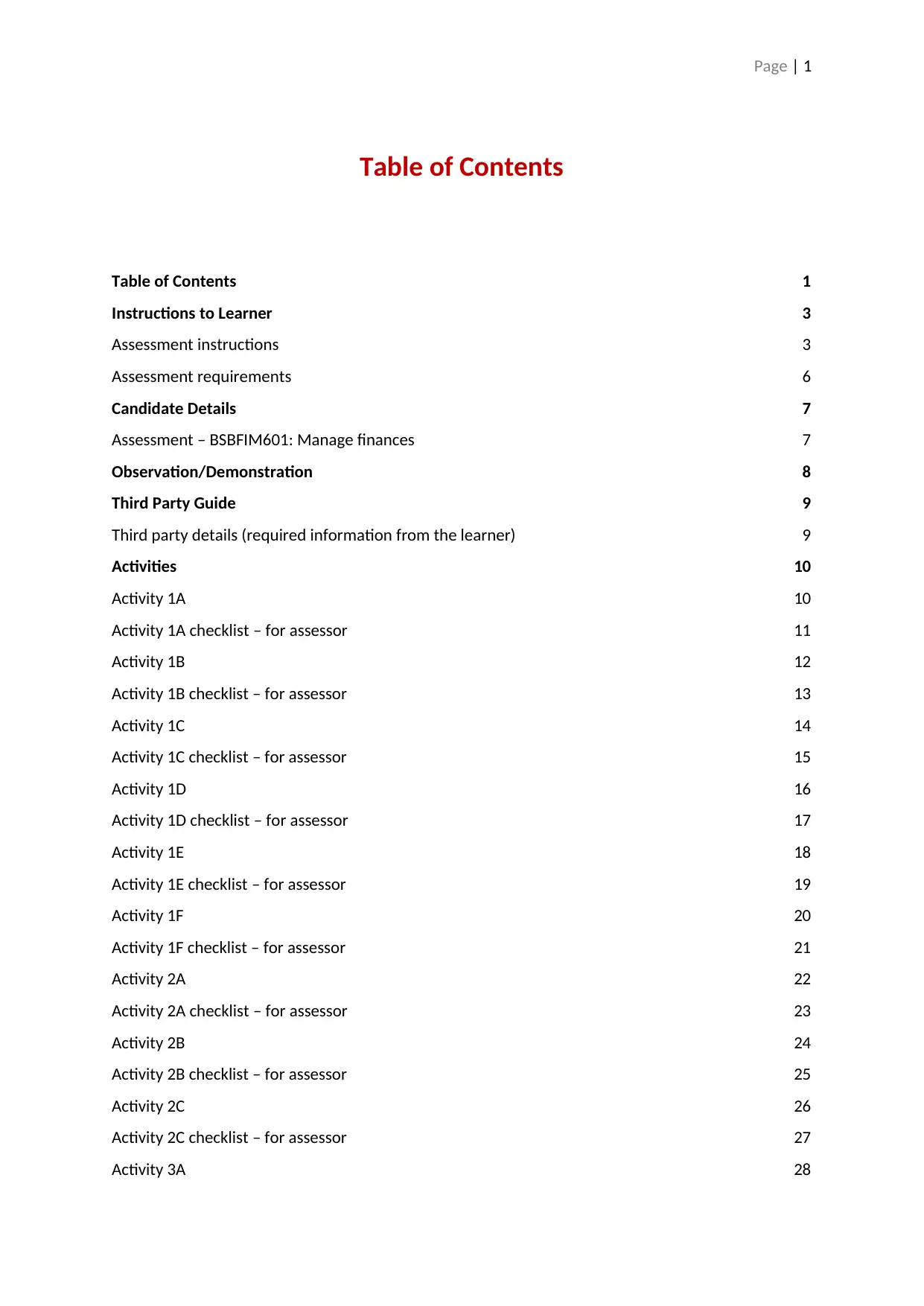
Page | 1
Table of Contents
Table of Contents 1
Instructions to Learner 3
Assessment instructions 3
Assessment requirements 6
Candidate Details 7
Assessment – BSBFIM601: Manage finances 7
Observation/Demonstration 8
Third Party Guide 9
Third party details (required information from the learner) 9
Activities 10
Activity 1A 10
Activity 1A checklist – for assessor 11
Activity 1B 12
Activity 1B checklist – for assessor 13
Activity 1C 14
Activity 1C checklist – for assessor 15
Activity 1D 16
Activity 1D checklist – for assessor 17
Activity 1E 18
Activity 1E checklist – for assessor 19
Activity 1F 20
Activity 1F checklist – for assessor 21
Activity 2A 22
Activity 2A checklist – for assessor 23
Activity 2B 24
Activity 2B checklist – for assessor 25
Activity 2C 26
Activity 2C checklist – for assessor 27
Activity 3A 28
Table of Contents
Table of Contents 1
Instructions to Learner 3
Assessment instructions 3
Assessment requirements 6
Candidate Details 7
Assessment – BSBFIM601: Manage finances 7
Observation/Demonstration 8
Third Party Guide 9
Third party details (required information from the learner) 9
Activities 10
Activity 1A 10
Activity 1A checklist – for assessor 11
Activity 1B 12
Activity 1B checklist – for assessor 13
Activity 1C 14
Activity 1C checklist – for assessor 15
Activity 1D 16
Activity 1D checklist – for assessor 17
Activity 1E 18
Activity 1E checklist – for assessor 19
Activity 1F 20
Activity 1F checklist – for assessor 21
Activity 2A 22
Activity 2A checklist – for assessor 23
Activity 2B 24
Activity 2B checklist – for assessor 25
Activity 2C 26
Activity 2C checklist – for assessor 27
Activity 3A 28
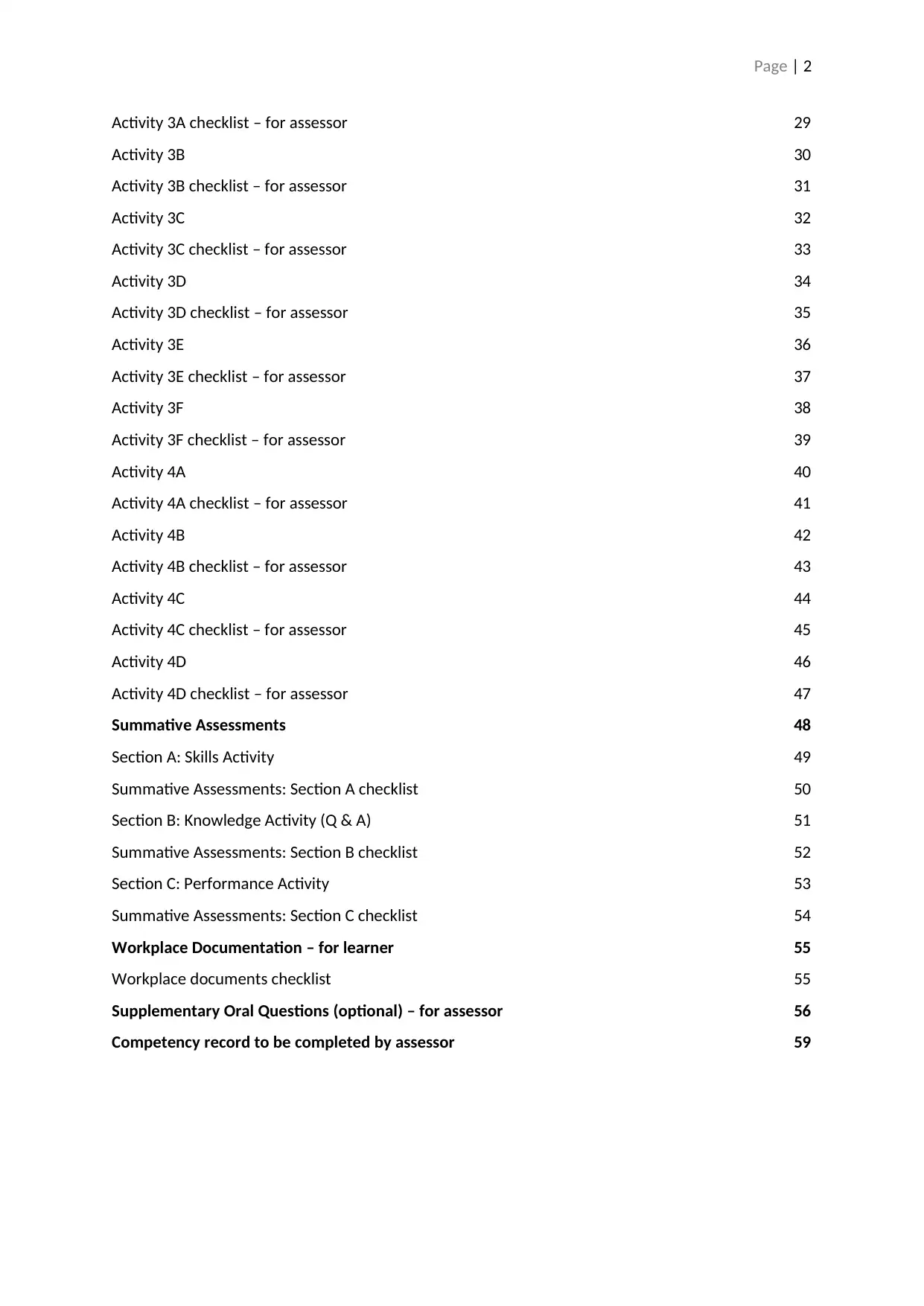
Page | 2
Activity 3A checklist – for assessor 29
Activity 3B 30
Activity 3B checklist – for assessor 31
Activity 3C 32
Activity 3C checklist – for assessor 33
Activity 3D 34
Activity 3D checklist – for assessor 35
Activity 3E 36
Activity 3E checklist – for assessor 37
Activity 3F 38
Activity 3F checklist – for assessor 39
Activity 4A 40
Activity 4A checklist – for assessor 41
Activity 4B 42
Activity 4B checklist – for assessor 43
Activity 4C 44
Activity 4C checklist – for assessor 45
Activity 4D 46
Activity 4D checklist – for assessor 47
Summative Assessments 48
Section A: Skills Activity 49
Summative Assessments: Section A checklist 50
Section B: Knowledge Activity (Q & A) 51
Summative Assessments: Section B checklist 52
Section C: Performance Activity 53
Summative Assessments: Section C checklist 54
Workplace Documentation – for learner 55
Workplace documents checklist 55
Supplementary Oral Questions (optional) – for assessor 56
Competency record to be completed by assessor 59
Activity 3A checklist – for assessor 29
Activity 3B 30
Activity 3B checklist – for assessor 31
Activity 3C 32
Activity 3C checklist – for assessor 33
Activity 3D 34
Activity 3D checklist – for assessor 35
Activity 3E 36
Activity 3E checklist – for assessor 37
Activity 3F 38
Activity 3F checklist – for assessor 39
Activity 4A 40
Activity 4A checklist – for assessor 41
Activity 4B 42
Activity 4B checklist – for assessor 43
Activity 4C 44
Activity 4C checklist – for assessor 45
Activity 4D 46
Activity 4D checklist – for assessor 47
Summative Assessments 48
Section A: Skills Activity 49
Summative Assessments: Section A checklist 50
Section B: Knowledge Activity (Q & A) 51
Summative Assessments: Section B checklist 52
Section C: Performance Activity 53
Summative Assessments: Section C checklist 54
Workplace Documentation – for learner 55
Workplace documents checklist 55
Supplementary Oral Questions (optional) – for assessor 56
Competency record to be completed by assessor 59
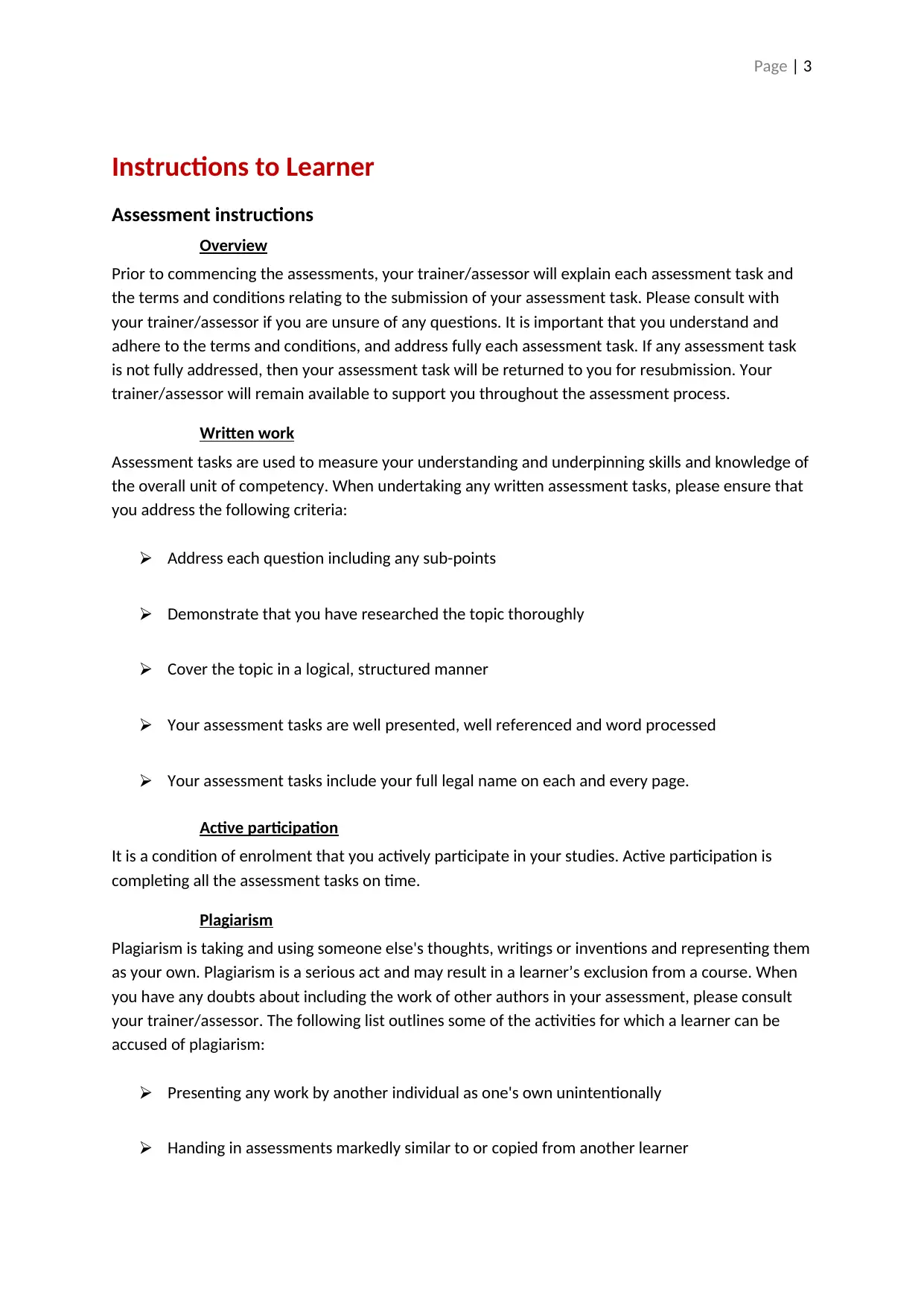
Page | 3
Instructions to Learner
Assessment instructions
Overview
Prior to commencing the assessments, your trainer/assessor will explain each assessment task and
the terms and conditions relating to the submission of your assessment task. Please consult with
your trainer/assessor if you are unsure of any questions. It is important that you understand and
adhere to the terms and conditions, and address fully each assessment task. If any assessment task
is not fully addressed, then your assessment task will be returned to you for resubmission. Your
trainer/assessor will remain available to support you throughout the assessment process.
Written work
Assessment tasks are used to measure your understanding and underpinning skills and knowledge of
the overall unit of competency. When undertaking any written assessment tasks, please ensure that
you address the following criteria:
⮚ Address each question including any sub-points
⮚ Demonstrate that you have researched the topic thoroughly
⮚ Cover the topic in a logical, structured manner
⮚ Your assessment tasks are well presented, well referenced and word processed
⮚ Your assessment tasks include your full legal name on each and every page.
Active participation
It is a condition of enrolment that you actively participate in your studies. Active participation is
completing all the assessment tasks on time.
Plagiarism
Plagiarism is taking and using someone else's thoughts, writings or inventions and representing them
as your own. Plagiarism is a serious act and may result in a learner’s exclusion from a course. When
you have any doubts about including the work of other authors in your assessment, please consult
your trainer/assessor. The following list outlines some of the activities for which a learner can be
accused of plagiarism:
⮚ Presenting any work by another individual as one's own unintentionally
⮚ Handing in assessments markedly similar to or copied from another learner
Instructions to Learner
Assessment instructions
Overview
Prior to commencing the assessments, your trainer/assessor will explain each assessment task and
the terms and conditions relating to the submission of your assessment task. Please consult with
your trainer/assessor if you are unsure of any questions. It is important that you understand and
adhere to the terms and conditions, and address fully each assessment task. If any assessment task
is not fully addressed, then your assessment task will be returned to you for resubmission. Your
trainer/assessor will remain available to support you throughout the assessment process.
Written work
Assessment tasks are used to measure your understanding and underpinning skills and knowledge of
the overall unit of competency. When undertaking any written assessment tasks, please ensure that
you address the following criteria:
⮚ Address each question including any sub-points
⮚ Demonstrate that you have researched the topic thoroughly
⮚ Cover the topic in a logical, structured manner
⮚ Your assessment tasks are well presented, well referenced and word processed
⮚ Your assessment tasks include your full legal name on each and every page.
Active participation
It is a condition of enrolment that you actively participate in your studies. Active participation is
completing all the assessment tasks on time.
Plagiarism
Plagiarism is taking and using someone else's thoughts, writings or inventions and representing them
as your own. Plagiarism is a serious act and may result in a learner’s exclusion from a course. When
you have any doubts about including the work of other authors in your assessment, please consult
your trainer/assessor. The following list outlines some of the activities for which a learner can be
accused of plagiarism:
⮚ Presenting any work by another individual as one's own unintentionally
⮚ Handing in assessments markedly similar to or copied from another learner
Secure Best Marks with AI Grader
Need help grading? Try our AI Grader for instant feedback on your assignments.

Page | 4
⮚ Presenting the work of another individual or group as their own work
⮚ Handing in assessments without the adequate acknowledgement of sources used, including
assessments taken totally or in part from the internet.
If it is identified that you have plagiarised within your assessment, then a meeting will be organised
to discuss this with you, and further action may be taken accordingly.
Collusion
Collusion is the presentation by a learner of an assignment as their own that is, in fact, the result in
whole or in part of unauthorised collaboration with another person or persons. Collusion involves
the cooperation of two or more learners in plagiarism or other forms of academic misconduct and,
as such, both parties are subject to disciplinary action. Collusion or copying from other learners is
not permitted and will result in a “0” grade and NYC.
Assessments must be typed using document software such as (or similar to) MS Office. Handwritten
assessments will not be accepted (unless, prior written confirmation is provided by the
trainer/assessor to confirm).
Competency outcome
There are two outcomes of assessments: S = Satisfactory and NS = Not Satisfactory (requires more
training and experience).
Once the learner has satisfactorily completed all the tasks for this module the learner will be
awarded “Competent” (C) or “Not yet Competent” (NYC) for the relevant unit of competency.
If you are deemed “Not Yet Competent” you will be provided with feedback from your assessor and
will be given another chance to resubmit your assessment task(s). If you are still deemed as “Not Yet
Competent” you will be required to re-enrol in the unit of competency.
Additional evidence
If we, at our sole discretion, determine that we require additional or alternative
information/evidence in order to determine competency, you must provide us with such
information/evidence, subject to privacy and confidentiality issues. We retain this right at any time,
including after submission of your assessments.
Confidentiality
We will treat anything, including information about your job, workplace, employer, with strict
confidence, in accordance with the law. However, you are responsible for ensuring that you do not
provide us with anything regarding any third party including your employer, colleagues and others,
that they do not consent to the disclosure of. While we may ask you to provide information or
details about aspects of your employer and workplace, you are responsible for obtaining necessary
consents and ensuring that privacy rights and confidentiality obligations are not breached by you in
supplying us with such information.
⮚ Presenting the work of another individual or group as their own work
⮚ Handing in assessments without the adequate acknowledgement of sources used, including
assessments taken totally or in part from the internet.
If it is identified that you have plagiarised within your assessment, then a meeting will be organised
to discuss this with you, and further action may be taken accordingly.
Collusion
Collusion is the presentation by a learner of an assignment as their own that is, in fact, the result in
whole or in part of unauthorised collaboration with another person or persons. Collusion involves
the cooperation of two or more learners in plagiarism or other forms of academic misconduct and,
as such, both parties are subject to disciplinary action. Collusion or copying from other learners is
not permitted and will result in a “0” grade and NYC.
Assessments must be typed using document software such as (or similar to) MS Office. Handwritten
assessments will not be accepted (unless, prior written confirmation is provided by the
trainer/assessor to confirm).
Competency outcome
There are two outcomes of assessments: S = Satisfactory and NS = Not Satisfactory (requires more
training and experience).
Once the learner has satisfactorily completed all the tasks for this module the learner will be
awarded “Competent” (C) or “Not yet Competent” (NYC) for the relevant unit of competency.
If you are deemed “Not Yet Competent” you will be provided with feedback from your assessor and
will be given another chance to resubmit your assessment task(s). If you are still deemed as “Not Yet
Competent” you will be required to re-enrol in the unit of competency.
Additional evidence
If we, at our sole discretion, determine that we require additional or alternative
information/evidence in order to determine competency, you must provide us with such
information/evidence, subject to privacy and confidentiality issues. We retain this right at any time,
including after submission of your assessments.
Confidentiality
We will treat anything, including information about your job, workplace, employer, with strict
confidence, in accordance with the law. However, you are responsible for ensuring that you do not
provide us with anything regarding any third party including your employer, colleagues and others,
that they do not consent to the disclosure of. While we may ask you to provide information or
details about aspects of your employer and workplace, you are responsible for obtaining necessary
consents and ensuring that privacy rights and confidentiality obligations are not breached by you in
supplying us with such information.

Page | 5
Assessment appeals process
If you feel that you have been unfairly treated during your assessment, and you are not happy with
your assessment and/or the outcome as a result of that treatment, you have the right to lodge an
appeal. You must first discuss the issue with your trainer/assessor. If you would like to proceed
further with the request after discussions with your trainer/assessor, you need to lodge your appeal
to the course coordinator, in writing, outlining the reason(s) for the appeal.
Recognised prior learning
Candidates will be able to have their previous experience or expertise recognised on request.
Special needs
Candidates with special needs should notify their trainer/assessor to request any required
adjustments as soon as possible. This will enable the trainer/assessor to address the identified needs
immediately.
Assessment appeals process
If you feel that you have been unfairly treated during your assessment, and you are not happy with
your assessment and/or the outcome as a result of that treatment, you have the right to lodge an
appeal. You must first discuss the issue with your trainer/assessor. If you would like to proceed
further with the request after discussions with your trainer/assessor, you need to lodge your appeal
to the course coordinator, in writing, outlining the reason(s) for the appeal.
Recognised prior learning
Candidates will be able to have their previous experience or expertise recognised on request.
Special needs
Candidates with special needs should notify their trainer/assessor to request any required
adjustments as soon as possible. This will enable the trainer/assessor to address the identified needs
immediately.
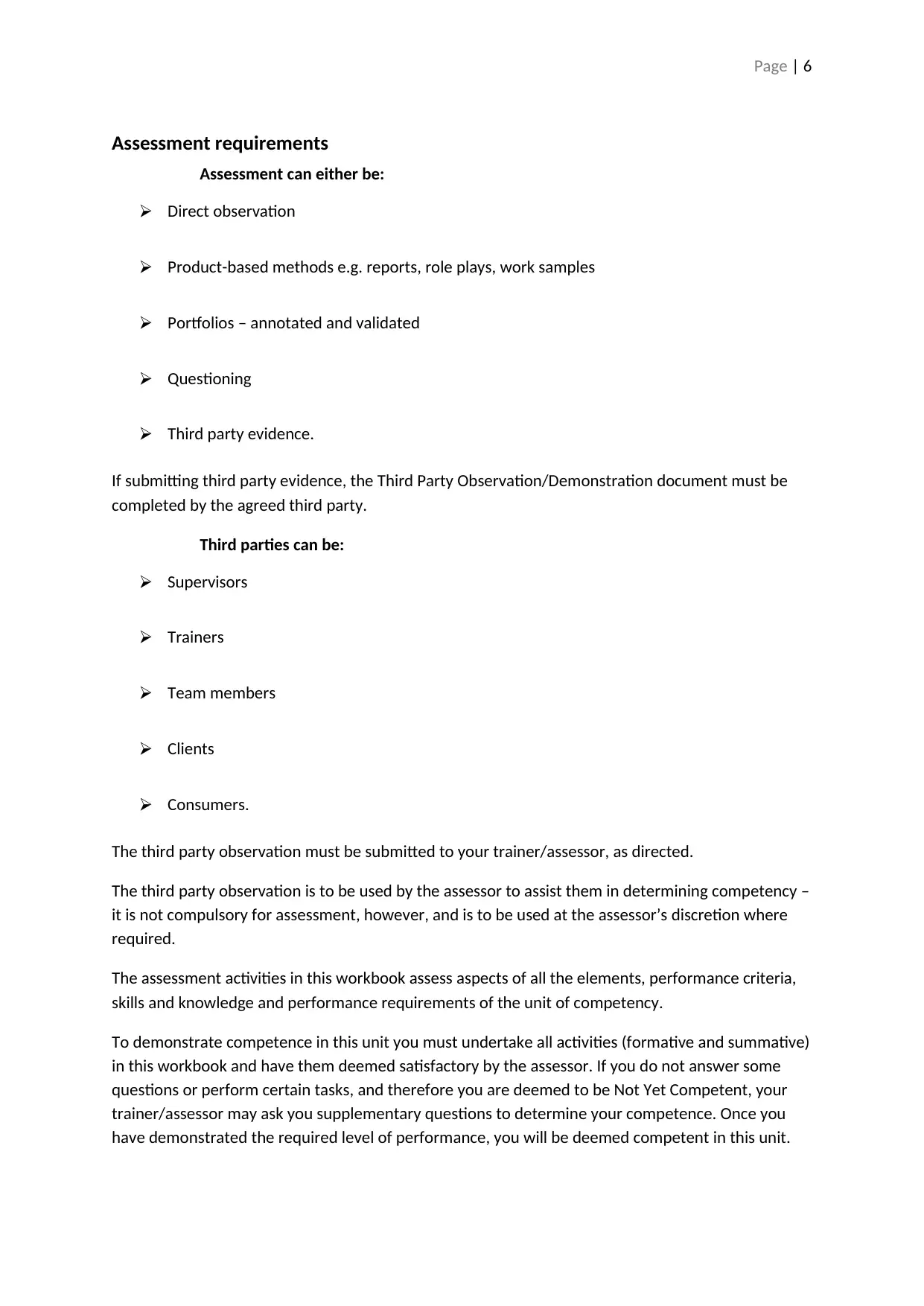
Page | 6
Assessment requirements
Assessment can either be:
⮚ Direct observation
⮚ Product-based methods e.g. reports, role plays, work samples
⮚ Portfolios – annotated and validated
⮚ Questioning
⮚ Third party evidence.
If submitting third party evidence, the Third Party Observation/Demonstration document must be
completed by the agreed third party.
Third parties can be:
⮚ Supervisors
⮚ Trainers
⮚ Team members
⮚ Clients
⮚ Consumers.
The third party observation must be submitted to your trainer/assessor, as directed.
The third party observation is to be used by the assessor to assist them in determining competency –
it is not compulsory for assessment, however, and is to be used at the assessor’s discretion where
required.
The assessment activities in this workbook assess aspects of all the elements, performance criteria,
skills and knowledge and performance requirements of the unit of competency.
To demonstrate competence in this unit you must undertake all activities (formative and summative)
in this workbook and have them deemed satisfactory by the assessor. If you do not answer some
questions or perform certain tasks, and therefore you are deemed to be Not Yet Competent, your
trainer/assessor may ask you supplementary questions to determine your competence. Once you
have demonstrated the required level of performance, you will be deemed competent in this unit.
Assessment requirements
Assessment can either be:
⮚ Direct observation
⮚ Product-based methods e.g. reports, role plays, work samples
⮚ Portfolios – annotated and validated
⮚ Questioning
⮚ Third party evidence.
If submitting third party evidence, the Third Party Observation/Demonstration document must be
completed by the agreed third party.
Third parties can be:
⮚ Supervisors
⮚ Trainers
⮚ Team members
⮚ Clients
⮚ Consumers.
The third party observation must be submitted to your trainer/assessor, as directed.
The third party observation is to be used by the assessor to assist them in determining competency –
it is not compulsory for assessment, however, and is to be used at the assessor’s discretion where
required.
The assessment activities in this workbook assess aspects of all the elements, performance criteria,
skills and knowledge and performance requirements of the unit of competency.
To demonstrate competence in this unit you must undertake all activities (formative and summative)
in this workbook and have them deemed satisfactory by the assessor. If you do not answer some
questions or perform certain tasks, and therefore you are deemed to be Not Yet Competent, your
trainer/assessor may ask you supplementary questions to determine your competence. Once you
have demonstrated the required level of performance, you will be deemed competent in this unit.
Paraphrase This Document
Need a fresh take? Get an instant paraphrase of this document with our AI Paraphraser
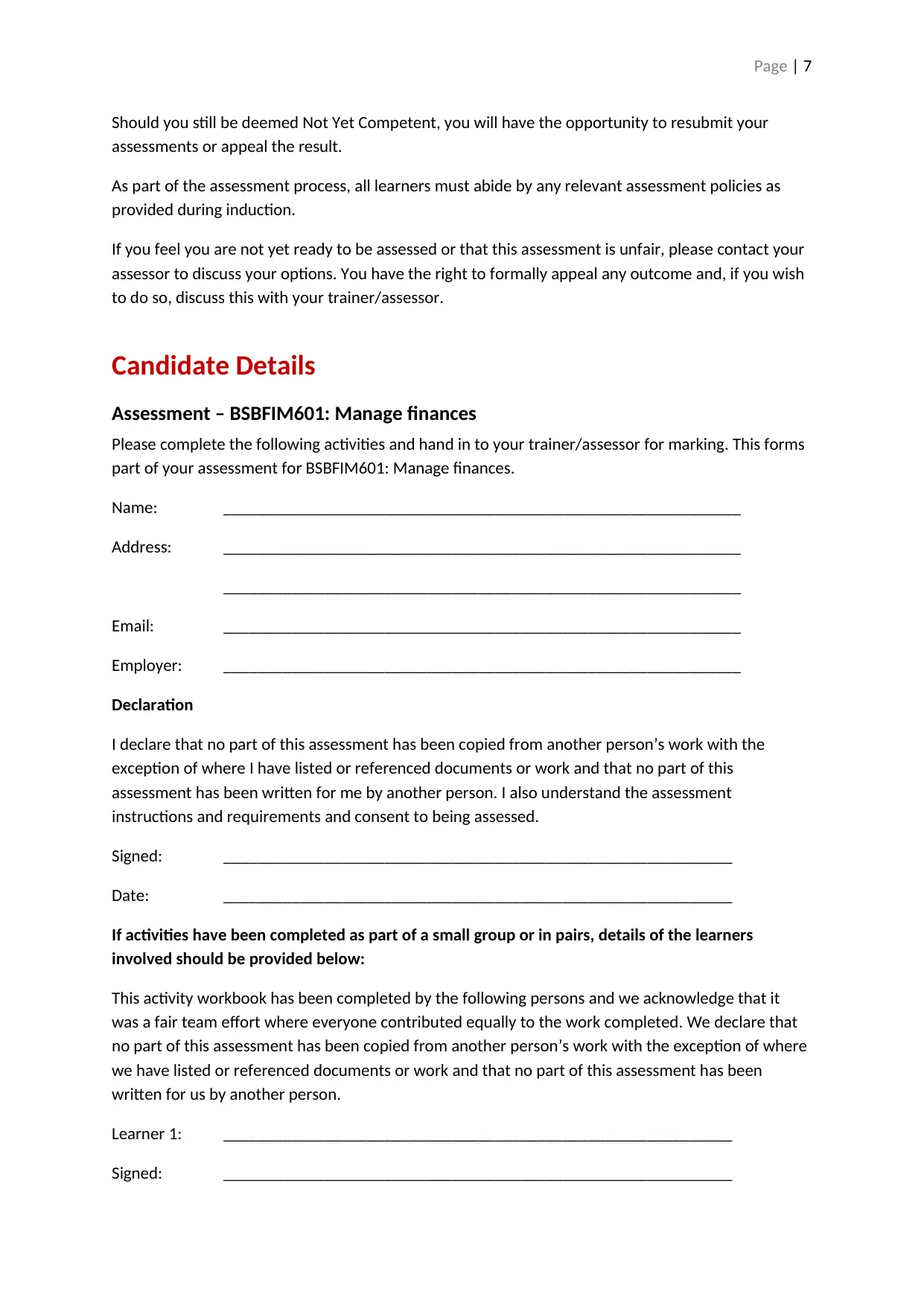
Page | 7
Should you still be deemed Not Yet Competent, you will have the opportunity to resubmit your
assessments or appeal the result.
As part of the assessment process, all learners must abide by any relevant assessment policies as
provided during induction.
If you feel you are not yet ready to be assessed or that this assessment is unfair, please contact your
assessor to discuss your options. You have the right to formally appeal any outcome and, if you wish
to do so, discuss this with your trainer/assessor.
Candidate Details
Assessment – BSBFIM601: Manage finances
Please complete the following activities and hand in to your trainer/assessor for marking. This forms
part of your assessment for BSBFIM601: Manage finances.
Name: _____________________________________________________________
Address: _____________________________________________________________
_____________________________________________________________
Email: _____________________________________________________________
Employer: _____________________________________________________________
Declaration
I declare that no part of this assessment has been copied from another person’s work with the
exception of where I have listed or referenced documents or work and that no part of this
assessment has been written for me by another person. I also understand the assessment
instructions and requirements and consent to being assessed.
Signed: ____________________________________________________________
Date: ____________________________________________________________
If activities have been completed as part of a small group or in pairs, details of the learners
involved should be provided below:
This activity workbook has been completed by the following persons and we acknowledge that it
was a fair team effort where everyone contributed equally to the work completed. We declare that
no part of this assessment has been copied from another person’s work with the exception of where
we have listed or referenced documents or work and that no part of this assessment has been
written for us by another person.
Learner 1: ____________________________________________________________
Signed: ____________________________________________________________
Should you still be deemed Not Yet Competent, you will have the opportunity to resubmit your
assessments or appeal the result.
As part of the assessment process, all learners must abide by any relevant assessment policies as
provided during induction.
If you feel you are not yet ready to be assessed or that this assessment is unfair, please contact your
assessor to discuss your options. You have the right to formally appeal any outcome and, if you wish
to do so, discuss this with your trainer/assessor.
Candidate Details
Assessment – BSBFIM601: Manage finances
Please complete the following activities and hand in to your trainer/assessor for marking. This forms
part of your assessment for BSBFIM601: Manage finances.
Name: _____________________________________________________________
Address: _____________________________________________________________
_____________________________________________________________
Email: _____________________________________________________________
Employer: _____________________________________________________________
Declaration
I declare that no part of this assessment has been copied from another person’s work with the
exception of where I have listed or referenced documents or work and that no part of this
assessment has been written for me by another person. I also understand the assessment
instructions and requirements and consent to being assessed.
Signed: ____________________________________________________________
Date: ____________________________________________________________
If activities have been completed as part of a small group or in pairs, details of the learners
involved should be provided below:
This activity workbook has been completed by the following persons and we acknowledge that it
was a fair team effort where everyone contributed equally to the work completed. We declare that
no part of this assessment has been copied from another person’s work with the exception of where
we have listed or referenced documents or work and that no part of this assessment has been
written for us by another person.
Learner 1: ____________________________________________________________
Signed: ____________________________________________________________

Page | 8
Learner 2: ____________________________________________________________
Signed: ____________________________________________________________
Learner 3: ____________________________________________________________
Signed: ____________________________________________________________
Learner 2: ____________________________________________________________
Signed: ____________________________________________________________
Learner 3: ____________________________________________________________
Signed: ____________________________________________________________
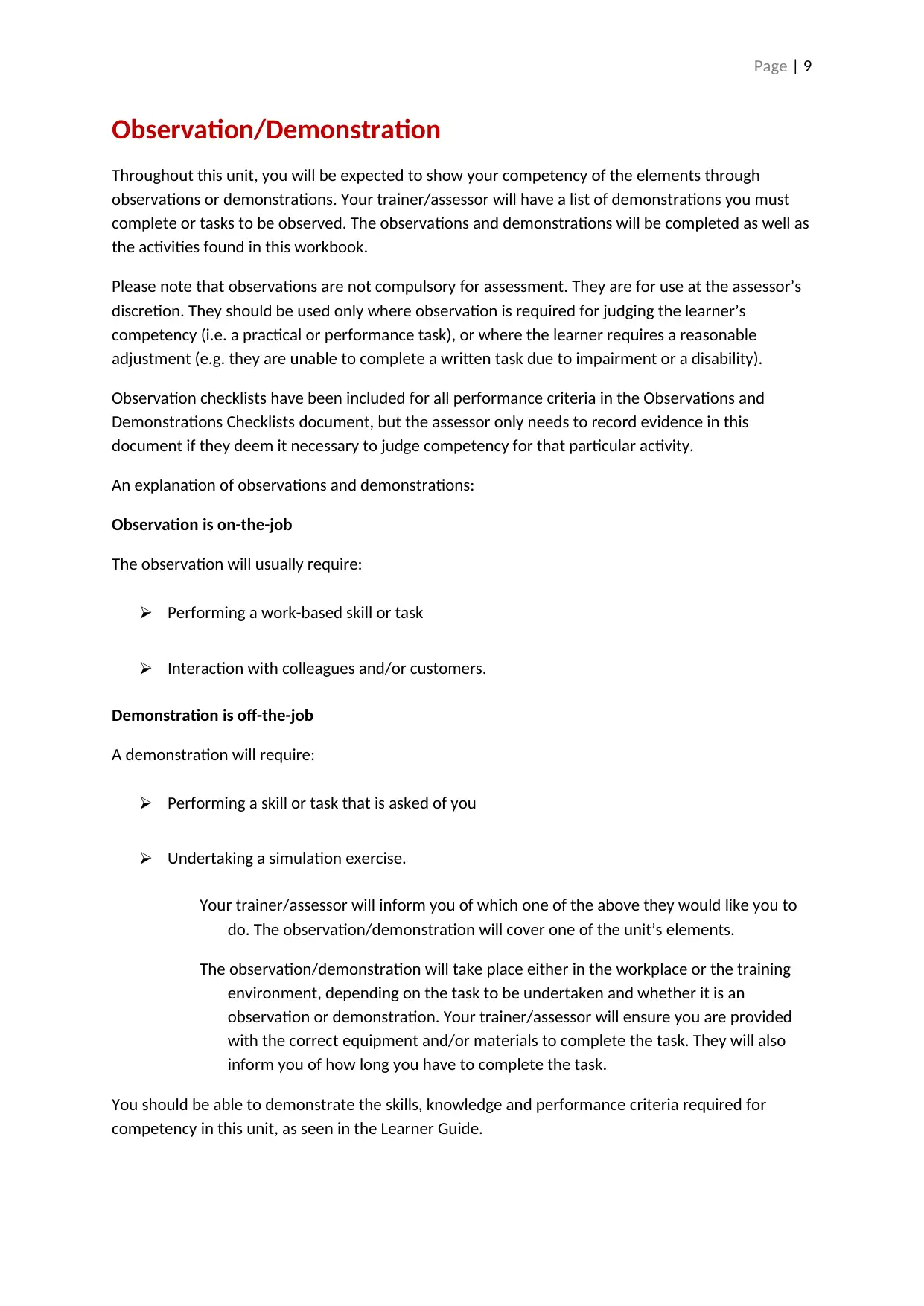
Page | 9
Observation/Demonstration
Throughout this unit, you will be expected to show your competency of the elements through
observations or demonstrations. Your trainer/assessor will have a list of demonstrations you must
complete or tasks to be observed. The observations and demonstrations will be completed as well as
the activities found in this workbook.
Please note that observations are not compulsory for assessment. They are for use at the assessor’s
discretion. They should be used only where observation is required for judging the learner’s
competency (i.e. a practical or performance task), or where the learner requires a reasonable
adjustment (e.g. they are unable to complete a written task due to impairment or a disability).
Observation checklists have been included for all performance criteria in the Observations and
Demonstrations Checklists document, but the assessor only needs to record evidence in this
document if they deem it necessary to judge competency for that particular activity.
An explanation of observations and demonstrations:
Observation is on-the-job
The observation will usually require:
⮚ Performing a work-based skill or task
⮚ Interaction with colleagues and/or customers.
Demonstration is off-the-job
A demonstration will require:
⮚ Performing a skill or task that is asked of you
⮚ Undertaking a simulation exercise.
Your trainer/assessor will inform you of which one of the above they would like you to
do. The observation/demonstration will cover one of the unit’s elements.
The observation/demonstration will take place either in the workplace or the training
environment, depending on the task to be undertaken and whether it is an
observation or demonstration. Your trainer/assessor will ensure you are provided
with the correct equipment and/or materials to complete the task. They will also
inform you of how long you have to complete the task.
You should be able to demonstrate the skills, knowledge and performance criteria required for
competency in this unit, as seen in the Learner Guide.
Observation/Demonstration
Throughout this unit, you will be expected to show your competency of the elements through
observations or demonstrations. Your trainer/assessor will have a list of demonstrations you must
complete or tasks to be observed. The observations and demonstrations will be completed as well as
the activities found in this workbook.
Please note that observations are not compulsory for assessment. They are for use at the assessor’s
discretion. They should be used only where observation is required for judging the learner’s
competency (i.e. a practical or performance task), or where the learner requires a reasonable
adjustment (e.g. they are unable to complete a written task due to impairment or a disability).
Observation checklists have been included for all performance criteria in the Observations and
Demonstrations Checklists document, but the assessor only needs to record evidence in this
document if they deem it necessary to judge competency for that particular activity.
An explanation of observations and demonstrations:
Observation is on-the-job
The observation will usually require:
⮚ Performing a work-based skill or task
⮚ Interaction with colleagues and/or customers.
Demonstration is off-the-job
A demonstration will require:
⮚ Performing a skill or task that is asked of you
⮚ Undertaking a simulation exercise.
Your trainer/assessor will inform you of which one of the above they would like you to
do. The observation/demonstration will cover one of the unit’s elements.
The observation/demonstration will take place either in the workplace or the training
environment, depending on the task to be undertaken and whether it is an
observation or demonstration. Your trainer/assessor will ensure you are provided
with the correct equipment and/or materials to complete the task. They will also
inform you of how long you have to complete the task.
You should be able to demonstrate the skills, knowledge and performance criteria required for
competency in this unit, as seen in the Learner Guide.
Secure Best Marks with AI Grader
Need help grading? Try our AI Grader for instant feedback on your assignments.
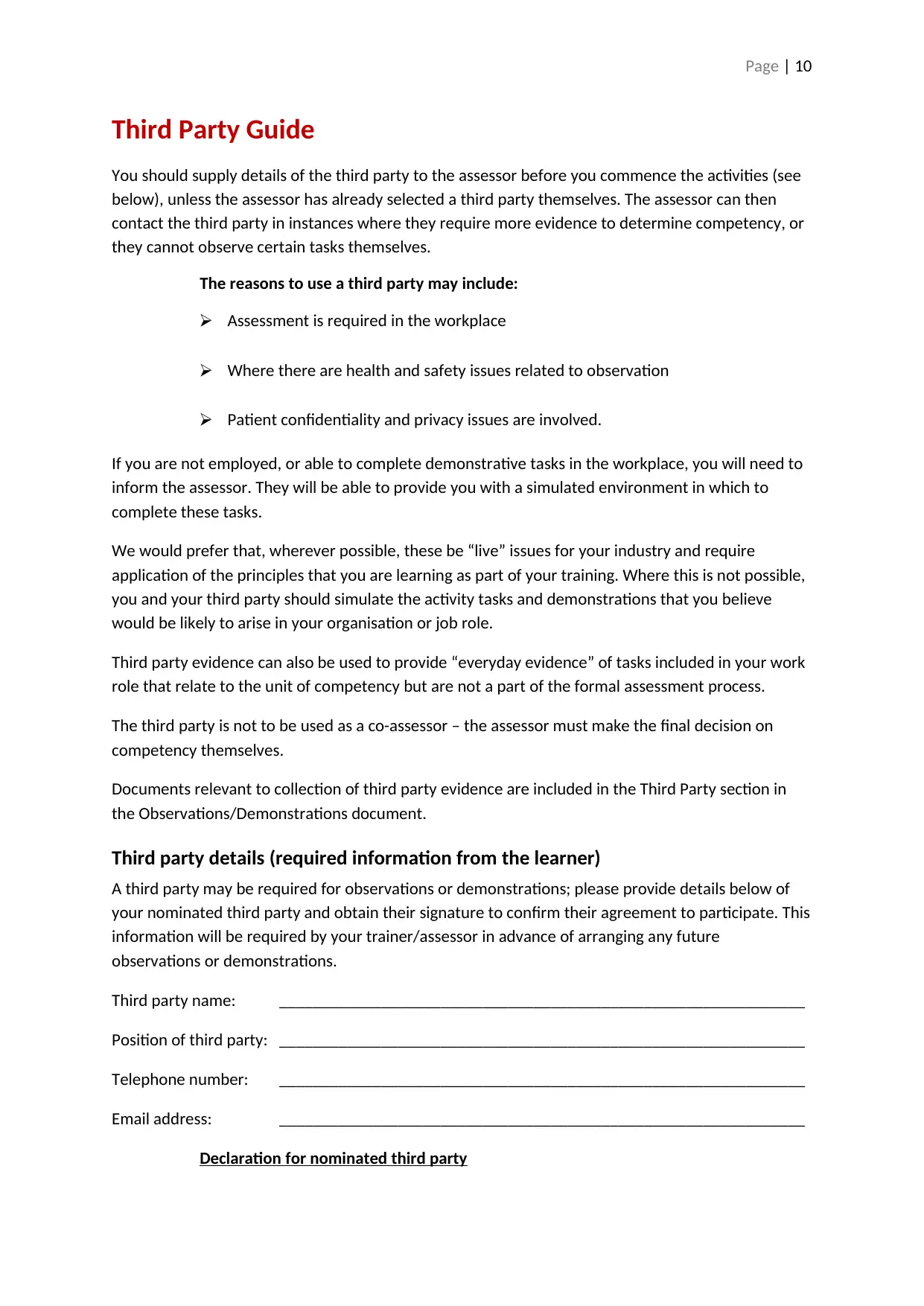
Page | 10
Third Party Guide
You should supply details of the third party to the assessor before you commence the activities (see
below), unless the assessor has already selected a third party themselves. The assessor can then
contact the third party in instances where they require more evidence to determine competency, or
they cannot observe certain tasks themselves.
The reasons to use a third party may include:
⮚ Assessment is required in the workplace
⮚ Where there are health and safety issues related to observation
⮚ Patient confidentiality and privacy issues are involved.
If you are not employed, or able to complete demonstrative tasks in the workplace, you will need to
inform the assessor. They will be able to provide you with a simulated environment in which to
complete these tasks.
We would prefer that, wherever possible, these be “live” issues for your industry and require
application of the principles that you are learning as part of your training. Where this is not possible,
you and your third party should simulate the activity tasks and demonstrations that you believe
would be likely to arise in your organisation or job role.
Third party evidence can also be used to provide “everyday evidence” of tasks included in your work
role that relate to the unit of competency but are not a part of the formal assessment process.
The third party is not to be used as a co-assessor – the assessor must make the final decision on
competency themselves.
Documents relevant to collection of third party evidence are included in the Third Party section in
the Observations/Demonstrations document.
Third party details (required information from the learner)
A third party may be required for observations or demonstrations; please provide details below of
your nominated third party and obtain their signature to confirm their agreement to participate. This
information will be required by your trainer/assessor in advance of arranging any future
observations or demonstrations.
Third party name: ______________________________________________________________
Position of third party: ______________________________________________________________
Telephone number: ______________________________________________________________
Email address: ______________________________________________________________
Declaration for nominated third party
Third Party Guide
You should supply details of the third party to the assessor before you commence the activities (see
below), unless the assessor has already selected a third party themselves. The assessor can then
contact the third party in instances where they require more evidence to determine competency, or
they cannot observe certain tasks themselves.
The reasons to use a third party may include:
⮚ Assessment is required in the workplace
⮚ Where there are health and safety issues related to observation
⮚ Patient confidentiality and privacy issues are involved.
If you are not employed, or able to complete demonstrative tasks in the workplace, you will need to
inform the assessor. They will be able to provide you with a simulated environment in which to
complete these tasks.
We would prefer that, wherever possible, these be “live” issues for your industry and require
application of the principles that you are learning as part of your training. Where this is not possible,
you and your third party should simulate the activity tasks and demonstrations that you believe
would be likely to arise in your organisation or job role.
Third party evidence can also be used to provide “everyday evidence” of tasks included in your work
role that relate to the unit of competency but are not a part of the formal assessment process.
The third party is not to be used as a co-assessor – the assessor must make the final decision on
competency themselves.
Documents relevant to collection of third party evidence are included in the Third Party section in
the Observations/Demonstrations document.
Third party details (required information from the learner)
A third party may be required for observations or demonstrations; please provide details below of
your nominated third party and obtain their signature to confirm their agreement to participate. This
information will be required by your trainer/assessor in advance of arranging any future
observations or demonstrations.
Third party name: ______________________________________________________________
Position of third party: ______________________________________________________________
Telephone number: ______________________________________________________________
Email address: ______________________________________________________________
Declaration for nominated third party
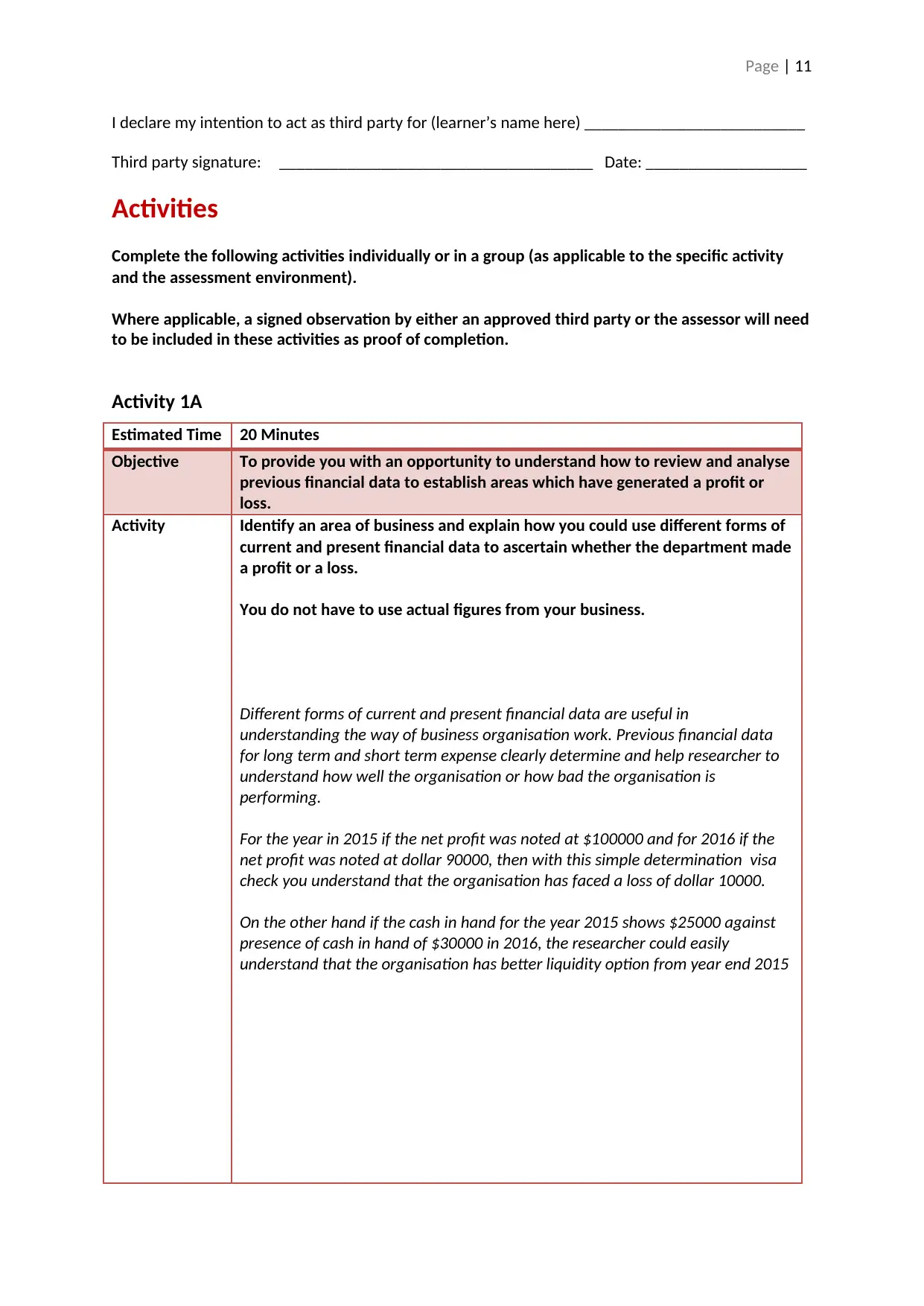
Page | 11
I declare my intention to act as third party for (learner’s name here) __________________________
Third party signature: _____________________________________ Date: ___________________
Activities
Complete the following activities individually or in a group (as applicable to the specific activity
and the assessment environment).
Where applicable, a signed observation by either an approved third party or the assessor will need
to be included in these activities as proof of completion.
Activity 1A
Estimated Time 20 Minutes
Objective To provide you with an opportunity to understand how to review and analyse
previous financial data to establish areas which have generated a profit or
loss.
Activity Identify an area of business and explain how you could use different forms of
current and present financial data to ascertain whether the department made
a profit or a loss.
You do not have to use actual figures from your business.
Different forms of current and present financial data are useful in
understanding the way of business organisation work. Previous financial data
for long term and short term expense clearly determine and help researcher to
understand how well the organisation or how bad the organisation is
performing.
For the year in 2015 if the net profit was noted at $100000 and for 2016 if the
net profit was noted at dollar 90000, then with this simple determination visa
check you understand that the organisation has faced a loss of dollar 10000.
On the other hand if the cash in hand for the year 2015 shows $25000 against
presence of cash in hand of $30000 in 2016, the researcher could easily
understand that the organisation has better liquidity option from year end 2015
I declare my intention to act as third party for (learner’s name here) __________________________
Third party signature: _____________________________________ Date: ___________________
Activities
Complete the following activities individually or in a group (as applicable to the specific activity
and the assessment environment).
Where applicable, a signed observation by either an approved third party or the assessor will need
to be included in these activities as proof of completion.
Activity 1A
Estimated Time 20 Minutes
Objective To provide you with an opportunity to understand how to review and analyse
previous financial data to establish areas which have generated a profit or
loss.
Activity Identify an area of business and explain how you could use different forms of
current and present financial data to ascertain whether the department made
a profit or a loss.
You do not have to use actual figures from your business.
Different forms of current and present financial data are useful in
understanding the way of business organisation work. Previous financial data
for long term and short term expense clearly determine and help researcher to
understand how well the organisation or how bad the organisation is
performing.
For the year in 2015 if the net profit was noted at $100000 and for 2016 if the
net profit was noted at dollar 90000, then with this simple determination visa
check you understand that the organisation has faced a loss of dollar 10000.
On the other hand if the cash in hand for the year 2015 shows $25000 against
presence of cash in hand of $30000 in 2016, the researcher could easily
understand that the organisation has better liquidity option from year end 2015
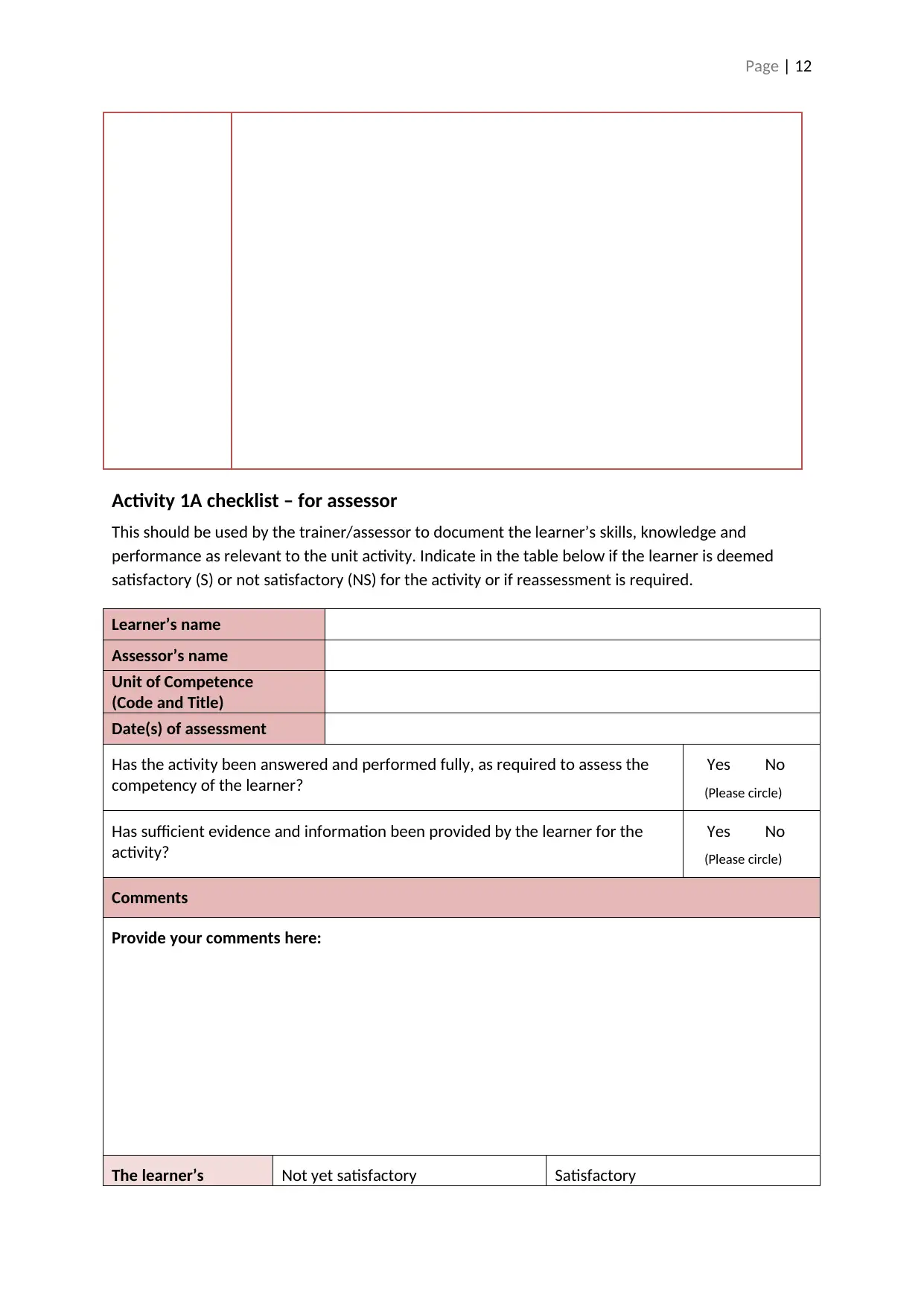
Page | 12
Activity 1A checklist – for assessor
This should be used by the trainer/assessor to document the learner’s skills, knowledge and
performance as relevant to the unit activity. Indicate in the table below if the learner is deemed
satisfactory (S) or not satisfactory (NS) for the activity or if reassessment is required.
Learner’s name
Assessor’s name
Unit of Competence
(Code and Title)
Date(s) of assessment
Has the activity been answered and performed fully, as required to assess the
competency of the learner?
Yes No
(Please circle)
Has sufficient evidence and information been provided by the learner for the
activity?
Yes No
(Please circle)
Comments
Provide your comments here:
The learner’s Not yet satisfactory Satisfactory
Activity 1A checklist – for assessor
This should be used by the trainer/assessor to document the learner’s skills, knowledge and
performance as relevant to the unit activity. Indicate in the table below if the learner is deemed
satisfactory (S) or not satisfactory (NS) for the activity or if reassessment is required.
Learner’s name
Assessor’s name
Unit of Competence
(Code and Title)
Date(s) of assessment
Has the activity been answered and performed fully, as required to assess the
competency of the learner?
Yes No
(Please circle)
Has sufficient evidence and information been provided by the learner for the
activity?
Yes No
(Please circle)
Comments
Provide your comments here:
The learner’s Not yet satisfactory Satisfactory
Paraphrase This Document
Need a fresh take? Get an instant paraphrase of this document with our AI Paraphraser
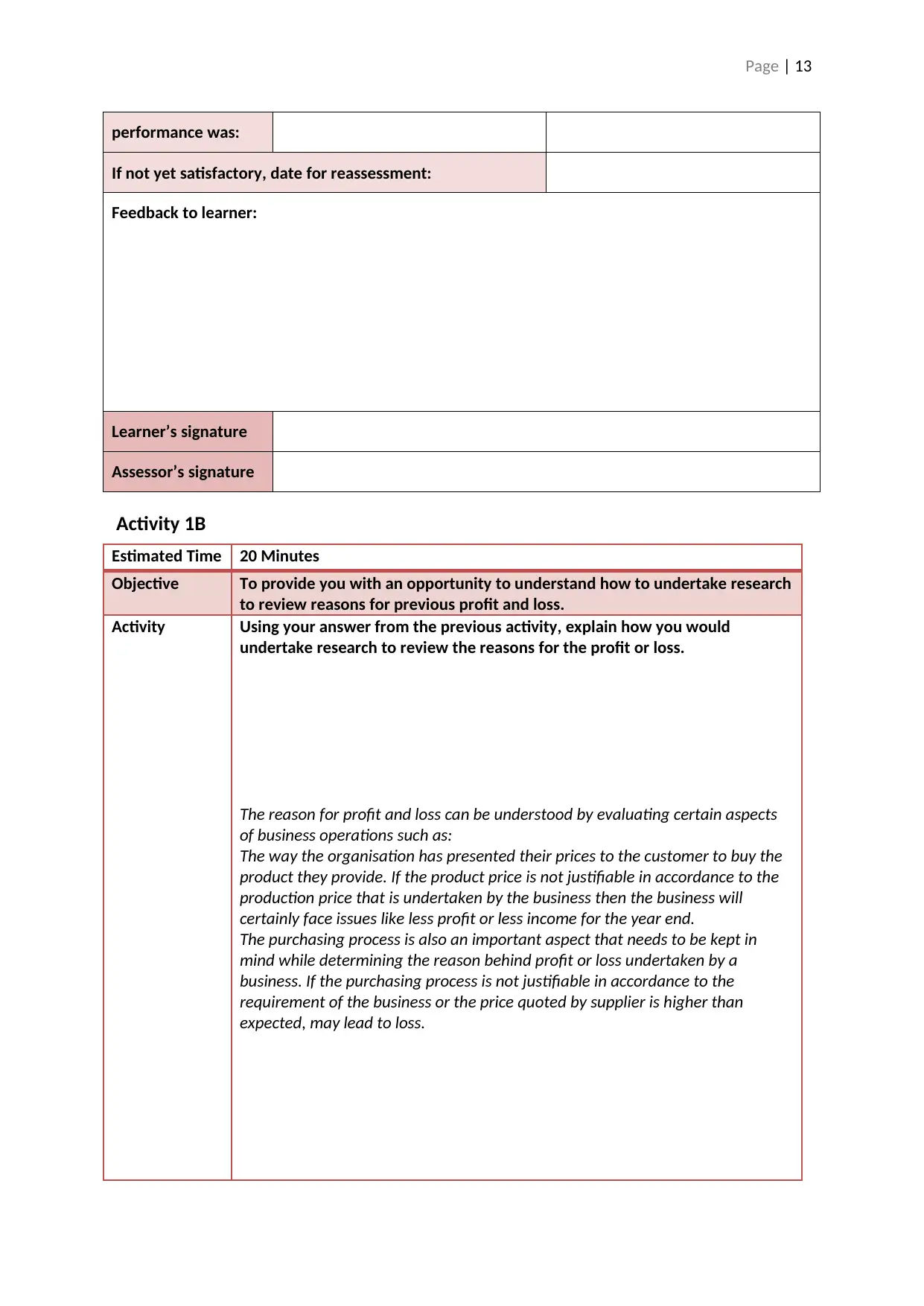
Page | 13
performance was:
If not yet satisfactory, date for reassessment:
Feedback to learner:
Learner’s signature
Assessor’s signature
Activity 1B
Estimated Time 20 Minutes
Objective To provide you with an opportunity to understand how to undertake research
to review reasons for previous profit and loss.
Activity Using your answer from the previous activity, explain how you would
undertake research to review the reasons for the profit or loss.
The reason for profit and loss can be understood by evaluating certain aspects
of business operations such as:
The way the organisation has presented their prices to the customer to buy the
product they provide. If the product price is not justifiable in accordance to the
production price that is undertaken by the business then the business will
certainly face issues like less profit or less income for the year end.
The purchasing process is also an important aspect that needs to be kept in
mind while determining the reason behind profit or loss undertaken by a
business. If the purchasing process is not justifiable in accordance to the
requirement of the business or the price quoted by supplier is higher than
expected, may lead to loss.
performance was:
If not yet satisfactory, date for reassessment:
Feedback to learner:
Learner’s signature
Assessor’s signature
Activity 1B
Estimated Time 20 Minutes
Objective To provide you with an opportunity to understand how to undertake research
to review reasons for previous profit and loss.
Activity Using your answer from the previous activity, explain how you would
undertake research to review the reasons for the profit or loss.
The reason for profit and loss can be understood by evaluating certain aspects
of business operations such as:
The way the organisation has presented their prices to the customer to buy the
product they provide. If the product price is not justifiable in accordance to the
production price that is undertaken by the business then the business will
certainly face issues like less profit or less income for the year end.
The purchasing process is also an important aspect that needs to be kept in
mind while determining the reason behind profit or loss undertaken by a
business. If the purchasing process is not justifiable in accordance to the
requirement of the business or the price quoted by supplier is higher than
expected, may lead to loss.
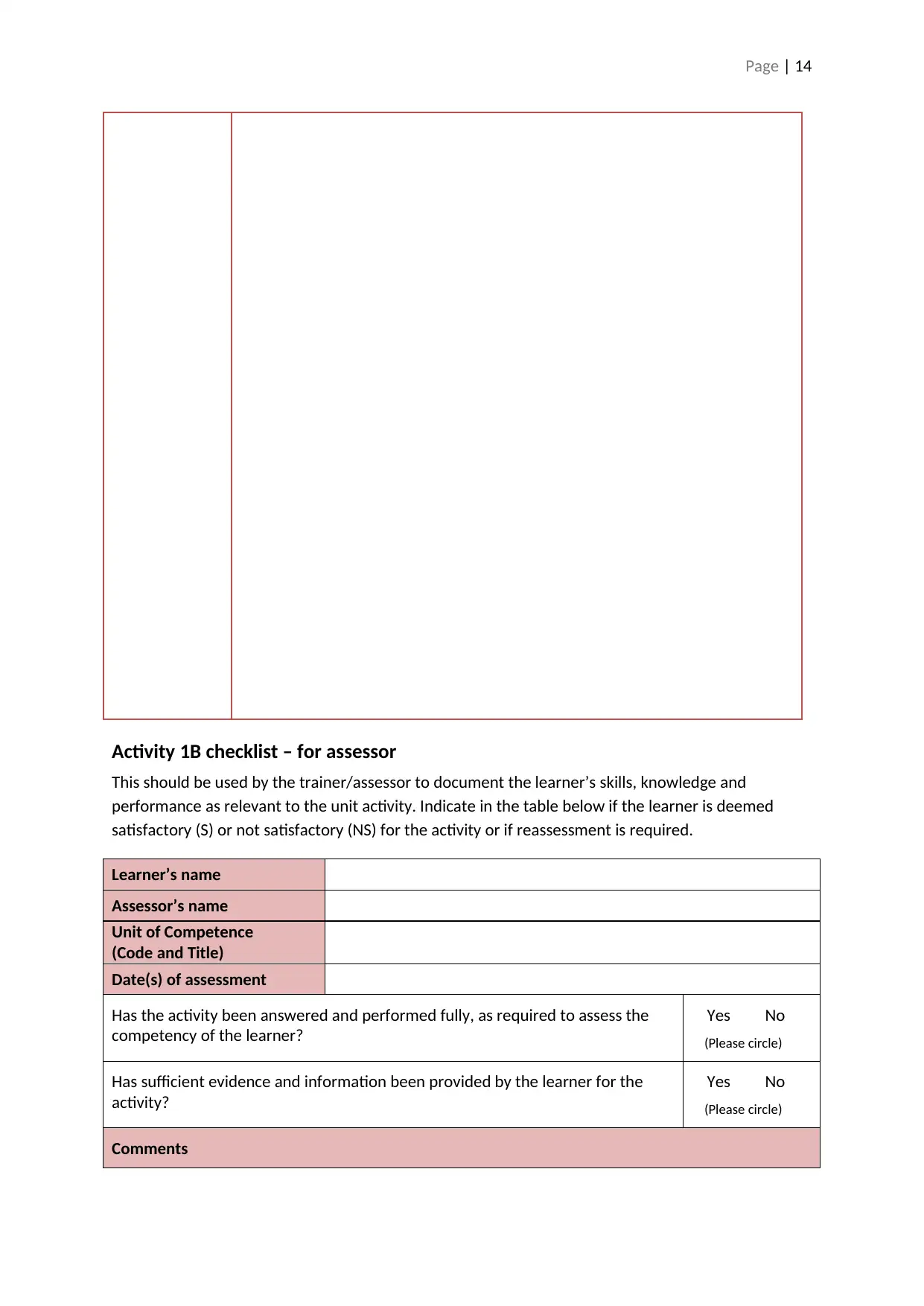
Page | 14
Activity 1B checklist – for assessor
This should be used by the trainer/assessor to document the learner’s skills, knowledge and
performance as relevant to the unit activity. Indicate in the table below if the learner is deemed
satisfactory (S) or not satisfactory (NS) for the activity or if reassessment is required.
Learner’s name
Assessor’s name
Unit of Competence
(Code and Title)
Date(s) of assessment
Has the activity been answered and performed fully, as required to assess the
competency of the learner?
Yes No
(Please circle)
Has sufficient evidence and information been provided by the learner for the
activity?
Yes No
(Please circle)
Comments
Activity 1B checklist – for assessor
This should be used by the trainer/assessor to document the learner’s skills, knowledge and
performance as relevant to the unit activity. Indicate in the table below if the learner is deemed
satisfactory (S) or not satisfactory (NS) for the activity or if reassessment is required.
Learner’s name
Assessor’s name
Unit of Competence
(Code and Title)
Date(s) of assessment
Has the activity been answered and performed fully, as required to assess the
competency of the learner?
Yes No
(Please circle)
Has sufficient evidence and information been provided by the learner for the
activity?
Yes No
(Please circle)
Comments

Page | 15
Provide your comments here:
The learner’s
performance was: Not yet satisfactory Satisfactory
If not yet satisfactory, date for reassessment:
Feedback to learner:
Learner’s signature
Assessor’s signature
Activity 1C
Estimated Time 20 Minutes
Objective To provide you with an opportunity to understand how to review business
plans to establish critical dates and initiatives that will require or generate
resources in the next financial cycle.
Activity Using your business plan, identify your business’ critical dates in terms of
income and resource use and generation.
Critical business date of the organisation as per the business plan refers to the
universal dates like black friday, End of financial year sales, Boxing Day and
national and worldwide high volume sale day in retail. All these days are
important for business as because they certainly have impact over the way and
Organisation work and other resources that will be utilised for that day (Jeanne
and Korinek, 2018). After near understanding of the important and Critical
dates for an organisation, those dates will certainly have impact over new
Provide your comments here:
The learner’s
performance was: Not yet satisfactory Satisfactory
If not yet satisfactory, date for reassessment:
Feedback to learner:
Learner’s signature
Assessor’s signature
Activity 1C
Estimated Time 20 Minutes
Objective To provide you with an opportunity to understand how to review business
plans to establish critical dates and initiatives that will require or generate
resources in the next financial cycle.
Activity Using your business plan, identify your business’ critical dates in terms of
income and resource use and generation.
Critical business date of the organisation as per the business plan refers to the
universal dates like black friday, End of financial year sales, Boxing Day and
national and worldwide high volume sale day in retail. All these days are
important for business as because they certainly have impact over the way and
Organisation work and other resources that will be utilised for that day (Jeanne
and Korinek, 2018). After near understanding of the important and Critical
dates for an organisation, those dates will certainly have impact over new
Secure Best Marks with AI Grader
Need help grading? Try our AI Grader for instant feedback on your assignments.

Page | 16
released items as well as clothing changes that are directly resulted through
finance but by seasonal changes.
Activity 1C checklist – for assessor
This should be used by the trainer/assessor to document the learner’s skills, knowledge and
performance as relevant to the unit activity. Indicate in the table below if the learner is deemed
satisfactory (S) or not satisfactory (NS) for the activity or if reassessment is required.
Learner’s name
Assessor’s name
Unit of Competence
(Code and Title)
released items as well as clothing changes that are directly resulted through
finance but by seasonal changes.
Activity 1C checklist – for assessor
This should be used by the trainer/assessor to document the learner’s skills, knowledge and
performance as relevant to the unit activity. Indicate in the table below if the learner is deemed
satisfactory (S) or not satisfactory (NS) for the activity or if reassessment is required.
Learner’s name
Assessor’s name
Unit of Competence
(Code and Title)
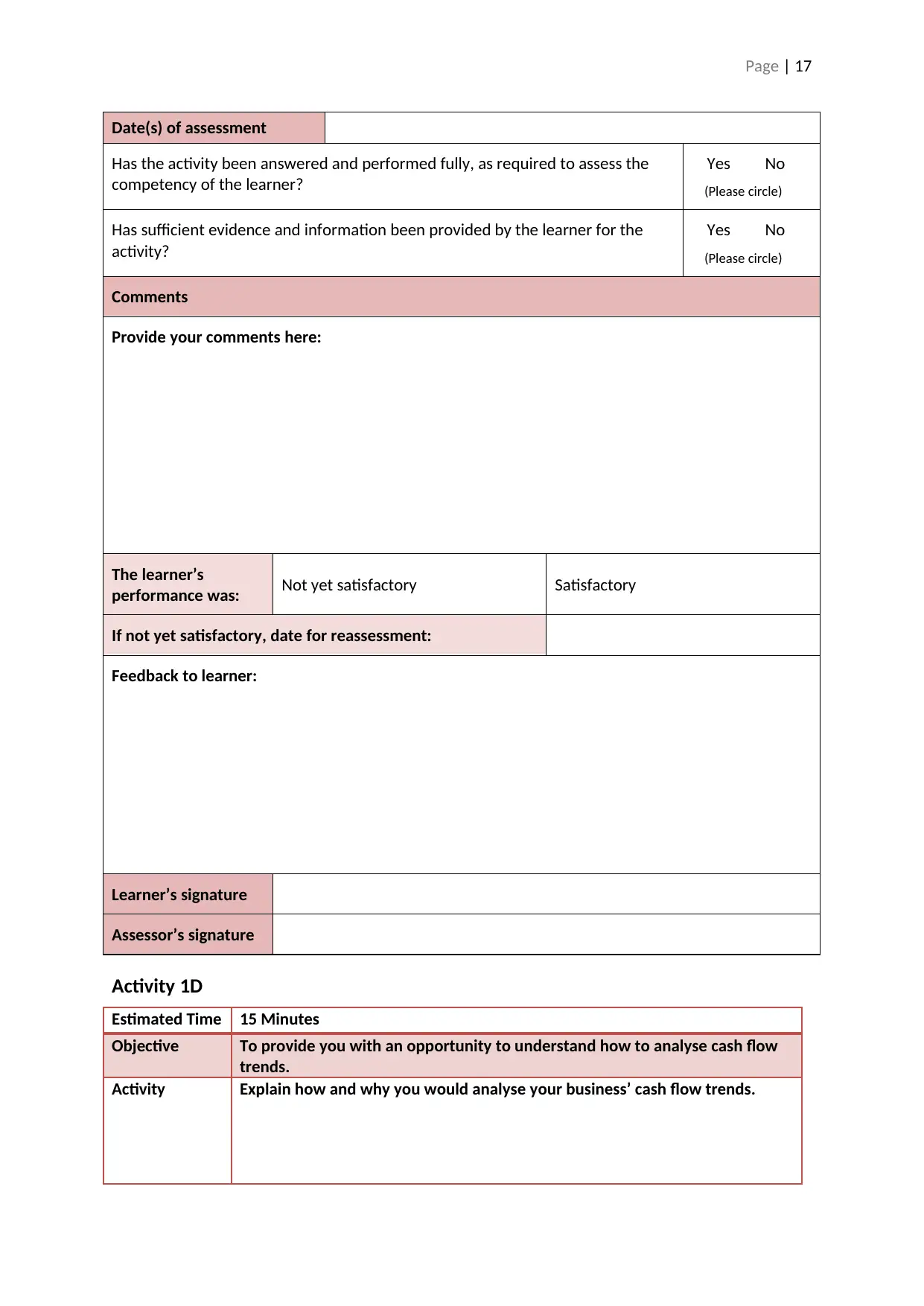
Page | 17
Date(s) of assessment
Has the activity been answered and performed fully, as required to assess the
competency of the learner?
Yes No
(Please circle)
Has sufficient evidence and information been provided by the learner for the
activity?
Yes No
(Please circle)
Comments
Provide your comments here:
The learner’s
performance was: Not yet satisfactory Satisfactory
If not yet satisfactory, date for reassessment:
Feedback to learner:
Learner’s signature
Assessor’s signature
Activity 1D
Estimated Time 15 Minutes
Objective To provide you with an opportunity to understand how to analyse cash flow
trends.
Activity Explain how and why you would analyse your business’ cash flow trends.
Date(s) of assessment
Has the activity been answered and performed fully, as required to assess the
competency of the learner?
Yes No
(Please circle)
Has sufficient evidence and information been provided by the learner for the
activity?
Yes No
(Please circle)
Comments
Provide your comments here:
The learner’s
performance was: Not yet satisfactory Satisfactory
If not yet satisfactory, date for reassessment:
Feedback to learner:
Learner’s signature
Assessor’s signature
Activity 1D
Estimated Time 15 Minutes
Objective To provide you with an opportunity to understand how to analyse cash flow
trends.
Activity Explain how and why you would analyse your business’ cash flow trends.
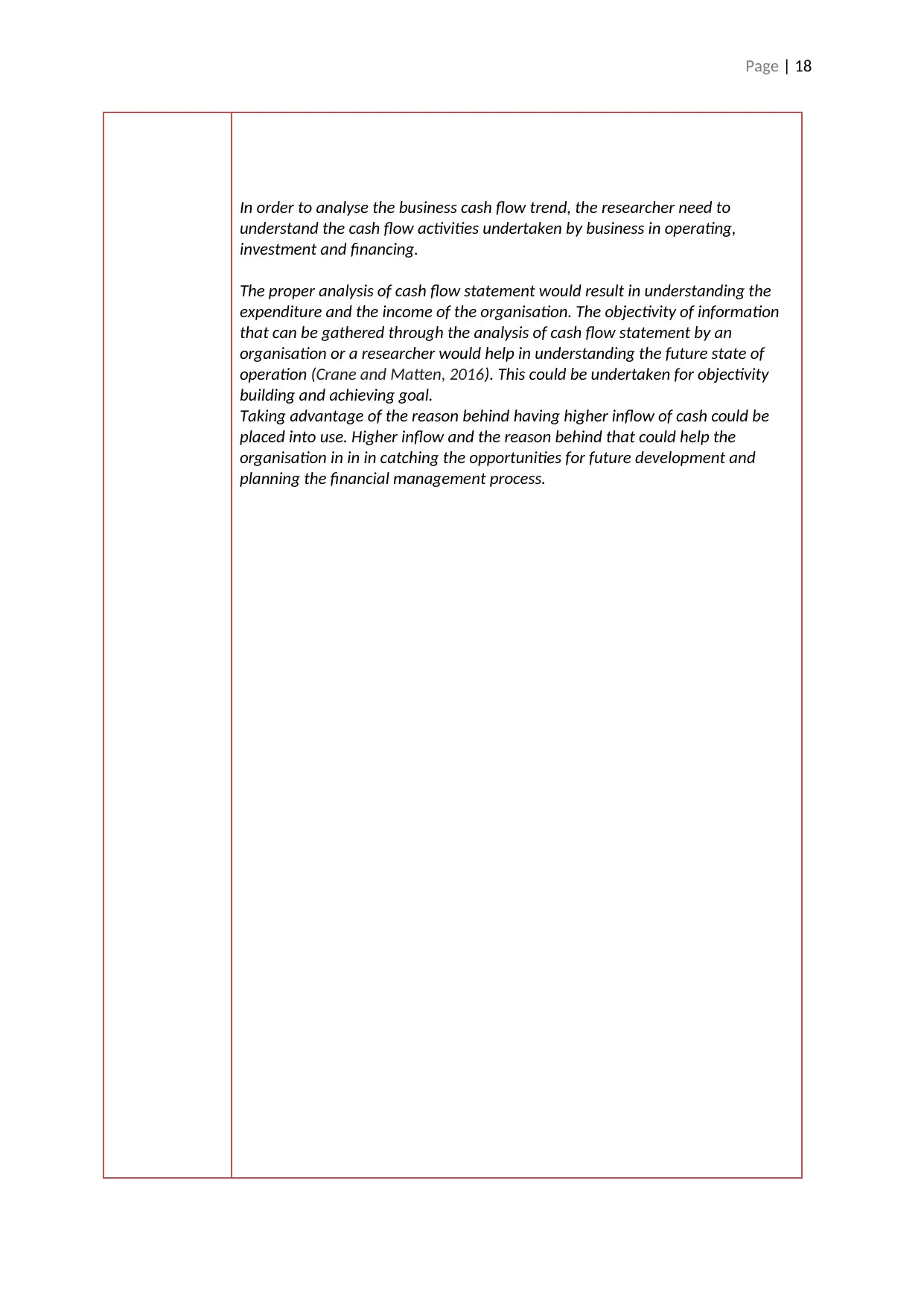
Page | 18
In order to analyse the business cash flow trend, the researcher need to
understand the cash flow activities undertaken by business in operating,
investment and financing.
The proper analysis of cash flow statement would result in understanding the
expenditure and the income of the organisation. The objectivity of information
that can be gathered through the analysis of cash flow statement by an
organisation or a researcher would help in understanding the future state of
operation (Crane and Matten, 2016). This could be undertaken for objectivity
building and achieving goal.
Taking advantage of the reason behind having higher inflow of cash could be
placed into use. Higher inflow and the reason behind that could help the
organisation in in in catching the opportunities for future development and
planning the financial management process.
In order to analyse the business cash flow trend, the researcher need to
understand the cash flow activities undertaken by business in operating,
investment and financing.
The proper analysis of cash flow statement would result in understanding the
expenditure and the income of the organisation. The objectivity of information
that can be gathered through the analysis of cash flow statement by an
organisation or a researcher would help in understanding the future state of
operation (Crane and Matten, 2016). This could be undertaken for objectivity
building and achieving goal.
Taking advantage of the reason behind having higher inflow of cash could be
placed into use. Higher inflow and the reason behind that could help the
organisation in in in catching the opportunities for future development and
planning the financial management process.
Paraphrase This Document
Need a fresh take? Get an instant paraphrase of this document with our AI Paraphraser
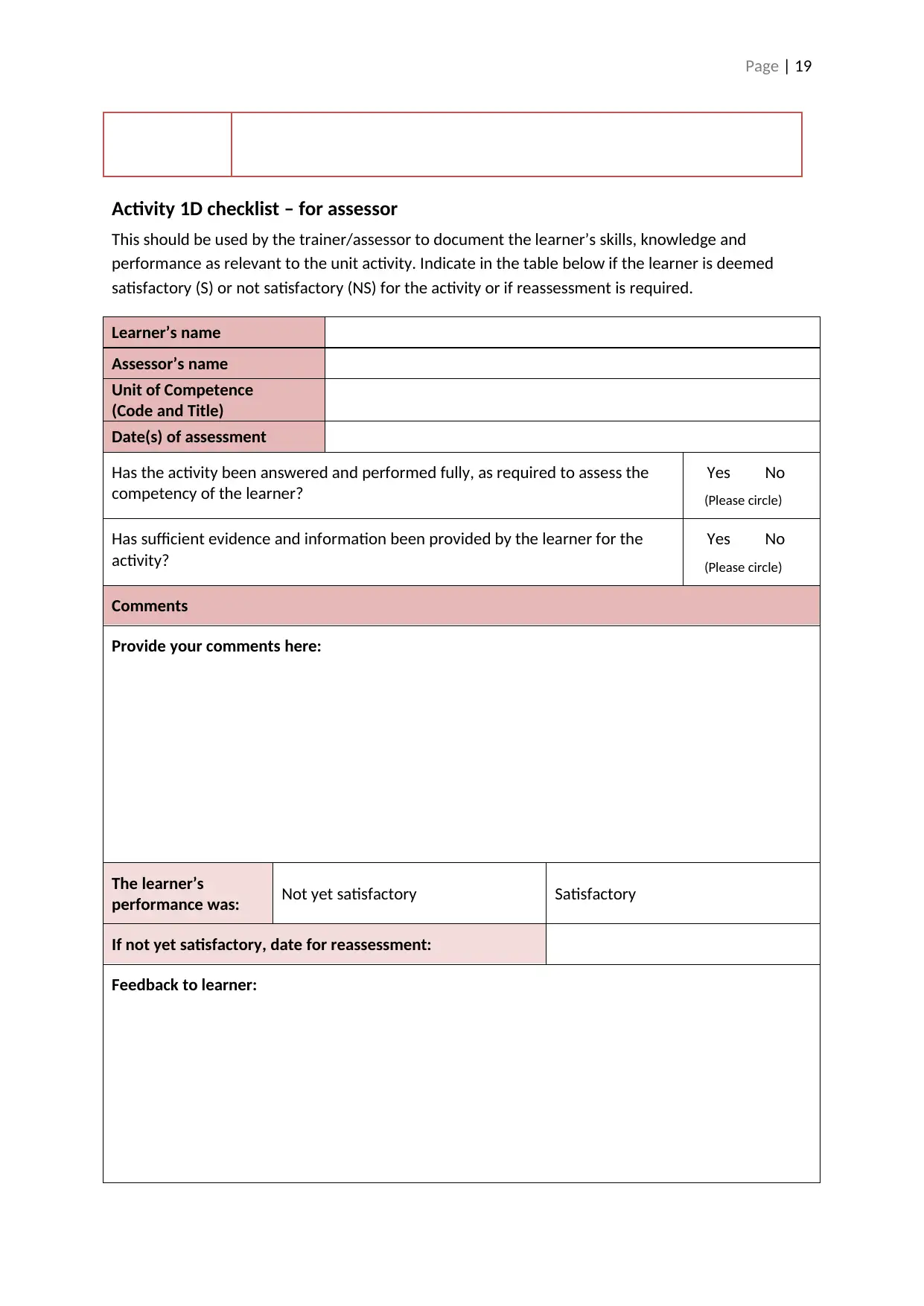
Page | 19
Activity 1D checklist – for assessor
This should be used by the trainer/assessor to document the learner’s skills, knowledge and
performance as relevant to the unit activity. Indicate in the table below if the learner is deemed
satisfactory (S) or not satisfactory (NS) for the activity or if reassessment is required.
Learner’s name
Assessor’s name
Unit of Competence
(Code and Title)
Date(s) of assessment
Has the activity been answered and performed fully, as required to assess the
competency of the learner?
Yes No
(Please circle)
Has sufficient evidence and information been provided by the learner for the
activity?
Yes No
(Please circle)
Comments
Provide your comments here:
The learner’s
performance was: Not yet satisfactory Satisfactory
If not yet satisfactory, date for reassessment:
Feedback to learner:
Activity 1D checklist – for assessor
This should be used by the trainer/assessor to document the learner’s skills, knowledge and
performance as relevant to the unit activity. Indicate in the table below if the learner is deemed
satisfactory (S) or not satisfactory (NS) for the activity or if reassessment is required.
Learner’s name
Assessor’s name
Unit of Competence
(Code and Title)
Date(s) of assessment
Has the activity been answered and performed fully, as required to assess the
competency of the learner?
Yes No
(Please circle)
Has sufficient evidence and information been provided by the learner for the
activity?
Yes No
(Please circle)
Comments
Provide your comments here:
The learner’s
performance was: Not yet satisfactory Satisfactory
If not yet satisfactory, date for reassessment:
Feedback to learner:
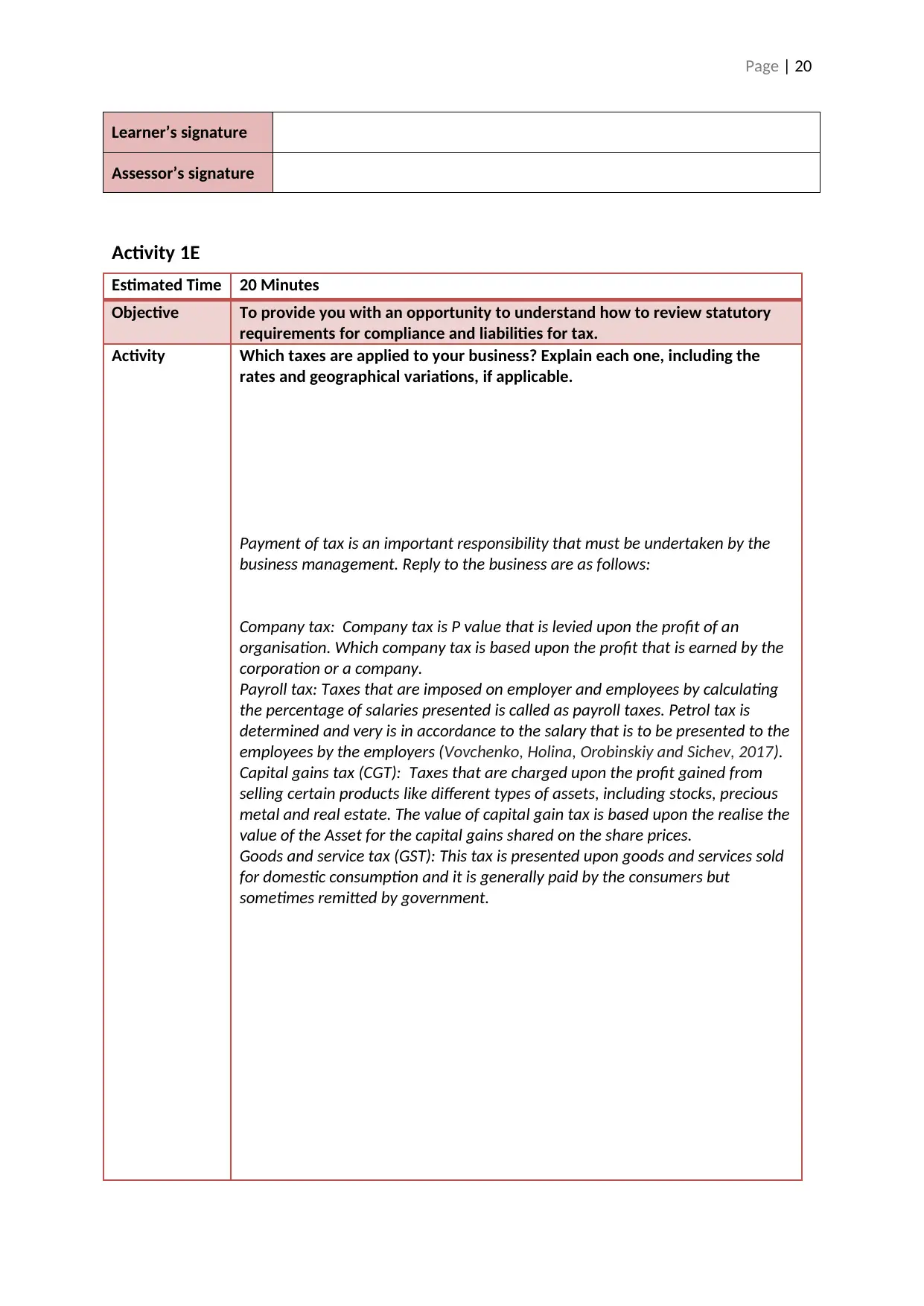
Page | 20
Learner’s signature
Assessor’s signature
Activity 1E
Estimated Time 20 Minutes
Objective To provide you with an opportunity to understand how to review statutory
requirements for compliance and liabilities for tax.
Activity Which taxes are applied to your business? Explain each one, including the
rates and geographical variations, if applicable.
Payment of tax is an important responsibility that must be undertaken by the
business management. Reply to the business are as follows:
Company tax: Company tax is P value that is levied upon the profit of an
organisation. Which company tax is based upon the profit that is earned by the
corporation or a company.
Payroll tax: Taxes that are imposed on employer and employees by calculating
the percentage of salaries presented is called as payroll taxes. Petrol tax is
determined and very is in accordance to the salary that is to be presented to the
employees by the employers (Vovchenko, Holina, Orobinskiy and Sichev, 2017).
Capital gains tax (CGT): Taxes that are charged upon the profit gained from
selling certain products like different types of assets, including stocks, precious
metal and real estate. The value of capital gain tax is based upon the realise the
value of the Asset for the capital gains shared on the share prices.
Goods and service tax (GST): This tax is presented upon goods and services sold
for domestic consumption and it is generally paid by the consumers but
sometimes remitted by government.
Learner’s signature
Assessor’s signature
Activity 1E
Estimated Time 20 Minutes
Objective To provide you with an opportunity to understand how to review statutory
requirements for compliance and liabilities for tax.
Activity Which taxes are applied to your business? Explain each one, including the
rates and geographical variations, if applicable.
Payment of tax is an important responsibility that must be undertaken by the
business management. Reply to the business are as follows:
Company tax: Company tax is P value that is levied upon the profit of an
organisation. Which company tax is based upon the profit that is earned by the
corporation or a company.
Payroll tax: Taxes that are imposed on employer and employees by calculating
the percentage of salaries presented is called as payroll taxes. Petrol tax is
determined and very is in accordance to the salary that is to be presented to the
employees by the employers (Vovchenko, Holina, Orobinskiy and Sichev, 2017).
Capital gains tax (CGT): Taxes that are charged upon the profit gained from
selling certain products like different types of assets, including stocks, precious
metal and real estate. The value of capital gain tax is based upon the realise the
value of the Asset for the capital gains shared on the share prices.
Goods and service tax (GST): This tax is presented upon goods and services sold
for domestic consumption and it is generally paid by the consumers but
sometimes remitted by government.
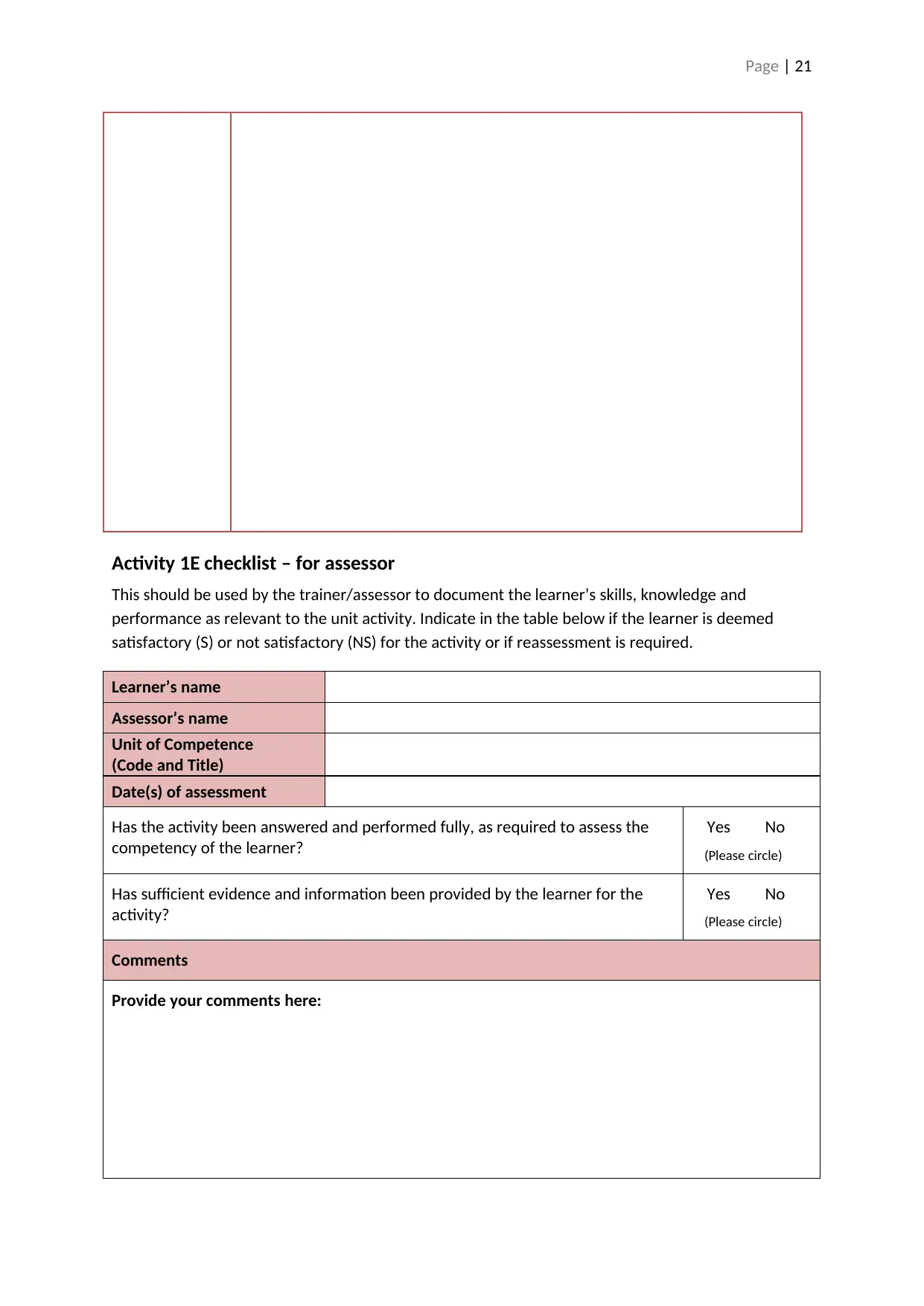
Page | 21
Activity 1E checklist – for assessor
This should be used by the trainer/assessor to document the learner’s skills, knowledge and
performance as relevant to the unit activity. Indicate in the table below if the learner is deemed
satisfactory (S) or not satisfactory (NS) for the activity or if reassessment is required.
Learner’s name
Assessor’s name
Unit of Competence
(Code and Title)
Date(s) of assessment
Has the activity been answered and performed fully, as required to assess the
competency of the learner?
Yes No
(Please circle)
Has sufficient evidence and information been provided by the learner for the
activity?
Yes No
(Please circle)
Comments
Provide your comments here:
Activity 1E checklist – for assessor
This should be used by the trainer/assessor to document the learner’s skills, knowledge and
performance as relevant to the unit activity. Indicate in the table below if the learner is deemed
satisfactory (S) or not satisfactory (NS) for the activity or if reassessment is required.
Learner’s name
Assessor’s name
Unit of Competence
(Code and Title)
Date(s) of assessment
Has the activity been answered and performed fully, as required to assess the
competency of the learner?
Yes No
(Please circle)
Has sufficient evidence and information been provided by the learner for the
activity?
Yes No
(Please circle)
Comments
Provide your comments here:
Secure Best Marks with AI Grader
Need help grading? Try our AI Grader for instant feedback on your assignments.
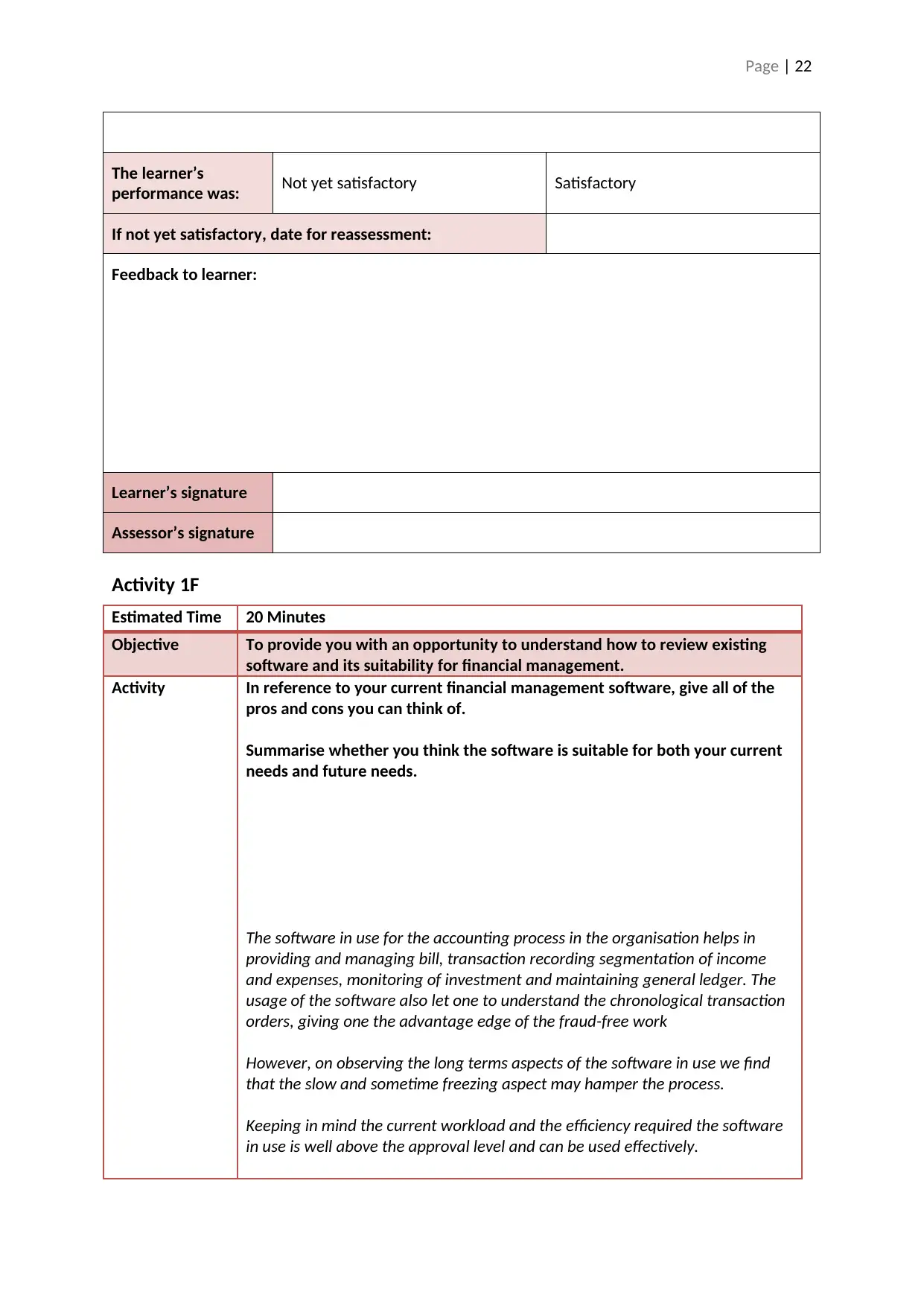
Page | 22
The learner’s
performance was: Not yet satisfactory Satisfactory
If not yet satisfactory, date for reassessment:
Feedback to learner:
Learner’s signature
Assessor’s signature
Activity 1F
Estimated Time 20 Minutes
Objective To provide you with an opportunity to understand how to review existing
software and its suitability for financial management.
Activity In reference to your current financial management software, give all of the
pros and cons you can think of.
Summarise whether you think the software is suitable for both your current
needs and future needs.
The software in use for the accounting process in the organisation helps in
providing and managing bill, transaction recording segmentation of income
and expenses, monitoring of investment and maintaining general ledger. The
usage of the software also let one to understand the chronological transaction
orders, giving one the advantage edge of the fraud-free work
However, on observing the long terms aspects of the software in use we find
that the slow and sometime freezing aspect may hamper the process.
Keeping in mind the current workload and the efficiency required the software
in use is well above the approval level and can be used effectively.
The learner’s
performance was: Not yet satisfactory Satisfactory
If not yet satisfactory, date for reassessment:
Feedback to learner:
Learner’s signature
Assessor’s signature
Activity 1F
Estimated Time 20 Minutes
Objective To provide you with an opportunity to understand how to review existing
software and its suitability for financial management.
Activity In reference to your current financial management software, give all of the
pros and cons you can think of.
Summarise whether you think the software is suitable for both your current
needs and future needs.
The software in use for the accounting process in the organisation helps in
providing and managing bill, transaction recording segmentation of income
and expenses, monitoring of investment and maintaining general ledger. The
usage of the software also let one to understand the chronological transaction
orders, giving one the advantage edge of the fraud-free work
However, on observing the long terms aspects of the software in use we find
that the slow and sometime freezing aspect may hamper the process.
Keeping in mind the current workload and the efficiency required the software
in use is well above the approval level and can be used effectively.
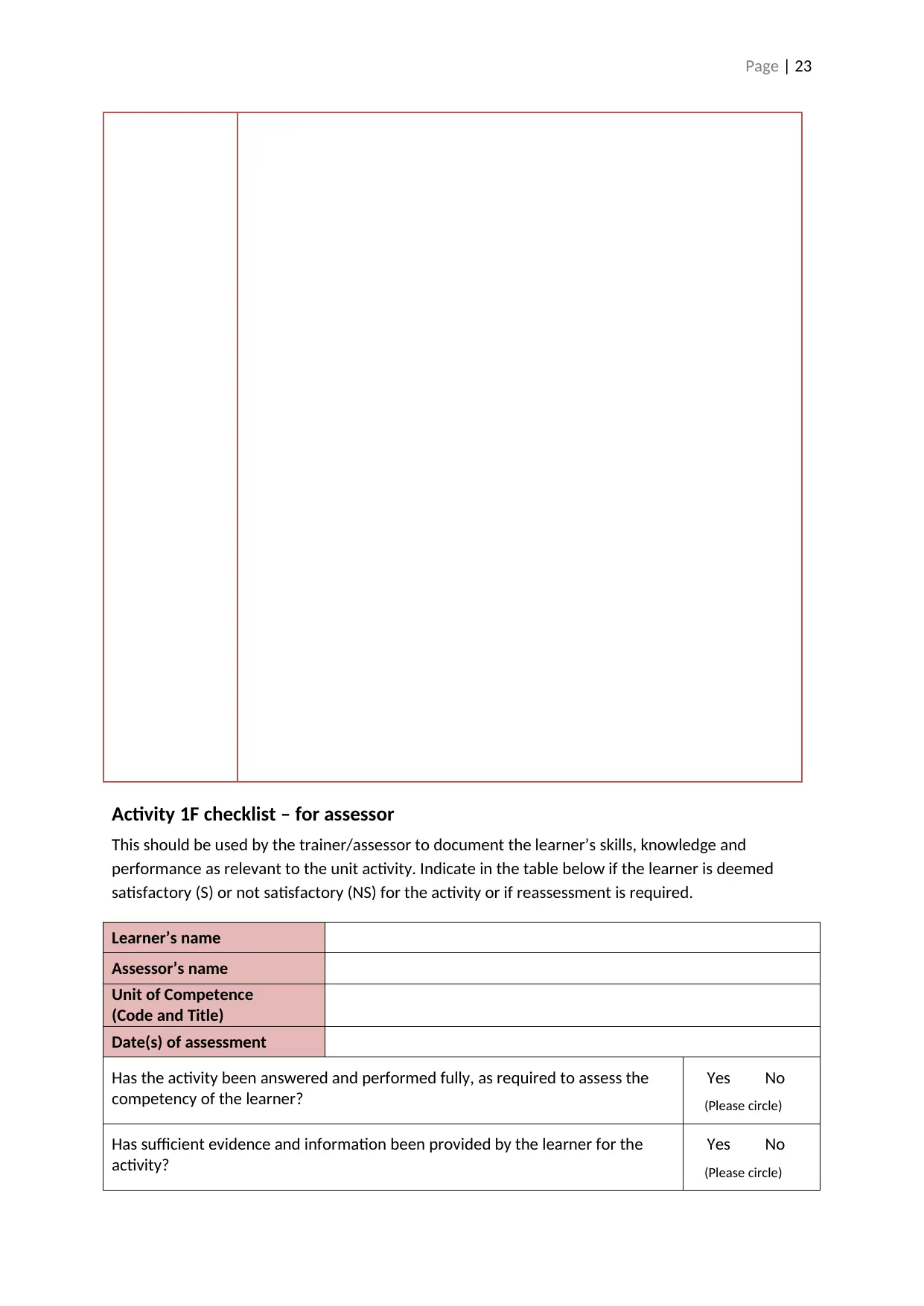
Page | 23
Activity 1F checklist – for assessor
This should be used by the trainer/assessor to document the learner’s skills, knowledge and
performance as relevant to the unit activity. Indicate in the table below if the learner is deemed
satisfactory (S) or not satisfactory (NS) for the activity or if reassessment is required.
Learner’s name
Assessor’s name
Unit of Competence
(Code and Title)
Date(s) of assessment
Has the activity been answered and performed fully, as required to assess the
competency of the learner?
Yes No
(Please circle)
Has sufficient evidence and information been provided by the learner for the
activity?
Yes No
(Please circle)
Activity 1F checklist – for assessor
This should be used by the trainer/assessor to document the learner’s skills, knowledge and
performance as relevant to the unit activity. Indicate in the table below if the learner is deemed
satisfactory (S) or not satisfactory (NS) for the activity or if reassessment is required.
Learner’s name
Assessor’s name
Unit of Competence
(Code and Title)
Date(s) of assessment
Has the activity been answered and performed fully, as required to assess the
competency of the learner?
Yes No
(Please circle)
Has sufficient evidence and information been provided by the learner for the
activity?
Yes No
(Please circle)
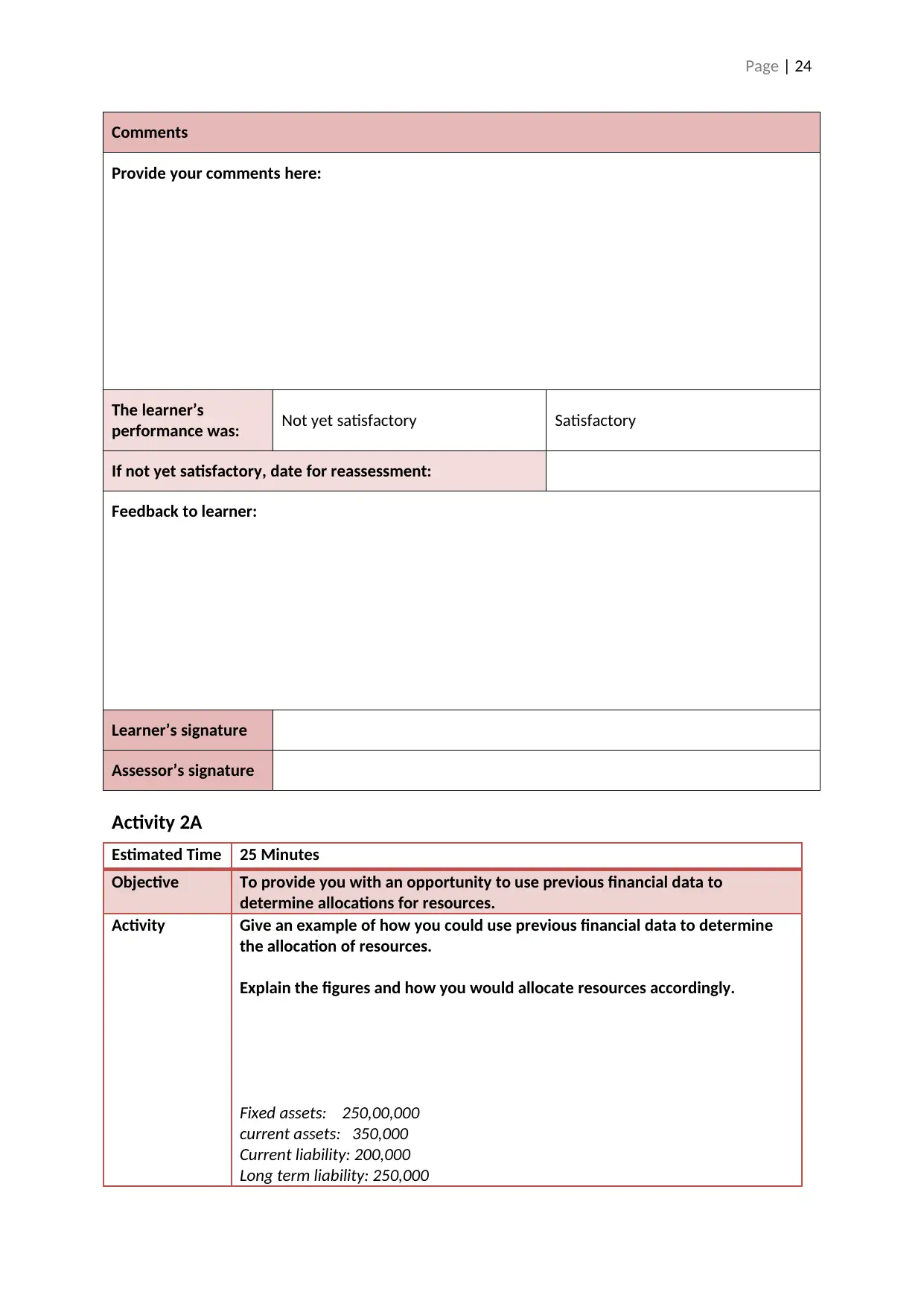
Page | 24
Comments
Provide your comments here:
The learner’s
performance was: Not yet satisfactory Satisfactory
If not yet satisfactory, date for reassessment:
Feedback to learner:
Learner’s signature
Assessor’s signature
Activity 2A
Estimated Time 25 Minutes
Objective To provide you with an opportunity to use previous financial data to
determine allocations for resources.
Activity Give an example of how you could use previous financial data to determine
the allocation of resources.
Explain the figures and how you would allocate resources accordingly.
Fixed assets: 250,00,000
current assets: 350,000
Current liability: 200,000
Long term liability: 250,000
Comments
Provide your comments here:
The learner’s
performance was: Not yet satisfactory Satisfactory
If not yet satisfactory, date for reassessment:
Feedback to learner:
Learner’s signature
Assessor’s signature
Activity 2A
Estimated Time 25 Minutes
Objective To provide you with an opportunity to use previous financial data to
determine allocations for resources.
Activity Give an example of how you could use previous financial data to determine
the allocation of resources.
Explain the figures and how you would allocate resources accordingly.
Fixed assets: 250,00,000
current assets: 350,000
Current liability: 200,000
Long term liability: 250,000
Paraphrase This Document
Need a fresh take? Get an instant paraphrase of this document with our AI Paraphraser

Page | 25
From the financial information of the above table regarding fixed asset, current
asset, current liability and long term liability, we observe a huge difference in
the values that must be get into consideration for making sure that the
resources are well allocated for a better operation. When allocating the fixed
asset we must be aware of its selling and reinvestment to make proper
mitigation of the current assets and long term liability.
The value of the current asset shows at 350000 that needs to be utilised with
proper caution to minimise the current liability to get better liquidity ratio.
From the financial information of the above table regarding fixed asset, current
asset, current liability and long term liability, we observe a huge difference in
the values that must be get into consideration for making sure that the
resources are well allocated for a better operation. When allocating the fixed
asset we must be aware of its selling and reinvestment to make proper
mitigation of the current assets and long term liability.
The value of the current asset shows at 350000 that needs to be utilised with
proper caution to minimise the current liability to get better liquidity ratio.
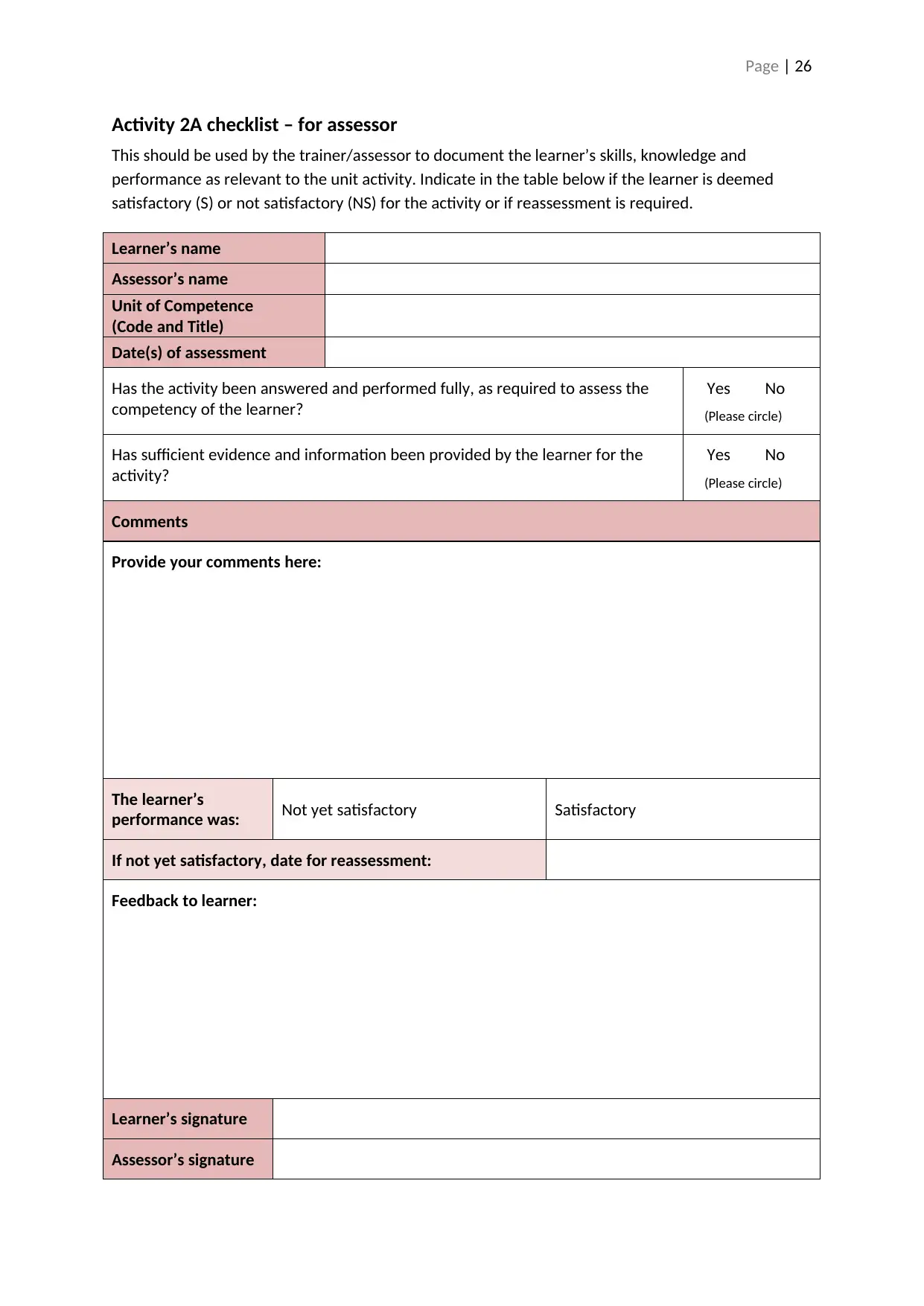
Page | 26
Activity 2A checklist – for assessor
This should be used by the trainer/assessor to document the learner’s skills, knowledge and
performance as relevant to the unit activity. Indicate in the table below if the learner is deemed
satisfactory (S) or not satisfactory (NS) for the activity or if reassessment is required.
Learner’s name
Assessor’s name
Unit of Competence
(Code and Title)
Date(s) of assessment
Has the activity been answered and performed fully, as required to assess the
competency of the learner?
Yes No
(Please circle)
Has sufficient evidence and information been provided by the learner for the
activity?
Yes No
(Please circle)
Comments
Provide your comments here:
The learner’s
performance was: Not yet satisfactory Satisfactory
If not yet satisfactory, date for reassessment:
Feedback to learner:
Learner’s signature
Assessor’s signature
Activity 2A checklist – for assessor
This should be used by the trainer/assessor to document the learner’s skills, knowledge and
performance as relevant to the unit activity. Indicate in the table below if the learner is deemed
satisfactory (S) or not satisfactory (NS) for the activity or if reassessment is required.
Learner’s name
Assessor’s name
Unit of Competence
(Code and Title)
Date(s) of assessment
Has the activity been answered and performed fully, as required to assess the
competency of the learner?
Yes No
(Please circle)
Has sufficient evidence and information been provided by the learner for the
activity?
Yes No
(Please circle)
Comments
Provide your comments here:
The learner’s
performance was: Not yet satisfactory Satisfactory
If not yet satisfactory, date for reassessment:
Feedback to learner:
Learner’s signature
Assessor’s signature
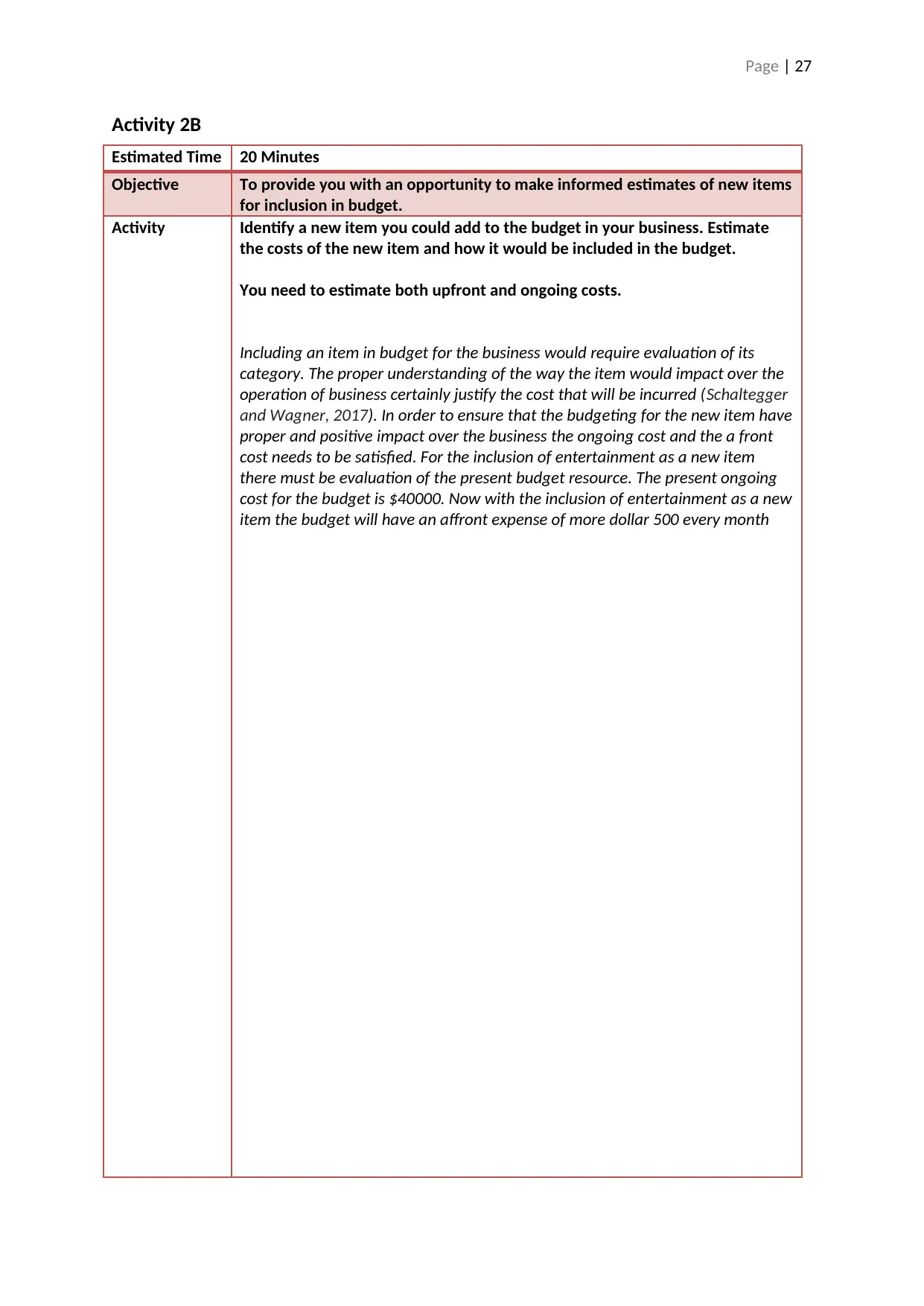
Page | 27
Activity 2B
Estimated Time 20 Minutes
Objective To provide you with an opportunity to make informed estimates of new items
for inclusion in budget.
Activity Identify a new item you could add to the budget in your business. Estimate
the costs of the new item and how it would be included in the budget.
You need to estimate both upfront and ongoing costs.
Including an item in budget for the business would require evaluation of its
category. The proper understanding of the way the item would impact over the
operation of business certainly justify the cost that will be incurred (Schaltegger
and Wagner, 2017). In order to ensure that the budgeting for the new item have
proper and positive impact over the business the ongoing cost and the a front
cost needs to be satisfied. For the inclusion of entertainment as a new item
there must be evaluation of the present budget resource. The present ongoing
cost for the budget is $40000. Now with the inclusion of entertainment as a new
item the budget will have an affront expense of more dollar 500 every month
Activity 2B
Estimated Time 20 Minutes
Objective To provide you with an opportunity to make informed estimates of new items
for inclusion in budget.
Activity Identify a new item you could add to the budget in your business. Estimate
the costs of the new item and how it would be included in the budget.
You need to estimate both upfront and ongoing costs.
Including an item in budget for the business would require evaluation of its
category. The proper understanding of the way the item would impact over the
operation of business certainly justify the cost that will be incurred (Schaltegger
and Wagner, 2017). In order to ensure that the budgeting for the new item have
proper and positive impact over the business the ongoing cost and the a front
cost needs to be satisfied. For the inclusion of entertainment as a new item
there must be evaluation of the present budget resource. The present ongoing
cost for the budget is $40000. Now with the inclusion of entertainment as a new
item the budget will have an affront expense of more dollar 500 every month
Secure Best Marks with AI Grader
Need help grading? Try our AI Grader for instant feedback on your assignments.
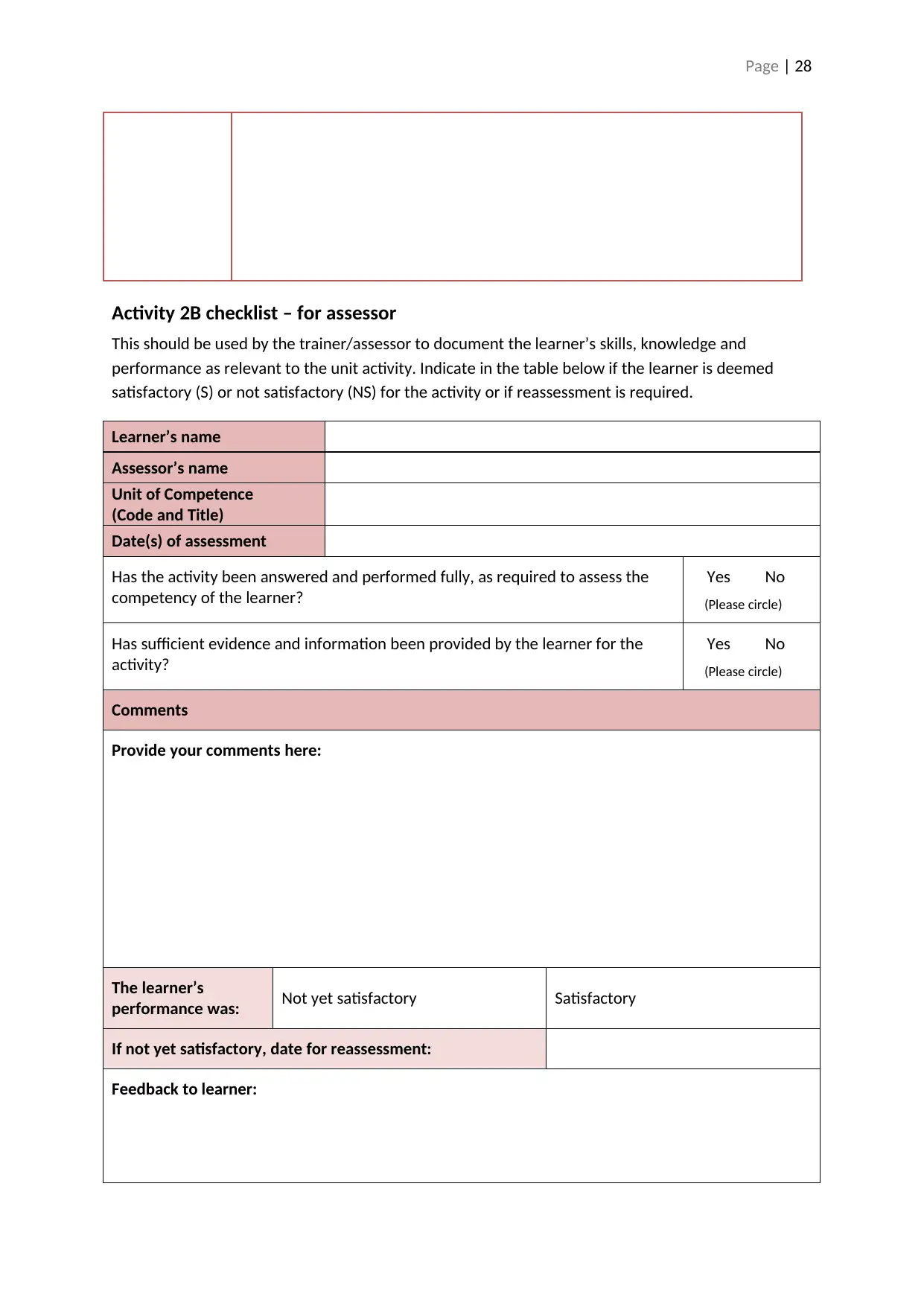
Page | 28
Activity 2B checklist – for assessor
This should be used by the trainer/assessor to document the learner’s skills, knowledge and
performance as relevant to the unit activity. Indicate in the table below if the learner is deemed
satisfactory (S) or not satisfactory (NS) for the activity or if reassessment is required.
Learner’s name
Assessor’s name
Unit of Competence
(Code and Title)
Date(s) of assessment
Has the activity been answered and performed fully, as required to assess the
competency of the learner?
Yes No
(Please circle)
Has sufficient evidence and information been provided by the learner for the
activity?
Yes No
(Please circle)
Comments
Provide your comments here:
The learner’s
performance was: Not yet satisfactory Satisfactory
If not yet satisfactory, date for reassessment:
Feedback to learner:
Activity 2B checklist – for assessor
This should be used by the trainer/assessor to document the learner’s skills, knowledge and
performance as relevant to the unit activity. Indicate in the table below if the learner is deemed
satisfactory (S) or not satisfactory (NS) for the activity or if reassessment is required.
Learner’s name
Assessor’s name
Unit of Competence
(Code and Title)
Date(s) of assessment
Has the activity been answered and performed fully, as required to assess the
competency of the learner?
Yes No
(Please circle)
Has sufficient evidence and information been provided by the learner for the
activity?
Yes No
(Please circle)
Comments
Provide your comments here:
The learner’s
performance was: Not yet satisfactory Satisfactory
If not yet satisfactory, date for reassessment:
Feedback to learner:
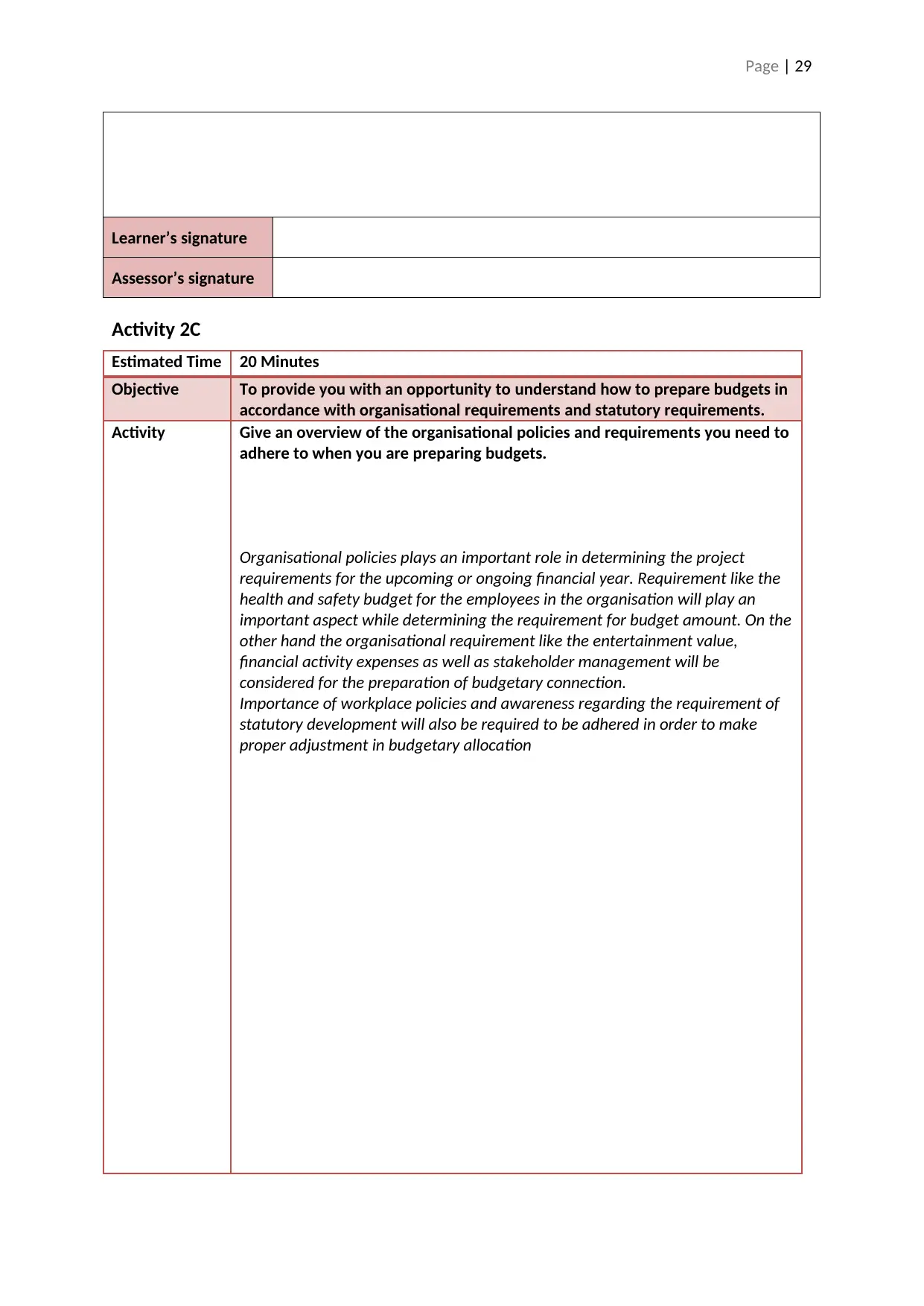
Page | 29
Learner’s signature
Assessor’s signature
Activity 2C
Estimated Time 20 Minutes
Objective To provide you with an opportunity to understand how to prepare budgets in
accordance with organisational requirements and statutory requirements.
Activity Give an overview of the organisational policies and requirements you need to
adhere to when you are preparing budgets.
Organisational policies plays an important role in determining the project
requirements for the upcoming or ongoing financial year. Requirement like the
health and safety budget for the employees in the organisation will play an
important aspect while determining the requirement for budget amount. On the
other hand the organisational requirement like the entertainment value,
financial activity expenses as well as stakeholder management will be
considered for the preparation of budgetary connection.
Importance of workplace policies and awareness regarding the requirement of
statutory development will also be required to be adhered in order to make
proper adjustment in budgetary allocation
Learner’s signature
Assessor’s signature
Activity 2C
Estimated Time 20 Minutes
Objective To provide you with an opportunity to understand how to prepare budgets in
accordance with organisational requirements and statutory requirements.
Activity Give an overview of the organisational policies and requirements you need to
adhere to when you are preparing budgets.
Organisational policies plays an important role in determining the project
requirements for the upcoming or ongoing financial year. Requirement like the
health and safety budget for the employees in the organisation will play an
important aspect while determining the requirement for budget amount. On the
other hand the organisational requirement like the entertainment value,
financial activity expenses as well as stakeholder management will be
considered for the preparation of budgetary connection.
Importance of workplace policies and awareness regarding the requirement of
statutory development will also be required to be adhered in order to make
proper adjustment in budgetary allocation
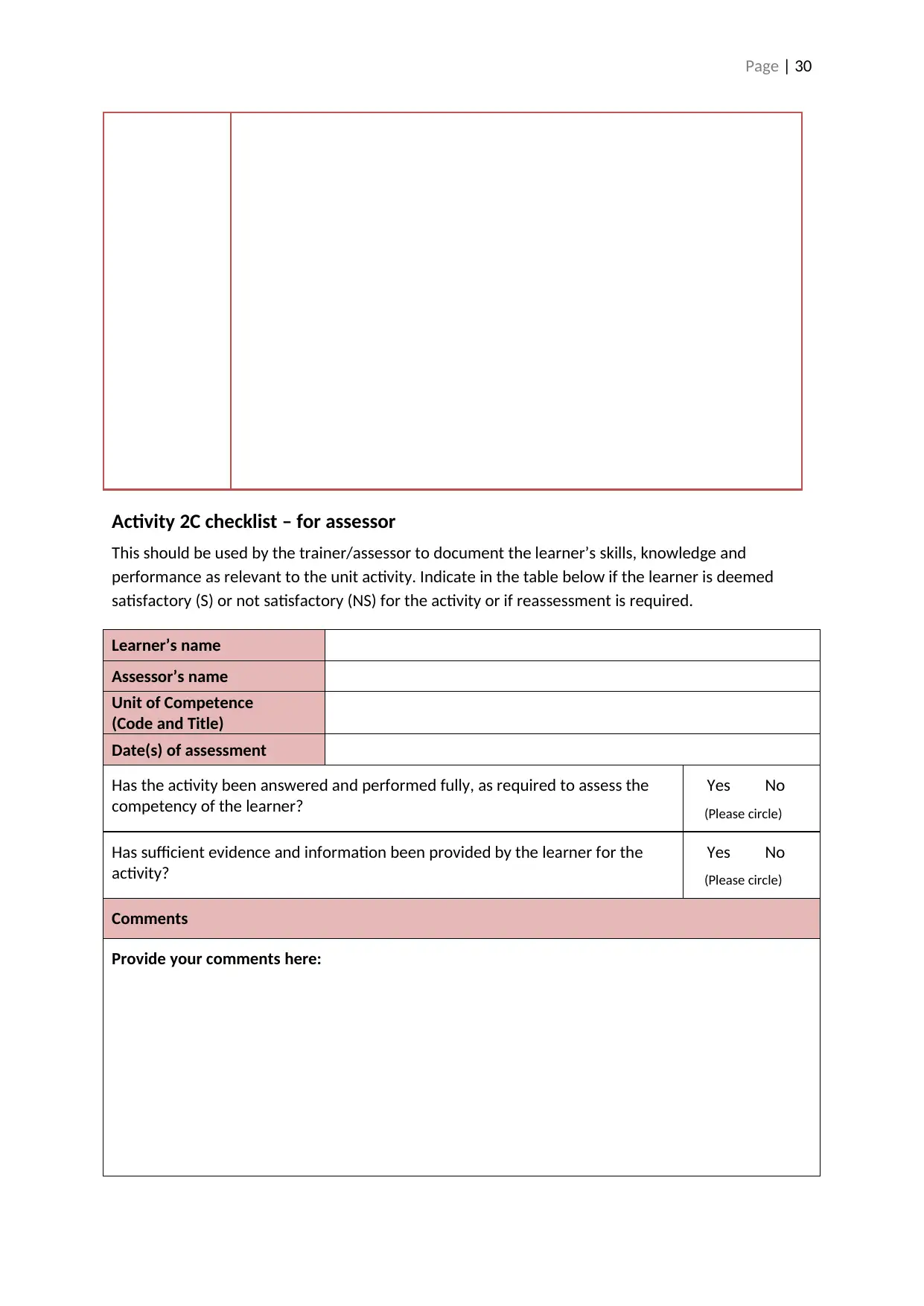
Page | 30
Activity 2C checklist – for assessor
This should be used by the trainer/assessor to document the learner’s skills, knowledge and
performance as relevant to the unit activity. Indicate in the table below if the learner is deemed
satisfactory (S) or not satisfactory (NS) for the activity or if reassessment is required.
Learner’s name
Assessor’s name
Unit of Competence
(Code and Title)
Date(s) of assessment
Has the activity been answered and performed fully, as required to assess the
competency of the learner?
Yes No
(Please circle)
Has sufficient evidence and information been provided by the learner for the
activity?
Yes No
(Please circle)
Comments
Provide your comments here:
Activity 2C checklist – for assessor
This should be used by the trainer/assessor to document the learner’s skills, knowledge and
performance as relevant to the unit activity. Indicate in the table below if the learner is deemed
satisfactory (S) or not satisfactory (NS) for the activity or if reassessment is required.
Learner’s name
Assessor’s name
Unit of Competence
(Code and Title)
Date(s) of assessment
Has the activity been answered and performed fully, as required to assess the
competency of the learner?
Yes No
(Please circle)
Has sufficient evidence and information been provided by the learner for the
activity?
Yes No
(Please circle)
Comments
Provide your comments here:
Paraphrase This Document
Need a fresh take? Get an instant paraphrase of this document with our AI Paraphraser
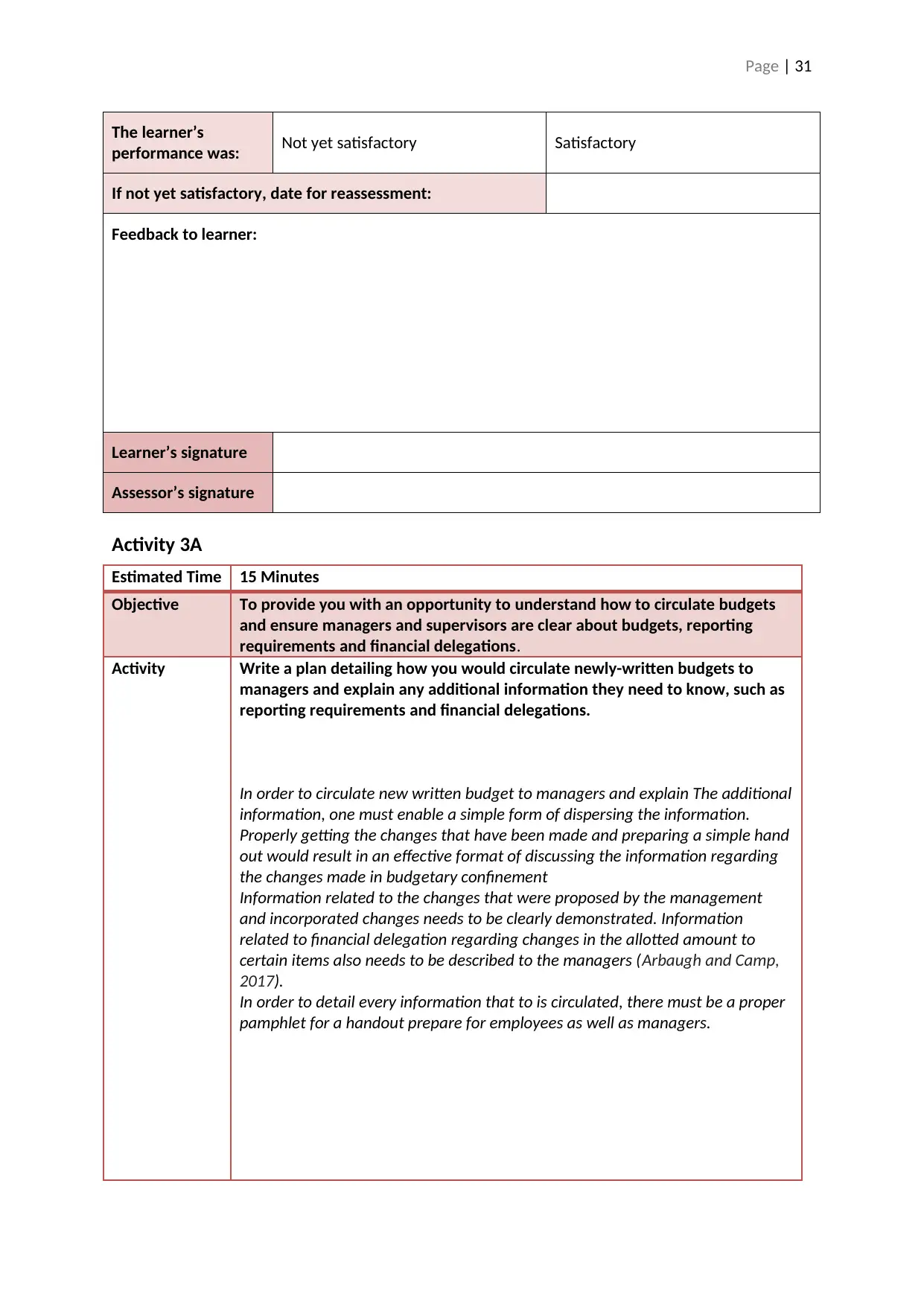
Page | 31
The learner’s
performance was: Not yet satisfactory Satisfactory
If not yet satisfactory, date for reassessment:
Feedback to learner:
Learner’s signature
Assessor’s signature
Activity 3A
Estimated Time 15 Minutes
Objective To provide you with an opportunity to understand how to circulate budgets
and ensure managers and supervisors are clear about budgets, reporting
requirements and financial delegations.
Activity Write a plan detailing how you would circulate newly-written budgets to
managers and explain any additional information they need to know, such as
reporting requirements and financial delegations.
In order to circulate new written budget to managers and explain The additional
information, one must enable a simple form of dispersing the information.
Properly getting the changes that have been made and preparing a simple hand
out would result in an effective format of discussing the information regarding
the changes made in budgetary confinement
Information related to the changes that were proposed by the management
and incorporated changes needs to be clearly demonstrated. Information
related to financial delegation regarding changes in the allotted amount to
certain items also needs to be described to the managers (Arbaugh and Camp,
2017).
In order to detail every information that to is circulated, there must be a proper
pamphlet for a handout prepare for employees as well as managers.
The learner’s
performance was: Not yet satisfactory Satisfactory
If not yet satisfactory, date for reassessment:
Feedback to learner:
Learner’s signature
Assessor’s signature
Activity 3A
Estimated Time 15 Minutes
Objective To provide you with an opportunity to understand how to circulate budgets
and ensure managers and supervisors are clear about budgets, reporting
requirements and financial delegations.
Activity Write a plan detailing how you would circulate newly-written budgets to
managers and explain any additional information they need to know, such as
reporting requirements and financial delegations.
In order to circulate new written budget to managers and explain The additional
information, one must enable a simple form of dispersing the information.
Properly getting the changes that have been made and preparing a simple hand
out would result in an effective format of discussing the information regarding
the changes made in budgetary confinement
Information related to the changes that were proposed by the management
and incorporated changes needs to be clearly demonstrated. Information
related to financial delegation regarding changes in the allotted amount to
certain items also needs to be described to the managers (Arbaugh and Camp,
2017).
In order to detail every information that to is circulated, there must be a proper
pamphlet for a handout prepare for employees as well as managers.
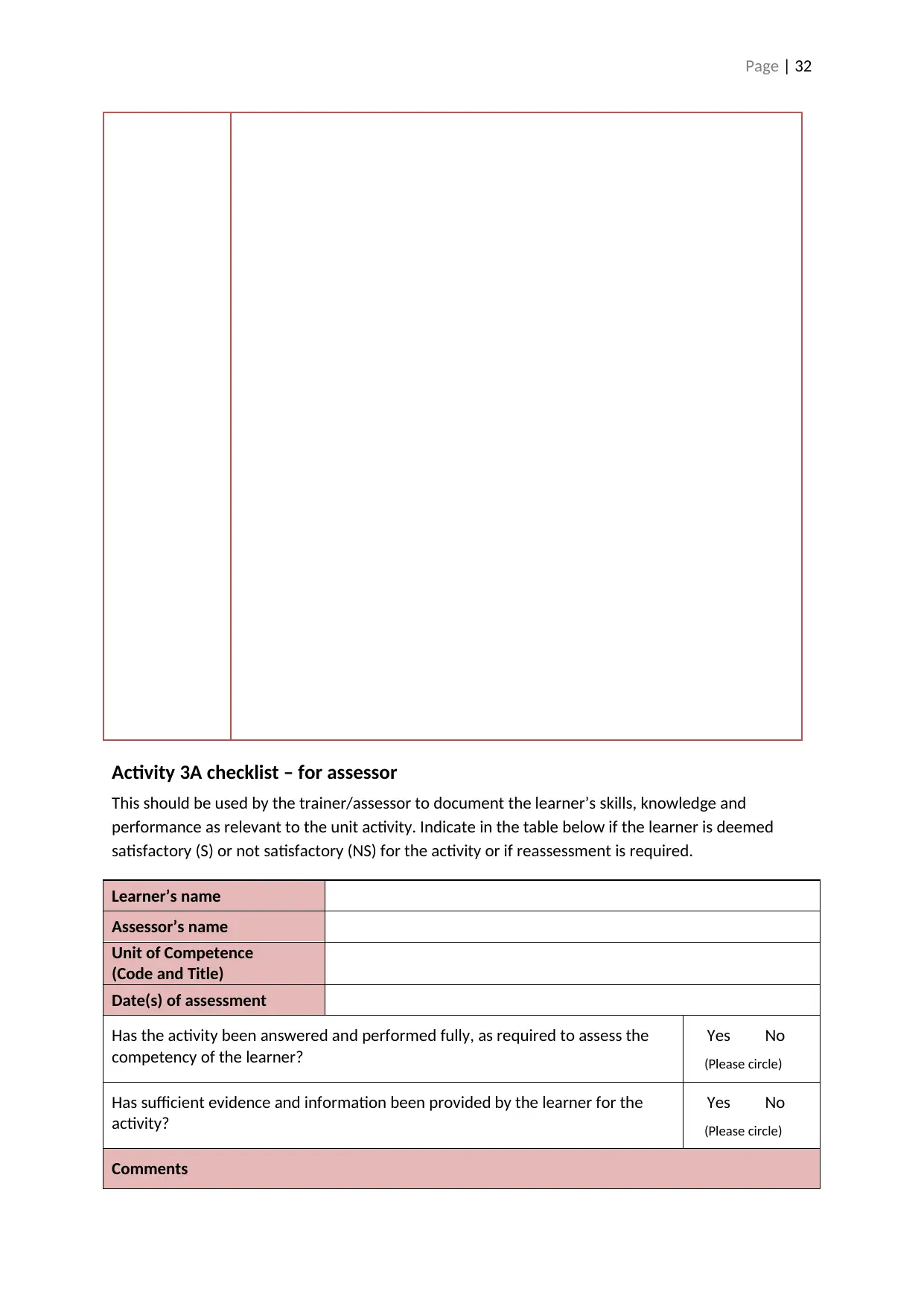
Page | 32
Activity 3A checklist – for assessor
This should be used by the trainer/assessor to document the learner’s skills, knowledge and
performance as relevant to the unit activity. Indicate in the table below if the learner is deemed
satisfactory (S) or not satisfactory (NS) for the activity or if reassessment is required.
Learner’s name
Assessor’s name
Unit of Competence
(Code and Title)
Date(s) of assessment
Has the activity been answered and performed fully, as required to assess the
competency of the learner?
Yes No
(Please circle)
Has sufficient evidence and information been provided by the learner for the
activity?
Yes No
(Please circle)
Comments
Activity 3A checklist – for assessor
This should be used by the trainer/assessor to document the learner’s skills, knowledge and
performance as relevant to the unit activity. Indicate in the table below if the learner is deemed
satisfactory (S) or not satisfactory (NS) for the activity or if reassessment is required.
Learner’s name
Assessor’s name
Unit of Competence
(Code and Title)
Date(s) of assessment
Has the activity been answered and performed fully, as required to assess the
competency of the learner?
Yes No
(Please circle)
Has sufficient evidence and information been provided by the learner for the
activity?
Yes No
(Please circle)
Comments
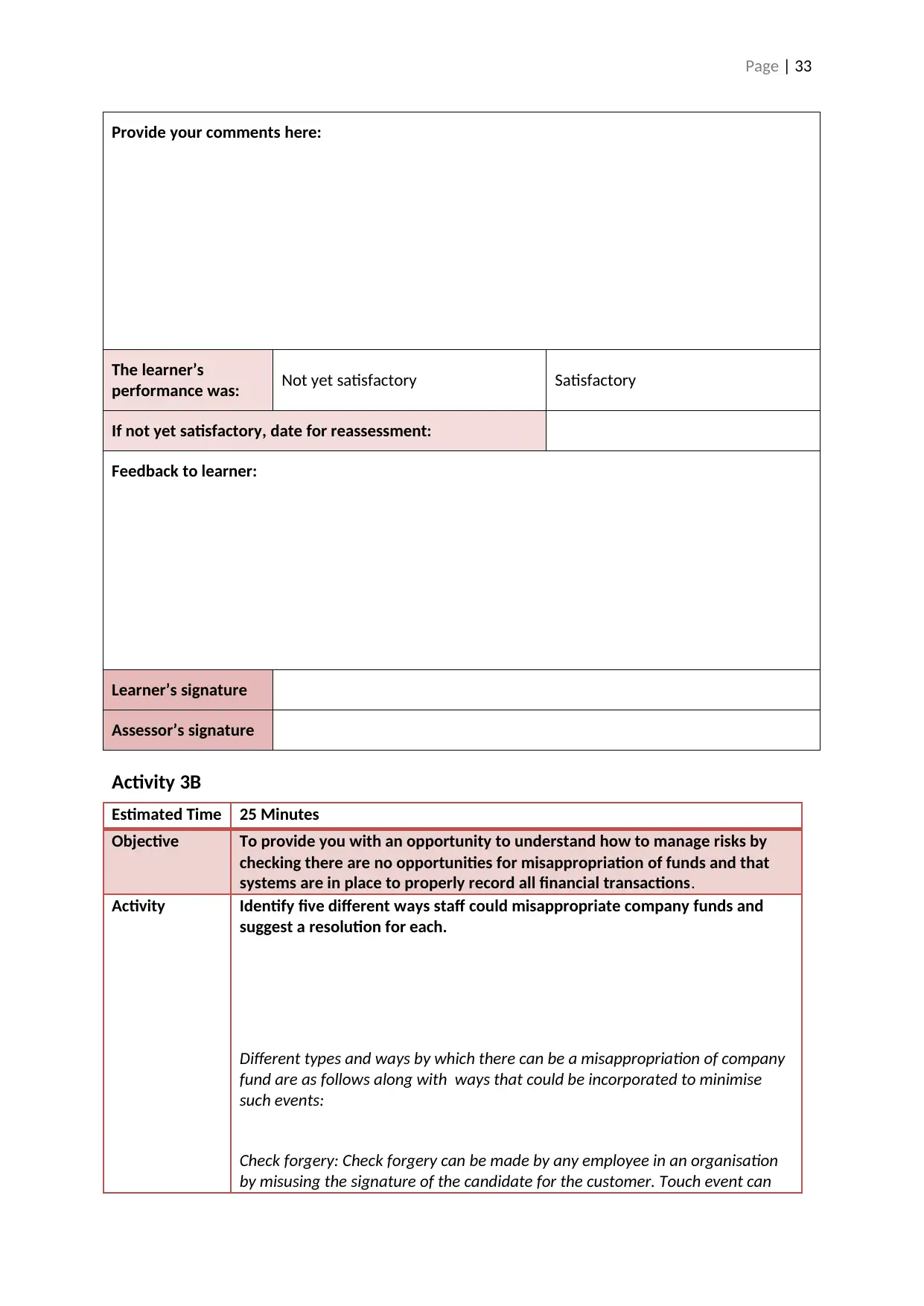
Page | 33
Provide your comments here:
The learner’s
performance was: Not yet satisfactory Satisfactory
If not yet satisfactory, date for reassessment:
Feedback to learner:
Learner’s signature
Assessor’s signature
Activity 3B
Estimated Time 25 Minutes
Objective To provide you with an opportunity to understand how to manage risks by
checking there are no opportunities for misappropriation of funds and that
systems are in place to properly record all financial transactions.
Activity Identify five different ways staff could misappropriate company funds and
suggest a resolution for each.
Different types and ways by which there can be a misappropriation of company
fund are as follows along with ways that could be incorporated to minimise
such events:
Check forgery: Check forgery can be made by any employee in an organisation
by misusing the signature of the candidate for the customer. Touch event can
Provide your comments here:
The learner’s
performance was: Not yet satisfactory Satisfactory
If not yet satisfactory, date for reassessment:
Feedback to learner:
Learner’s signature
Assessor’s signature
Activity 3B
Estimated Time 25 Minutes
Objective To provide you with an opportunity to understand how to manage risks by
checking there are no opportunities for misappropriation of funds and that
systems are in place to properly record all financial transactions.
Activity Identify five different ways staff could misappropriate company funds and
suggest a resolution for each.
Different types and ways by which there can be a misappropriation of company
fund are as follows along with ways that could be incorporated to minimise
such events:
Check forgery: Check forgery can be made by any employee in an organisation
by misusing the signature of the candidate for the customer. Touch event can
Secure Best Marks with AI Grader
Need help grading? Try our AI Grader for instant feedback on your assignments.
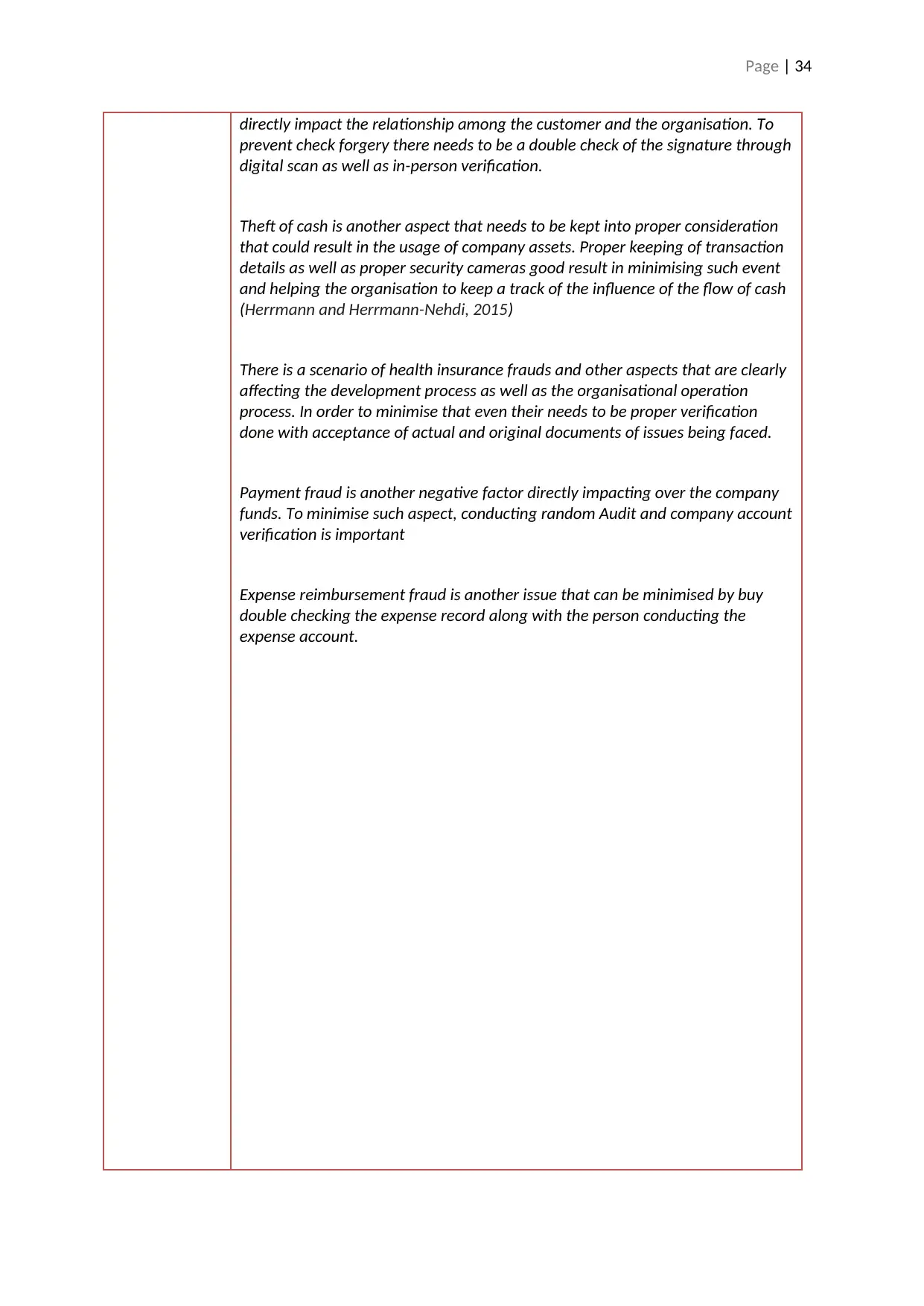
Page | 34
directly impact the relationship among the customer and the organisation. To
prevent check forgery there needs to be a double check of the signature through
digital scan as well as in-person verification.
Theft of cash is another aspect that needs to be kept into proper consideration
that could result in the usage of company assets. Proper keeping of transaction
details as well as proper security cameras good result in minimising such event
and helping the organisation to keep a track of the influence of the flow of cash
(Herrmann and Herrmann-Nehdi, 2015)
There is a scenario of health insurance frauds and other aspects that are clearly
affecting the development process as well as the organisational operation
process. In order to minimise that even their needs to be proper verification
done with acceptance of actual and original documents of issues being faced.
Payment fraud is another negative factor directly impacting over the company
funds. To minimise such aspect, conducting random Audit and company account
verification is important
Expense reimbursement fraud is another issue that can be minimised by buy
double checking the expense record along with the person conducting the
expense account.
directly impact the relationship among the customer and the organisation. To
prevent check forgery there needs to be a double check of the signature through
digital scan as well as in-person verification.
Theft of cash is another aspect that needs to be kept into proper consideration
that could result in the usage of company assets. Proper keeping of transaction
details as well as proper security cameras good result in minimising such event
and helping the organisation to keep a track of the influence of the flow of cash
(Herrmann and Herrmann-Nehdi, 2015)
There is a scenario of health insurance frauds and other aspects that are clearly
affecting the development process as well as the organisational operation
process. In order to minimise that even their needs to be proper verification
done with acceptance of actual and original documents of issues being faced.
Payment fraud is another negative factor directly impacting over the company
funds. To minimise such aspect, conducting random Audit and company account
verification is important
Expense reimbursement fraud is another issue that can be minimised by buy
double checking the expense record along with the person conducting the
expense account.
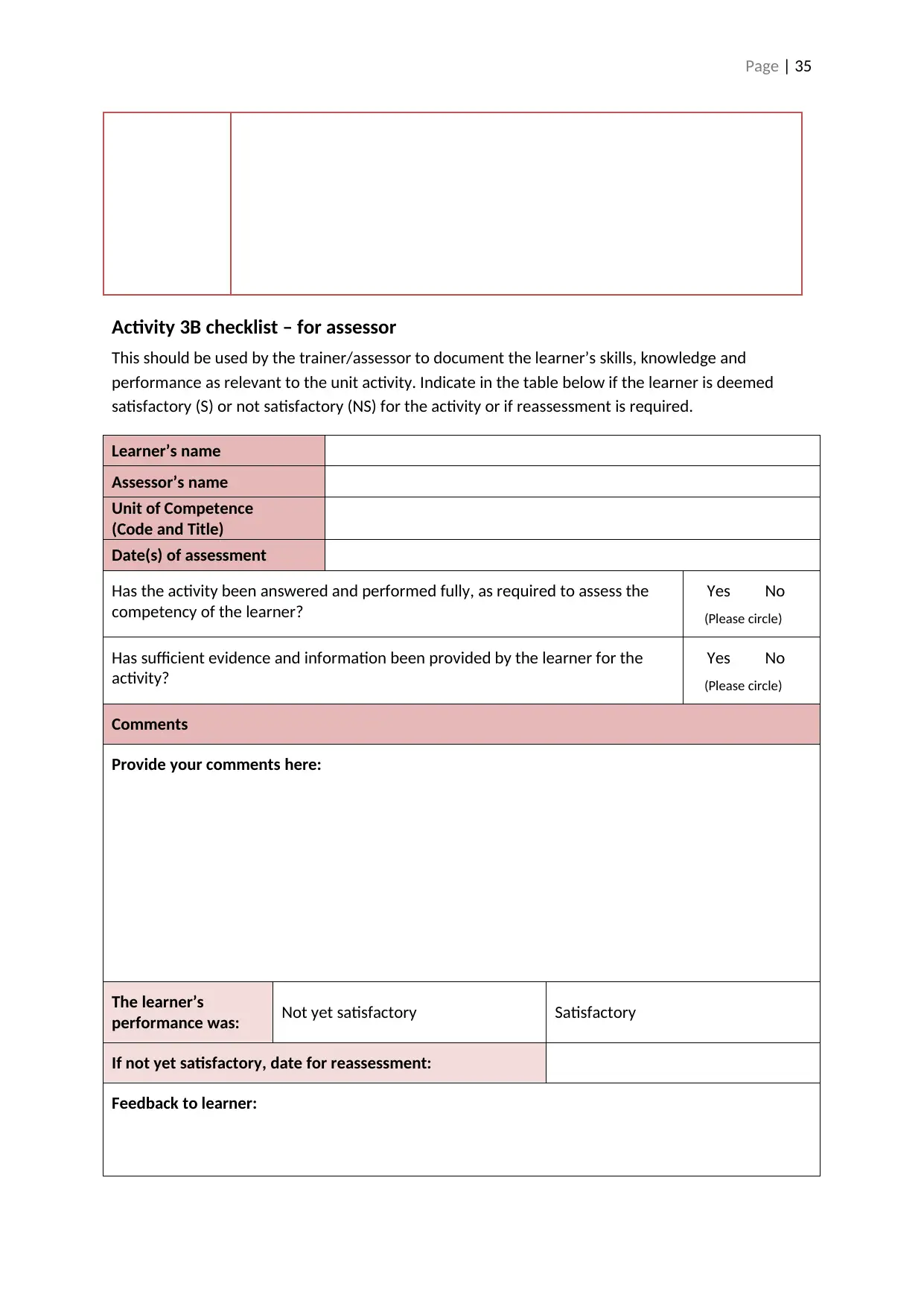
Page | 35
Activity 3B checklist – for assessor
This should be used by the trainer/assessor to document the learner’s skills, knowledge and
performance as relevant to the unit activity. Indicate in the table below if the learner is deemed
satisfactory (S) or not satisfactory (NS) for the activity or if reassessment is required.
Learner’s name
Assessor’s name
Unit of Competence
(Code and Title)
Date(s) of assessment
Has the activity been answered and performed fully, as required to assess the
competency of the learner?
Yes No
(Please circle)
Has sufficient evidence and information been provided by the learner for the
activity?
Yes No
(Please circle)
Comments
Provide your comments here:
The learner’s
performance was: Not yet satisfactory Satisfactory
If not yet satisfactory, date for reassessment:
Feedback to learner:
Activity 3B checklist – for assessor
This should be used by the trainer/assessor to document the learner’s skills, knowledge and
performance as relevant to the unit activity. Indicate in the table below if the learner is deemed
satisfactory (S) or not satisfactory (NS) for the activity or if reassessment is required.
Learner’s name
Assessor’s name
Unit of Competence
(Code and Title)
Date(s) of assessment
Has the activity been answered and performed fully, as required to assess the
competency of the learner?
Yes No
(Please circle)
Has sufficient evidence and information been provided by the learner for the
activity?
Yes No
(Please circle)
Comments
Provide your comments here:
The learner’s
performance was: Not yet satisfactory Satisfactory
If not yet satisfactory, date for reassessment:
Feedback to learner:

Page | 36
Learner’s signature
Assessor’s signature
Activity 3C
Estimated Time 20 Minutes
Objective To provide you with an opportunity to understand how to review profit and
loss statements, cash flows and ageing summaries.
Activity Explain your organisation’s use of ageing summaries, in terms of accounts
payable and receivable, where applicable.
In terms of accounts, payable ageing summaries are used to understand the
overdue. For the utilisation of gathering information related to accounts
receivable ageing prospect is it lies to understand the the days of payment
being outstanding. Proper organisation of the outstanding value is also an
important advantage that can be gathered from organisations use of ageing
summary (Zietlow, Hankin, Seidner and O'Brien, 2018).
Learner’s signature
Assessor’s signature
Activity 3C
Estimated Time 20 Minutes
Objective To provide you with an opportunity to understand how to review profit and
loss statements, cash flows and ageing summaries.
Activity Explain your organisation’s use of ageing summaries, in terms of accounts
payable and receivable, where applicable.
In terms of accounts, payable ageing summaries are used to understand the
overdue. For the utilisation of gathering information related to accounts
receivable ageing prospect is it lies to understand the the days of payment
being outstanding. Proper organisation of the outstanding value is also an
important advantage that can be gathered from organisations use of ageing
summary (Zietlow, Hankin, Seidner and O'Brien, 2018).
Paraphrase This Document
Need a fresh take? Get an instant paraphrase of this document with our AI Paraphraser

Page | 37
Activity 3C checklist – for assessor
This should be used by the trainer/assessor to document the learner’s skills, knowledge and
performance as relevant to the unit activity. Indicate in the table below if the learner is deemed
satisfactory (S) or not satisfactory (NS) for the activity or if reassessment is required.
Learner’s name
Assessor’s name
Unit of Competence
(Code and Title)
Date(s) of assessment
Has the activity been answered and performed fully, as required to assess the
competency of the learner?
Yes No
(Please circle)
Has sufficient evidence and information been provided by the learner for the
activity?
Yes No
(Please circle)
Comments
Provide your comments here:
Activity 3C checklist – for assessor
This should be used by the trainer/assessor to document the learner’s skills, knowledge and
performance as relevant to the unit activity. Indicate in the table below if the learner is deemed
satisfactory (S) or not satisfactory (NS) for the activity or if reassessment is required.
Learner’s name
Assessor’s name
Unit of Competence
(Code and Title)
Date(s) of assessment
Has the activity been answered and performed fully, as required to assess the
competency of the learner?
Yes No
(Please circle)
Has sufficient evidence and information been provided by the learner for the
activity?
Yes No
(Please circle)
Comments
Provide your comments here:
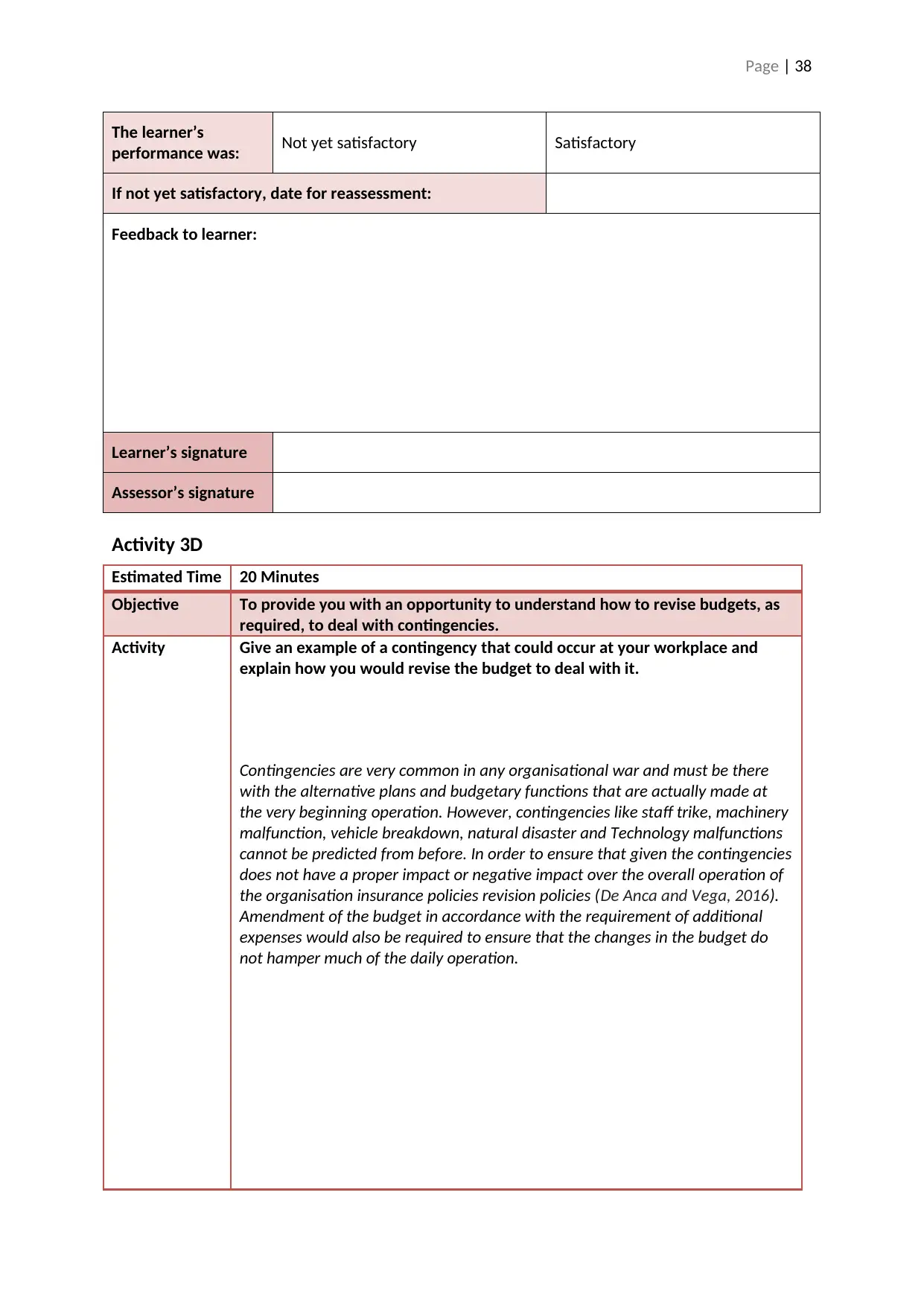
Page | 38
The learner’s
performance was: Not yet satisfactory Satisfactory
If not yet satisfactory, date for reassessment:
Feedback to learner:
Learner’s signature
Assessor’s signature
Activity 3D
Estimated Time 20 Minutes
Objective To provide you with an opportunity to understand how to revise budgets, as
required, to deal with contingencies.
Activity Give an example of a contingency that could occur at your workplace and
explain how you would revise the budget to deal with it.
Contingencies are very common in any organisational war and must be there
with the alternative plans and budgetary functions that are actually made at
the very beginning operation. However, contingencies like staff trike, machinery
malfunction, vehicle breakdown, natural disaster and Technology malfunctions
cannot be predicted from before. In order to ensure that given the contingencies
does not have a proper impact or negative impact over the overall operation of
the organisation insurance policies revision policies (De Anca and Vega, 2016).
Amendment of the budget in accordance with the requirement of additional
expenses would also be required to ensure that the changes in the budget do
not hamper much of the daily operation.
The learner’s
performance was: Not yet satisfactory Satisfactory
If not yet satisfactory, date for reassessment:
Feedback to learner:
Learner’s signature
Assessor’s signature
Activity 3D
Estimated Time 20 Minutes
Objective To provide you with an opportunity to understand how to revise budgets, as
required, to deal with contingencies.
Activity Give an example of a contingency that could occur at your workplace and
explain how you would revise the budget to deal with it.
Contingencies are very common in any organisational war and must be there
with the alternative plans and budgetary functions that are actually made at
the very beginning operation. However, contingencies like staff trike, machinery
malfunction, vehicle breakdown, natural disaster and Technology malfunctions
cannot be predicted from before. In order to ensure that given the contingencies
does not have a proper impact or negative impact over the overall operation of
the organisation insurance policies revision policies (De Anca and Vega, 2016).
Amendment of the budget in accordance with the requirement of additional
expenses would also be required to ensure that the changes in the budget do
not hamper much of the daily operation.
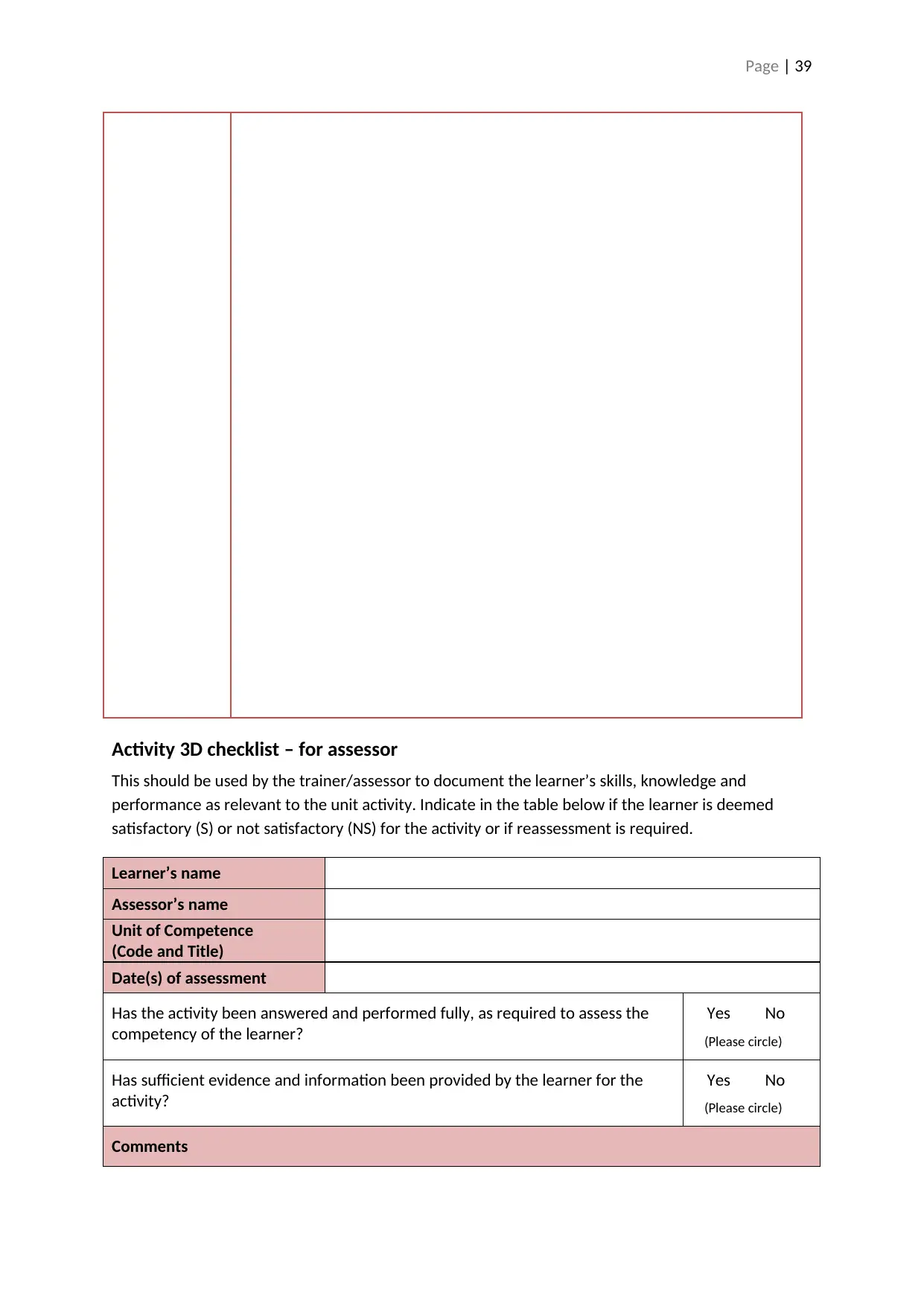
Page | 39
Activity 3D checklist – for assessor
This should be used by the trainer/assessor to document the learner’s skills, knowledge and
performance as relevant to the unit activity. Indicate in the table below if the learner is deemed
satisfactory (S) or not satisfactory (NS) for the activity or if reassessment is required.
Learner’s name
Assessor’s name
Unit of Competence
(Code and Title)
Date(s) of assessment
Has the activity been answered and performed fully, as required to assess the
competency of the learner?
Yes No
(Please circle)
Has sufficient evidence and information been provided by the learner for the
activity?
Yes No
(Please circle)
Comments
Activity 3D checklist – for assessor
This should be used by the trainer/assessor to document the learner’s skills, knowledge and
performance as relevant to the unit activity. Indicate in the table below if the learner is deemed
satisfactory (S) or not satisfactory (NS) for the activity or if reassessment is required.
Learner’s name
Assessor’s name
Unit of Competence
(Code and Title)
Date(s) of assessment
Has the activity been answered and performed fully, as required to assess the
competency of the learner?
Yes No
(Please circle)
Has sufficient evidence and information been provided by the learner for the
activity?
Yes No
(Please circle)
Comments
Secure Best Marks with AI Grader
Need help grading? Try our AI Grader for instant feedback on your assignments.
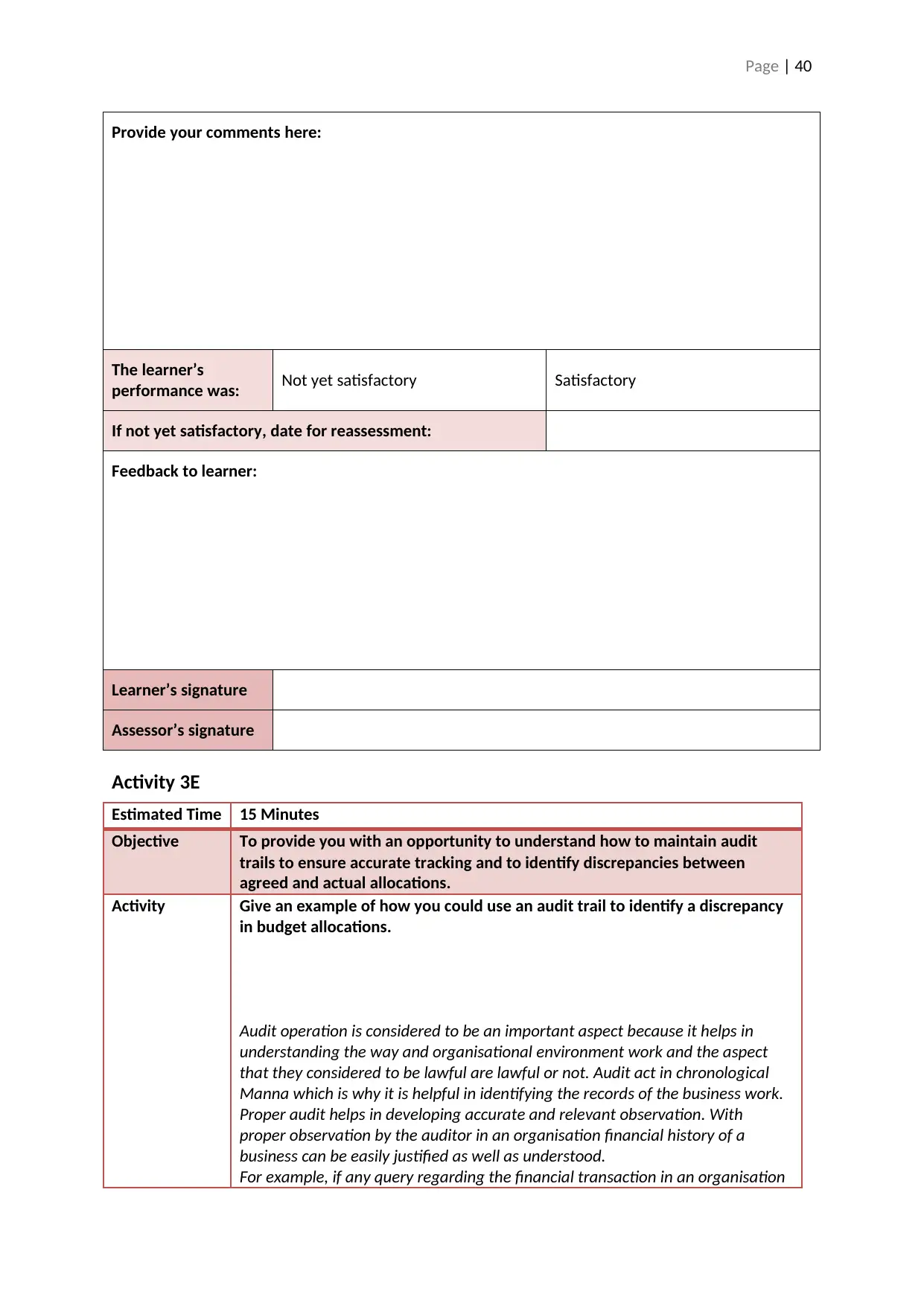
Page | 40
Provide your comments here:
The learner’s
performance was: Not yet satisfactory Satisfactory
If not yet satisfactory, date for reassessment:
Feedback to learner:
Learner’s signature
Assessor’s signature
Activity 3E
Estimated Time 15 Minutes
Objective To provide you with an opportunity to understand how to maintain audit
trails to ensure accurate tracking and to identify discrepancies between
agreed and actual allocations.
Activity Give an example of how you could use an audit trail to identify a discrepancy
in budget allocations.
Audit operation is considered to be an important aspect because it helps in
understanding the way and organisational environment work and the aspect
that they considered to be lawful are lawful or not. Audit act in chronological
Manna which is why it is helpful in identifying the records of the business work.
Proper audit helps in developing accurate and relevant observation. With
proper observation by the auditor in an organisation financial history of a
business can be easily justified as well as understood.
For example, if any query regarding the financial transaction in an organisation
Provide your comments here:
The learner’s
performance was: Not yet satisfactory Satisfactory
If not yet satisfactory, date for reassessment:
Feedback to learner:
Learner’s signature
Assessor’s signature
Activity 3E
Estimated Time 15 Minutes
Objective To provide you with an opportunity to understand how to maintain audit
trails to ensure accurate tracking and to identify discrepancies between
agreed and actual allocations.
Activity Give an example of how you could use an audit trail to identify a discrepancy
in budget allocations.
Audit operation is considered to be an important aspect because it helps in
understanding the way and organisational environment work and the aspect
that they considered to be lawful are lawful or not. Audit act in chronological
Manna which is why it is helpful in identifying the records of the business work.
Proper audit helps in developing accurate and relevant observation. With
proper observation by the auditor in an organisation financial history of a
business can be easily justified as well as understood.
For example, if any query regarding the financial transaction in an organisation
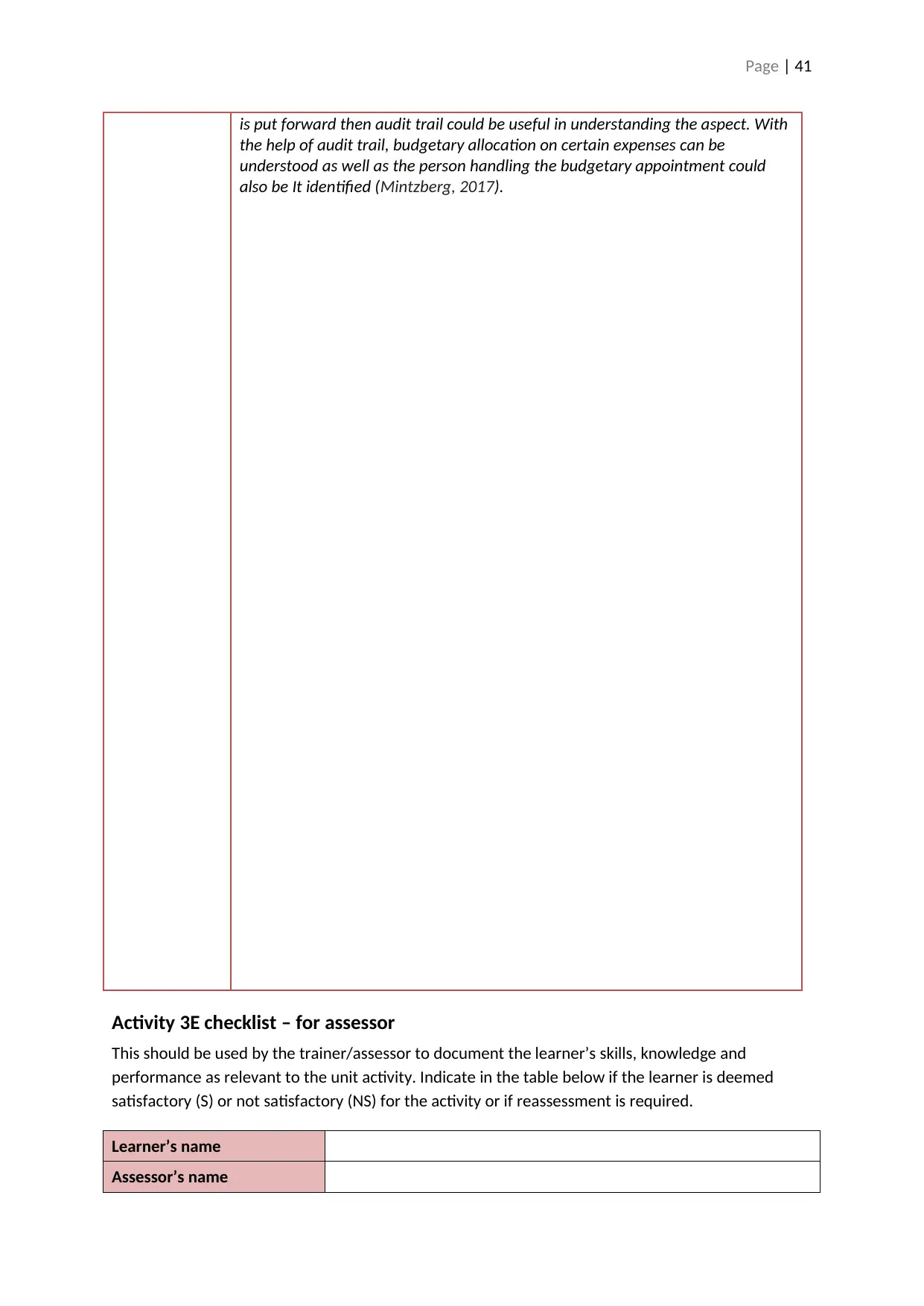
Page | 41
is put forward then audit trail could be useful in understanding the aspect. With
the help of audit trail, budgetary allocation on certain expenses can be
understood as well as the person handling the budgetary appointment could
also be It identified (Mintzberg, 2017).
Activity 3E checklist – for assessor
This should be used by the trainer/assessor to document the learner’s skills, knowledge and
performance as relevant to the unit activity. Indicate in the table below if the learner is deemed
satisfactory (S) or not satisfactory (NS) for the activity or if reassessment is required.
Learner’s name
Assessor’s name
is put forward then audit trail could be useful in understanding the aspect. With
the help of audit trail, budgetary allocation on certain expenses can be
understood as well as the person handling the budgetary appointment could
also be It identified (Mintzberg, 2017).
Activity 3E checklist – for assessor
This should be used by the trainer/assessor to document the learner’s skills, knowledge and
performance as relevant to the unit activity. Indicate in the table below if the learner is deemed
satisfactory (S) or not satisfactory (NS) for the activity or if reassessment is required.
Learner’s name
Assessor’s name

Page | 42
Unit of Competence
(Code and Title)
Date(s) of assessment
Has the activity been answered and performed fully, as required to assess the
competency of the learner?
Yes No
(Please circle)
Has sufficient evidence and information been provided by the learner for the
activity?
Yes No
(Please circle)
Comments
Provide your comments here:
The learner’s
performance was: Not yet satisfactory Satisfactory
If not yet satisfactory, date for reassessment:
Feedback to learner:
Learner’s signature
Assessor’s signature
Activity 3F
Estimated Time 30 Minutes
Objective To provide you with an opportunity to understand how to ensure compliance
with due diligence.
Activity Identify three areas of compliance you could monitor in your workplace and
explain how you would ensure that regulations are being adhered to.
Unit of Competence
(Code and Title)
Date(s) of assessment
Has the activity been answered and performed fully, as required to assess the
competency of the learner?
Yes No
(Please circle)
Has sufficient evidence and information been provided by the learner for the
activity?
Yes No
(Please circle)
Comments
Provide your comments here:
The learner’s
performance was: Not yet satisfactory Satisfactory
If not yet satisfactory, date for reassessment:
Feedback to learner:
Learner’s signature
Assessor’s signature
Activity 3F
Estimated Time 30 Minutes
Objective To provide you with an opportunity to understand how to ensure compliance
with due diligence.
Activity Identify three areas of compliance you could monitor in your workplace and
explain how you would ensure that regulations are being adhered to.
Paraphrase This Document
Need a fresh take? Get an instant paraphrase of this document with our AI Paraphraser
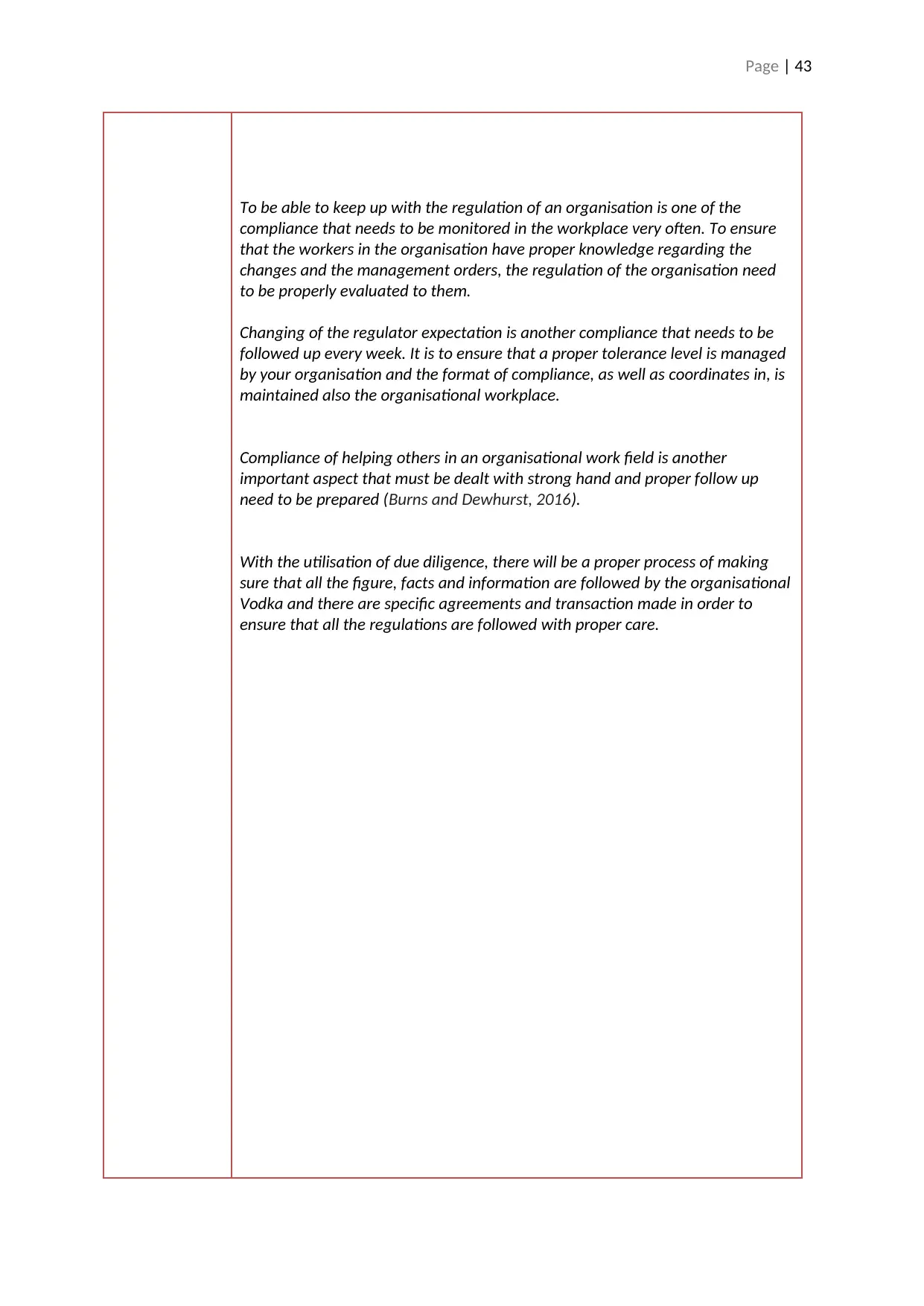
Page | 43
To be able to keep up with the regulation of an organisation is one of the
compliance that needs to be monitored in the workplace very often. To ensure
that the workers in the organisation have proper knowledge regarding the
changes and the management orders, the regulation of the organisation need
to be properly evaluated to them.
Changing of the regulator expectation is another compliance that needs to be
followed up every week. It is to ensure that a proper tolerance level is managed
by your organisation and the format of compliance, as well as coordinates in, is
maintained also the organisational workplace.
Compliance of helping others in an organisational work field is another
important aspect that must be dealt with strong hand and proper follow up
need to be prepared (Burns and Dewhurst, 2016).
With the utilisation of due diligence, there will be a proper process of making
sure that all the figure, facts and information are followed by the organisational
Vodka and there are specific agreements and transaction made in order to
ensure that all the regulations are followed with proper care.
To be able to keep up with the regulation of an organisation is one of the
compliance that needs to be monitored in the workplace very often. To ensure
that the workers in the organisation have proper knowledge regarding the
changes and the management orders, the regulation of the organisation need
to be properly evaluated to them.
Changing of the regulator expectation is another compliance that needs to be
followed up every week. It is to ensure that a proper tolerance level is managed
by your organisation and the format of compliance, as well as coordinates in, is
maintained also the organisational workplace.
Compliance of helping others in an organisational work field is another
important aspect that must be dealt with strong hand and proper follow up
need to be prepared (Burns and Dewhurst, 2016).
With the utilisation of due diligence, there will be a proper process of making
sure that all the figure, facts and information are followed by the organisational
Vodka and there are specific agreements and transaction made in order to
ensure that all the regulations are followed with proper care.
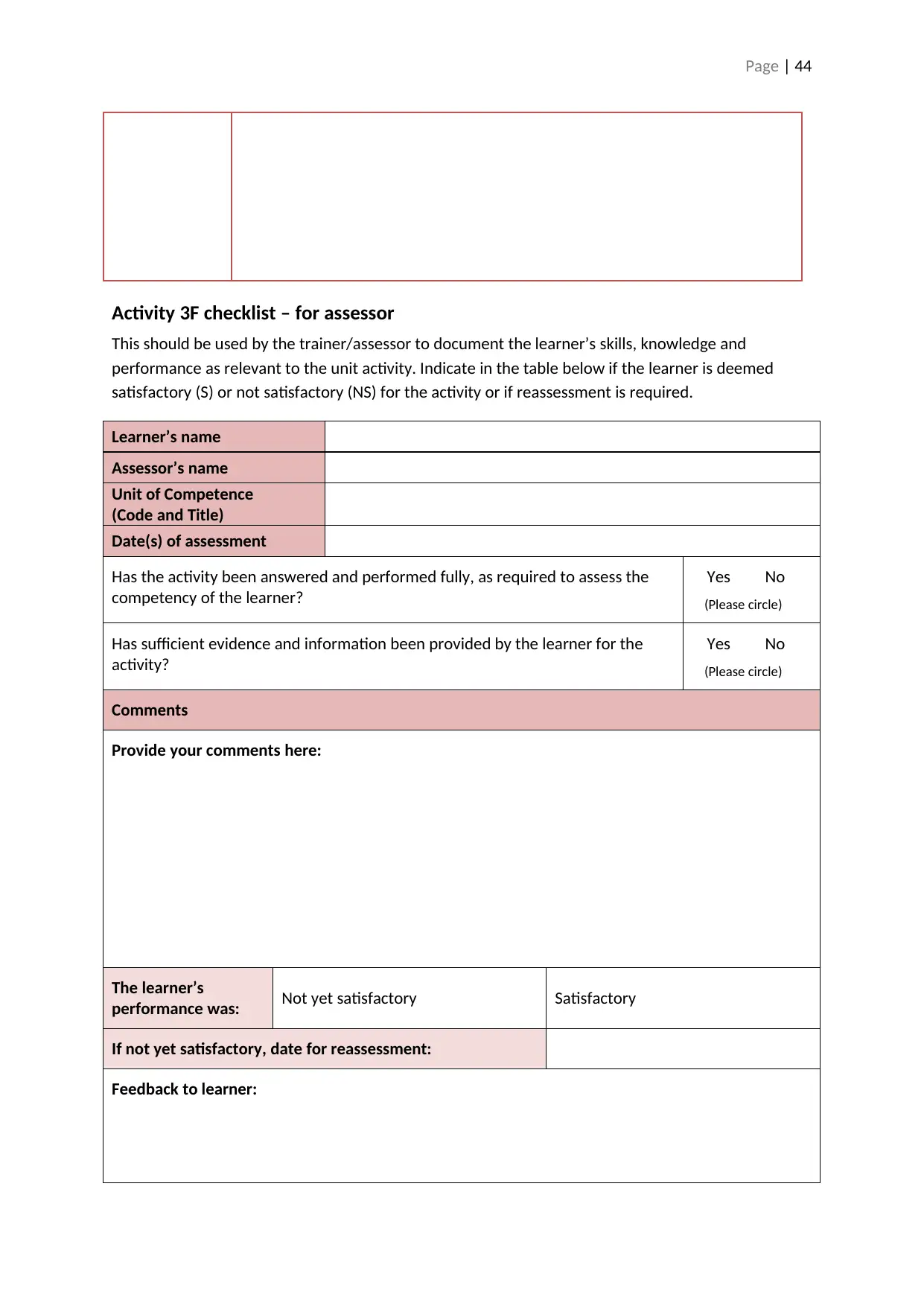
Page | 44
Activity 3F checklist – for assessor
This should be used by the trainer/assessor to document the learner’s skills, knowledge and
performance as relevant to the unit activity. Indicate in the table below if the learner is deemed
satisfactory (S) or not satisfactory (NS) for the activity or if reassessment is required.
Learner’s name
Assessor’s name
Unit of Competence
(Code and Title)
Date(s) of assessment
Has the activity been answered and performed fully, as required to assess the
competency of the learner?
Yes No
(Please circle)
Has sufficient evidence and information been provided by the learner for the
activity?
Yes No
(Please circle)
Comments
Provide your comments here:
The learner’s
performance was: Not yet satisfactory Satisfactory
If not yet satisfactory, date for reassessment:
Feedback to learner:
Activity 3F checklist – for assessor
This should be used by the trainer/assessor to document the learner’s skills, knowledge and
performance as relevant to the unit activity. Indicate in the table below if the learner is deemed
satisfactory (S) or not satisfactory (NS) for the activity or if reassessment is required.
Learner’s name
Assessor’s name
Unit of Competence
(Code and Title)
Date(s) of assessment
Has the activity been answered and performed fully, as required to assess the
competency of the learner?
Yes No
(Please circle)
Has sufficient evidence and information been provided by the learner for the
activity?
Yes No
(Please circle)
Comments
Provide your comments here:
The learner’s
performance was: Not yet satisfactory Satisfactory
If not yet satisfactory, date for reassessment:
Feedback to learner:

Page | 45
Learner’s signature
Assessor’s signature
Activity 4A
Estimated Time 15 Minutes
Objective To provide you with an opportunity to ensure structure and format of reports
are clear and conform to organisational and statutory requirements.
Activity Identify a report used in your workplace and list all of your organisation’s
specifications here, including format and style.
The report that is utilised in the organisation cannot be properly provided in
front of all League use how about the information that is generally used in the
format of the interim process are as follows:
In consideration of organisational requirement the usage of correct information,
organisational form and letterhead papers are used. When looking into the
information of the organisation, timeless format, layout format and recipient
order ids are applied.
Other formats like vertical or horizontal are utilised in terms of Statutory forms,
financial year report, spreadsheets, cash flow statement, audit, balance sheet,
electronic form and operating statement
Learner’s signature
Assessor’s signature
Activity 4A
Estimated Time 15 Minutes
Objective To provide you with an opportunity to ensure structure and format of reports
are clear and conform to organisational and statutory requirements.
Activity Identify a report used in your workplace and list all of your organisation’s
specifications here, including format and style.
The report that is utilised in the organisation cannot be properly provided in
front of all League use how about the information that is generally used in the
format of the interim process are as follows:
In consideration of organisational requirement the usage of correct information,
organisational form and letterhead papers are used. When looking into the
information of the organisation, timeless format, layout format and recipient
order ids are applied.
Other formats like vertical or horizontal are utilised in terms of Statutory forms,
financial year report, spreadsheets, cash flow statement, audit, balance sheet,
electronic form and operating statement
Secure Best Marks with AI Grader
Need help grading? Try our AI Grader for instant feedback on your assignments.
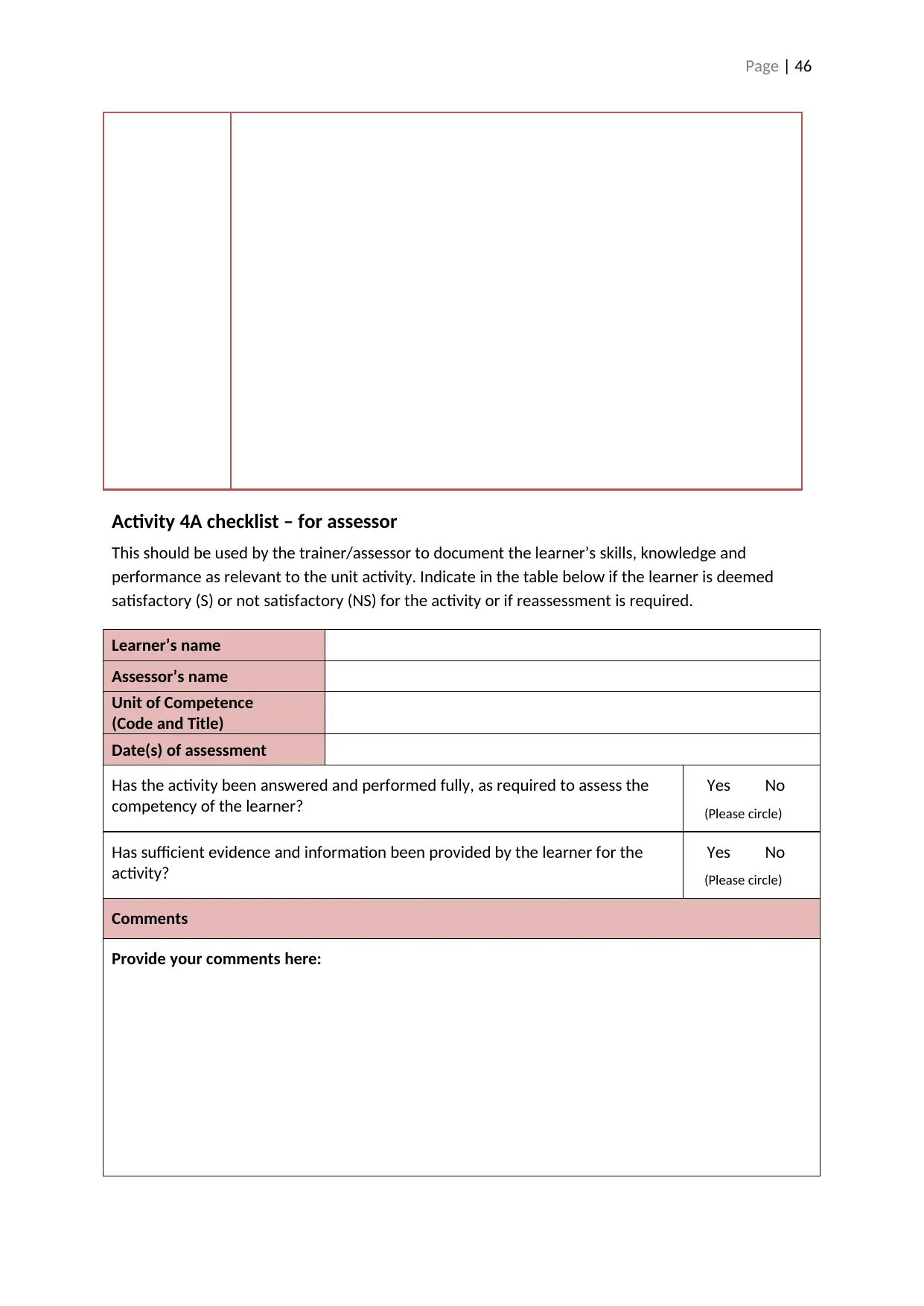
Page | 46
Activity 4A checklist – for assessor
This should be used by the trainer/assessor to document the learner’s skills, knowledge and
performance as relevant to the unit activity. Indicate in the table below if the learner is deemed
satisfactory (S) or not satisfactory (NS) for the activity or if reassessment is required.
Learner’s name
Assessor’s name
Unit of Competence
(Code and Title)
Date(s) of assessment
Has the activity been answered and performed fully, as required to assess the
competency of the learner?
Yes No
(Please circle)
Has sufficient evidence and information been provided by the learner for the
activity?
Yes No
(Please circle)
Comments
Provide your comments here:
Activity 4A checklist – for assessor
This should be used by the trainer/assessor to document the learner’s skills, knowledge and
performance as relevant to the unit activity. Indicate in the table below if the learner is deemed
satisfactory (S) or not satisfactory (NS) for the activity or if reassessment is required.
Learner’s name
Assessor’s name
Unit of Competence
(Code and Title)
Date(s) of assessment
Has the activity been answered and performed fully, as required to assess the
competency of the learner?
Yes No
(Please circle)
Has sufficient evidence and information been provided by the learner for the
activity?
Yes No
(Please circle)
Comments
Provide your comments here:
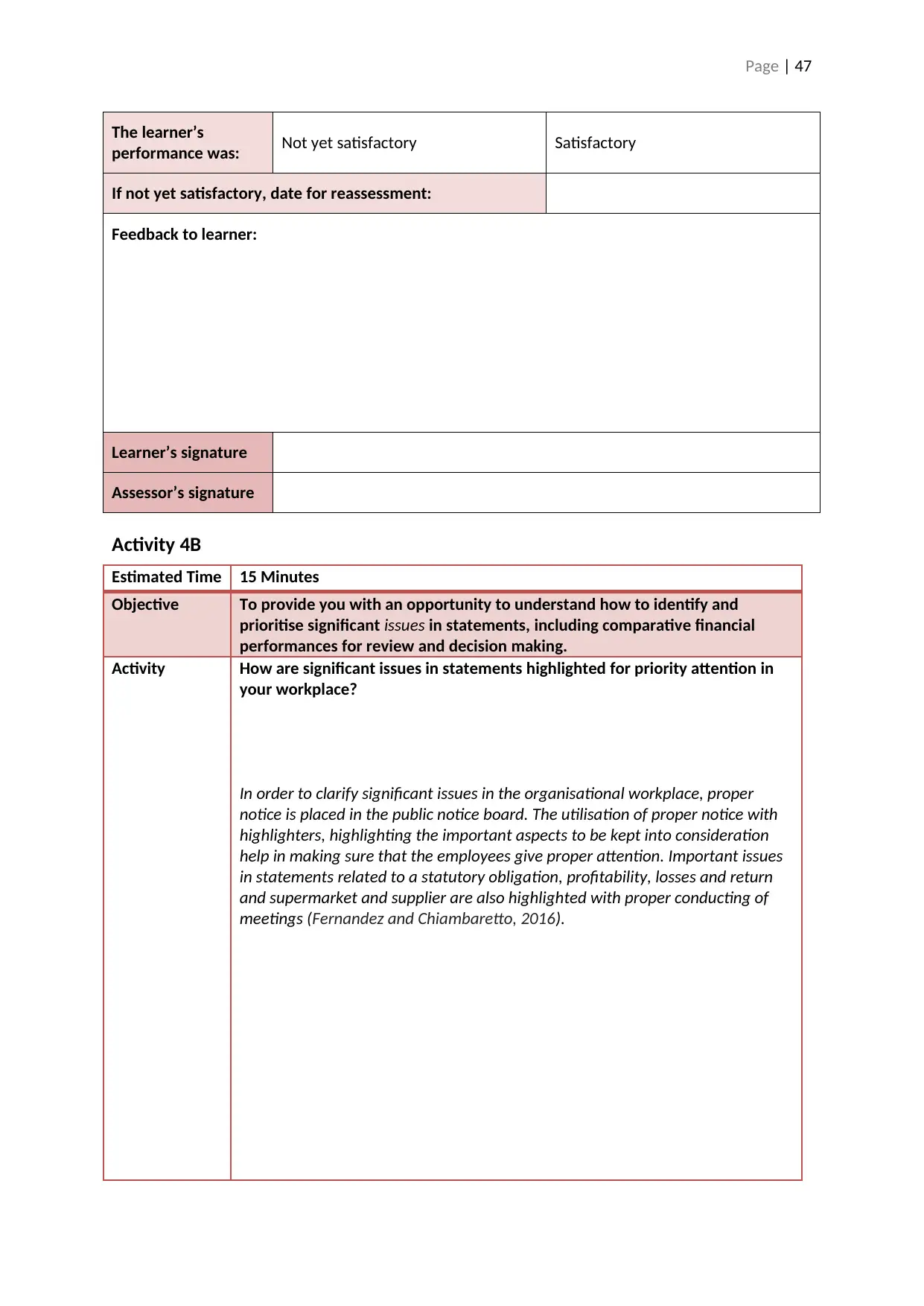
Page | 47
The learner’s
performance was: Not yet satisfactory Satisfactory
If not yet satisfactory, date for reassessment:
Feedback to learner:
Learner’s signature
Assessor’s signature
Activity 4B
Estimated Time 15 Minutes
Objective To provide you with an opportunity to understand how to identify and
prioritise significant issues in statements, including comparative financial
performances for review and decision making.
Activity How are significant issues in statements highlighted for priority attention in
your workplace?
In order to clarify significant issues in the organisational workplace, proper
notice is placed in the public notice board. The utilisation of proper notice with
highlighters, highlighting the important aspects to be kept into consideration
help in making sure that the employees give proper attention. Important issues
in statements related to a statutory obligation, profitability, losses and return
and supermarket and supplier are also highlighted with proper conducting of
meetings (Fernandez and Chiambaretto, 2016).
The learner’s
performance was: Not yet satisfactory Satisfactory
If not yet satisfactory, date for reassessment:
Feedback to learner:
Learner’s signature
Assessor’s signature
Activity 4B
Estimated Time 15 Minutes
Objective To provide you with an opportunity to understand how to identify and
prioritise significant issues in statements, including comparative financial
performances for review and decision making.
Activity How are significant issues in statements highlighted for priority attention in
your workplace?
In order to clarify significant issues in the organisational workplace, proper
notice is placed in the public notice board. The utilisation of proper notice with
highlighters, highlighting the important aspects to be kept into consideration
help in making sure that the employees give proper attention. Important issues
in statements related to a statutory obligation, profitability, losses and return
and supermarket and supplier are also highlighted with proper conducting of
meetings (Fernandez and Chiambaretto, 2016).
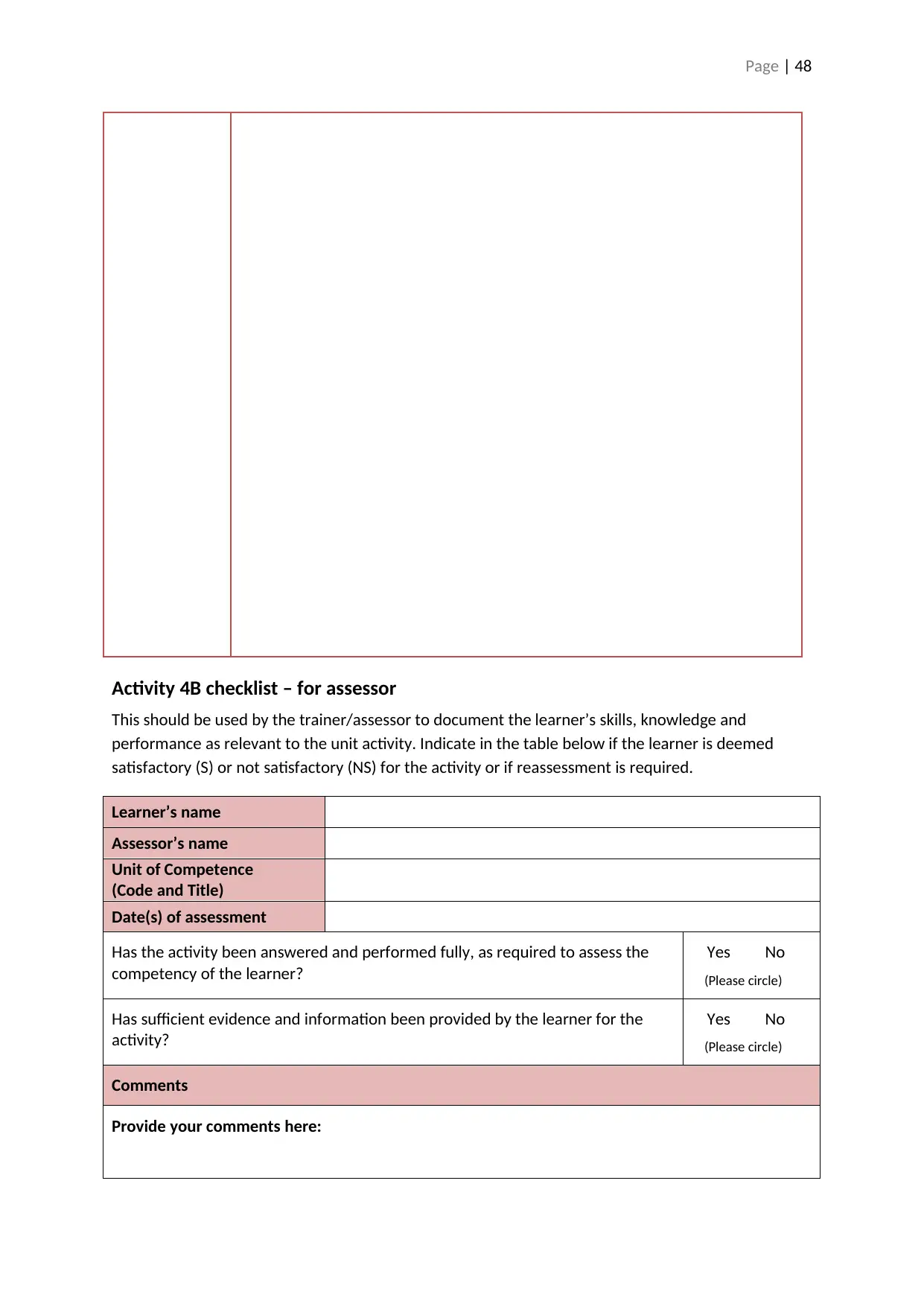
Page | 48
Activity 4B checklist – for assessor
This should be used by the trainer/assessor to document the learner’s skills, knowledge and
performance as relevant to the unit activity. Indicate in the table below if the learner is deemed
satisfactory (S) or not satisfactory (NS) for the activity or if reassessment is required.
Learner’s name
Assessor’s name
Unit of Competence
(Code and Title)
Date(s) of assessment
Has the activity been answered and performed fully, as required to assess the
competency of the learner?
Yes No
(Please circle)
Has sufficient evidence and information been provided by the learner for the
activity?
Yes No
(Please circle)
Comments
Provide your comments here:
Activity 4B checklist – for assessor
This should be used by the trainer/assessor to document the learner’s skills, knowledge and
performance as relevant to the unit activity. Indicate in the table below if the learner is deemed
satisfactory (S) or not satisfactory (NS) for the activity or if reassessment is required.
Learner’s name
Assessor’s name
Unit of Competence
(Code and Title)
Date(s) of assessment
Has the activity been answered and performed fully, as required to assess the
competency of the learner?
Yes No
(Please circle)
Has sufficient evidence and information been provided by the learner for the
activity?
Yes No
(Please circle)
Comments
Provide your comments here:
Paraphrase This Document
Need a fresh take? Get an instant paraphrase of this document with our AI Paraphraser
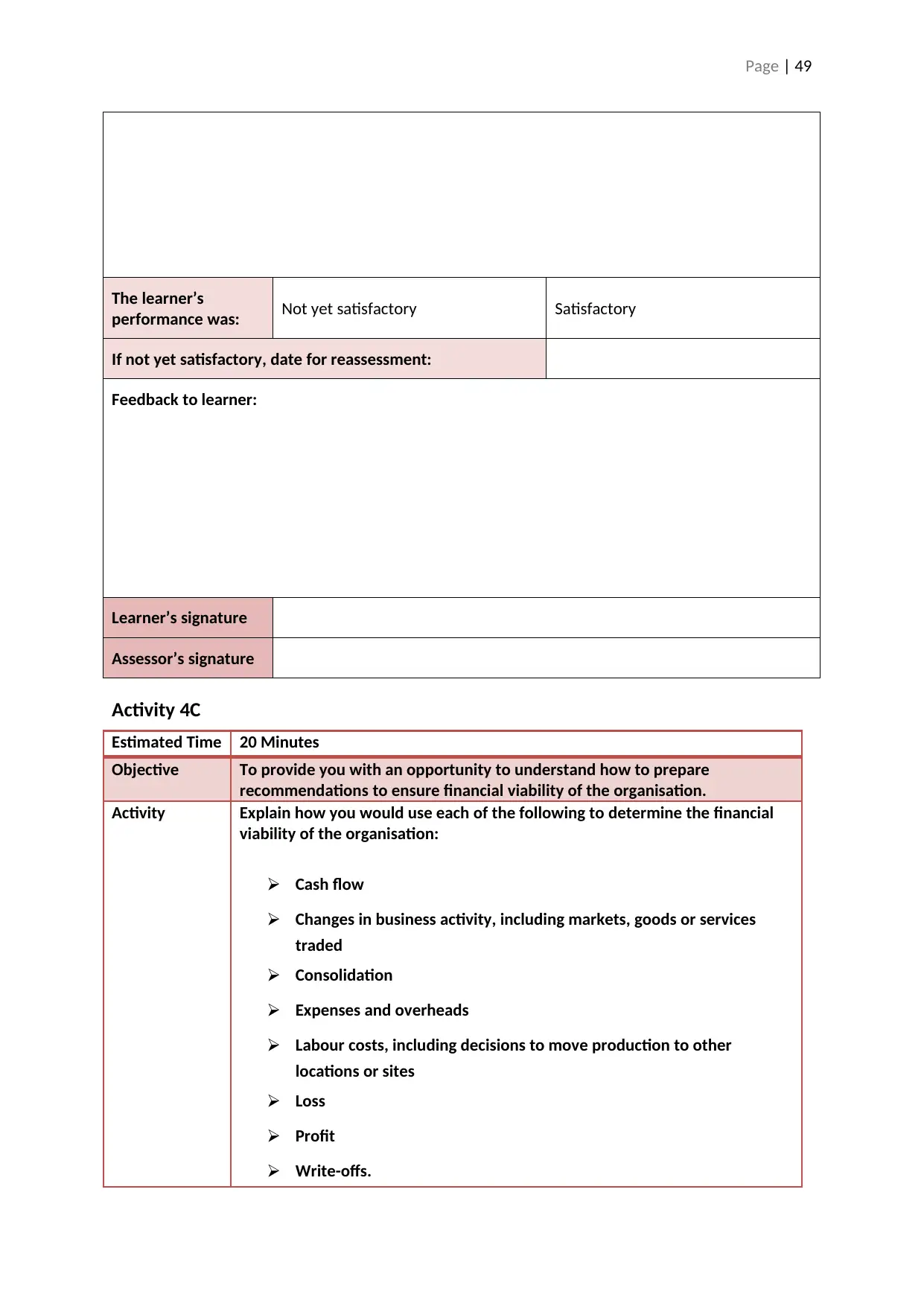
Page | 49
The learner’s
performance was: Not yet satisfactory Satisfactory
If not yet satisfactory, date for reassessment:
Feedback to learner:
Learner’s signature
Assessor’s signature
Activity 4C
Estimated Time 20 Minutes
Objective To provide you with an opportunity to understand how to prepare
recommendations to ensure financial viability of the organisation.
Activity Explain how you would use each of the following to determine the financial
viability of the organisation:
⮚ Cash flow
⮚ Changes in business activity, including markets, goods or services
traded
⮚ Consolidation
⮚ Expenses and overheads
⮚ Labour costs, including decisions to move production to other
locations or sites
⮚ Loss
⮚ Profit
⮚ Write-offs.
The learner’s
performance was: Not yet satisfactory Satisfactory
If not yet satisfactory, date for reassessment:
Feedback to learner:
Learner’s signature
Assessor’s signature
Activity 4C
Estimated Time 20 Minutes
Objective To provide you with an opportunity to understand how to prepare
recommendations to ensure financial viability of the organisation.
Activity Explain how you would use each of the following to determine the financial
viability of the organisation:
⮚ Cash flow
⮚ Changes in business activity, including markets, goods or services
traded
⮚ Consolidation
⮚ Expenses and overheads
⮚ Labour costs, including decisions to move production to other
locations or sites
⮚ Loss
⮚ Profit
⮚ Write-offs.
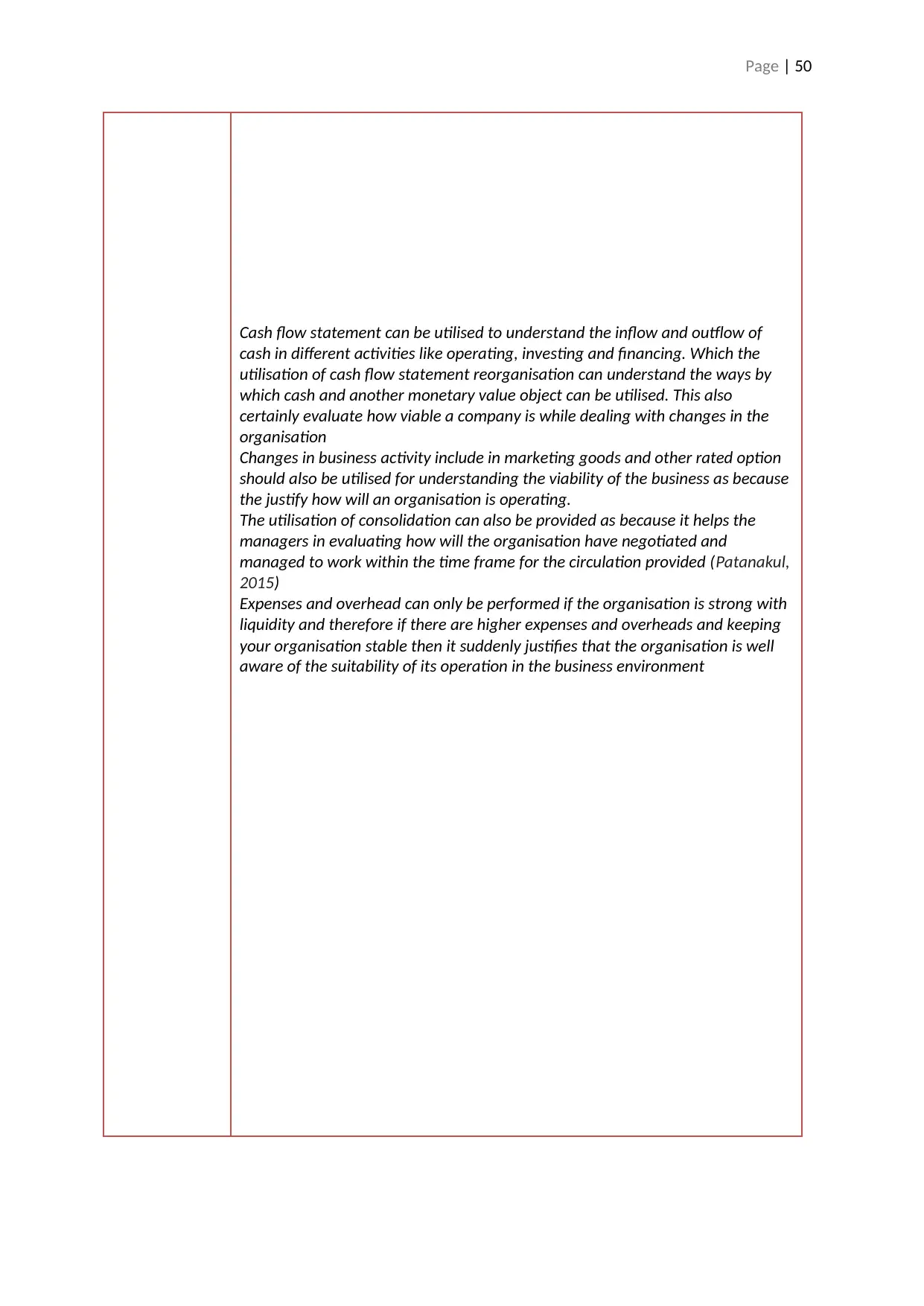
Page | 50
Cash flow statement can be utilised to understand the inflow and outflow of
cash in different activities like operating, investing and financing. Which the
utilisation of cash flow statement reorganisation can understand the ways by
which cash and another monetary value object can be utilised. This also
certainly evaluate how viable a company is while dealing with changes in the
organisation
Changes in business activity include in marketing goods and other rated option
should also be utilised for understanding the viability of the business as because
the justify how will an organisation is operating.
The utilisation of consolidation can also be provided as because it helps the
managers in evaluating how will the organisation have negotiated and
managed to work within the time frame for the circulation provided (Patanakul,
2015)
Expenses and overhead can only be performed if the organisation is strong with
liquidity and therefore if there are higher expenses and overheads and keeping
your organisation stable then it suddenly justifies that the organisation is well
aware of the suitability of its operation in the business environment
Cash flow statement can be utilised to understand the inflow and outflow of
cash in different activities like operating, investing and financing. Which the
utilisation of cash flow statement reorganisation can understand the ways by
which cash and another monetary value object can be utilised. This also
certainly evaluate how viable a company is while dealing with changes in the
organisation
Changes in business activity include in marketing goods and other rated option
should also be utilised for understanding the viability of the business as because
the justify how will an organisation is operating.
The utilisation of consolidation can also be provided as because it helps the
managers in evaluating how will the organisation have negotiated and
managed to work within the time frame for the circulation provided (Patanakul,
2015)
Expenses and overhead can only be performed if the organisation is strong with
liquidity and therefore if there are higher expenses and overheads and keeping
your organisation stable then it suddenly justifies that the organisation is well
aware of the suitability of its operation in the business environment
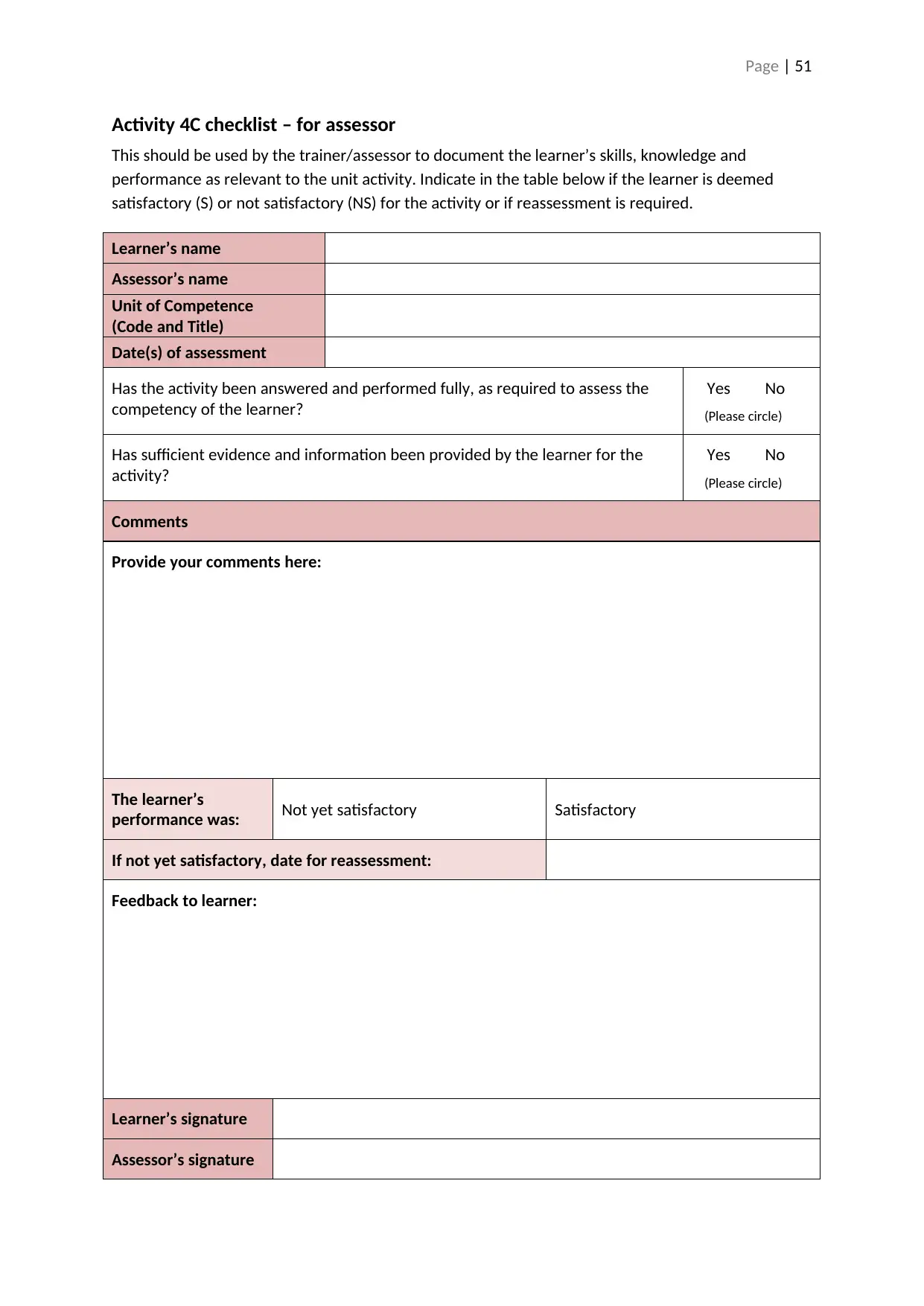
Page | 51
Activity 4C checklist – for assessor
This should be used by the trainer/assessor to document the learner’s skills, knowledge and
performance as relevant to the unit activity. Indicate in the table below if the learner is deemed
satisfactory (S) or not satisfactory (NS) for the activity or if reassessment is required.
Learner’s name
Assessor’s name
Unit of Competence
(Code and Title)
Date(s) of assessment
Has the activity been answered and performed fully, as required to assess the
competency of the learner?
Yes No
(Please circle)
Has sufficient evidence and information been provided by the learner for the
activity?
Yes No
(Please circle)
Comments
Provide your comments here:
The learner’s
performance was: Not yet satisfactory Satisfactory
If not yet satisfactory, date for reassessment:
Feedback to learner:
Learner’s signature
Assessor’s signature
Activity 4C checklist – for assessor
This should be used by the trainer/assessor to document the learner’s skills, knowledge and
performance as relevant to the unit activity. Indicate in the table below if the learner is deemed
satisfactory (S) or not satisfactory (NS) for the activity or if reassessment is required.
Learner’s name
Assessor’s name
Unit of Competence
(Code and Title)
Date(s) of assessment
Has the activity been answered and performed fully, as required to assess the
competency of the learner?
Yes No
(Please circle)
Has sufficient evidence and information been provided by the learner for the
activity?
Yes No
(Please circle)
Comments
Provide your comments here:
The learner’s
performance was: Not yet satisfactory Satisfactory
If not yet satisfactory, date for reassessment:
Feedback to learner:
Learner’s signature
Assessor’s signature
Secure Best Marks with AI Grader
Need help grading? Try our AI Grader for instant feedback on your assignments.
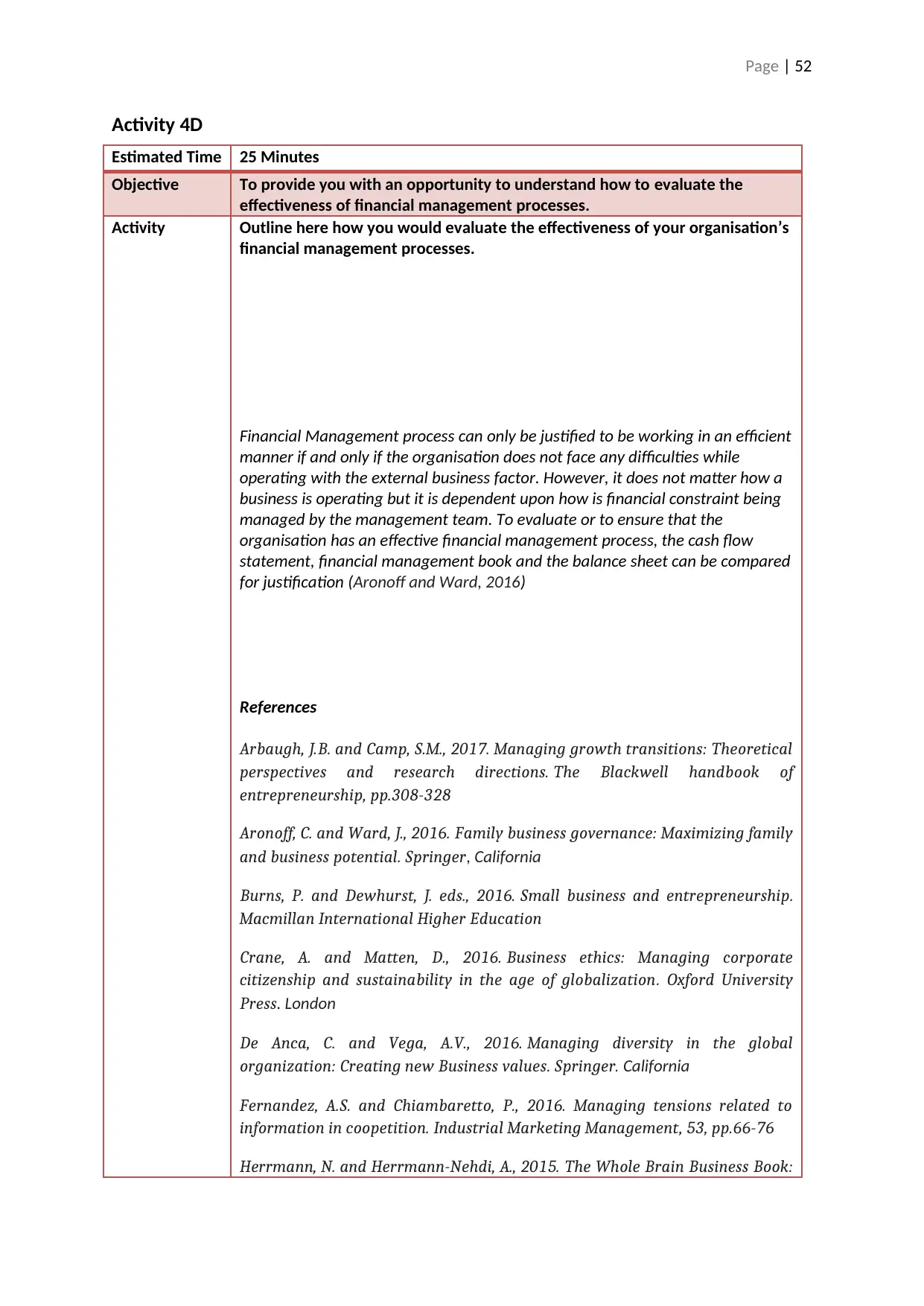
Page | 52
Activity 4D
Estimated Time 25 Minutes
Objective To provide you with an opportunity to understand how to evaluate the
effectiveness of financial management processes.
Activity Outline here how you would evaluate the effectiveness of your organisation’s
financial management processes.
Financial Management process can only be justified to be working in an efficient
manner if and only if the organisation does not face any difficulties while
operating with the external business factor. However, it does not matter how a
business is operating but it is dependent upon how is financial constraint being
managed by the management team. To evaluate or to ensure that the
organisation has an effective financial management process, the cash flow
statement, financial management book and the balance sheet can be compared
for justification (Aronoff and Ward, 2016)
References
Arbaugh, J.B. and Camp, S.M., 2017. Managing growth transitions: Theoretical
perspectives and research directions. The Blackwell handbook of
entrepreneurship, pp.308-328
Aronoff, C. and Ward, J., 2016. Family business governance: Maximizing family
and business potential. Springer, California
Burns, P. and Dewhurst, J. eds., 2016. Small business and entrepreneurship.
Macmillan International Higher Education
Crane, A. and Matten, D., 2016. Business ethics: Managing corporate
citizenship and sustainability in the age of globalization. Oxford University
Press. London
De Anca, C. and Vega, A.V., 2016. Managing diversity in the global
organization: Creating new Business values. Springer. California
Fernandez, A.S. and Chiambaretto, P., 2016. Managing tensions related to
information in coopetition. Industrial Marketing Management, 53, pp.66-76
Herrmann, N. and Herrmann-Nehdi, A., 2015. The Whole Brain Business Book:
Activity 4D
Estimated Time 25 Minutes
Objective To provide you with an opportunity to understand how to evaluate the
effectiveness of financial management processes.
Activity Outline here how you would evaluate the effectiveness of your organisation’s
financial management processes.
Financial Management process can only be justified to be working in an efficient
manner if and only if the organisation does not face any difficulties while
operating with the external business factor. However, it does not matter how a
business is operating but it is dependent upon how is financial constraint being
managed by the management team. To evaluate or to ensure that the
organisation has an effective financial management process, the cash flow
statement, financial management book and the balance sheet can be compared
for justification (Aronoff and Ward, 2016)
References
Arbaugh, J.B. and Camp, S.M., 2017. Managing growth transitions: Theoretical
perspectives and research directions. The Blackwell handbook of
entrepreneurship, pp.308-328
Aronoff, C. and Ward, J., 2016. Family business governance: Maximizing family
and business potential. Springer, California
Burns, P. and Dewhurst, J. eds., 2016. Small business and entrepreneurship.
Macmillan International Higher Education
Crane, A. and Matten, D., 2016. Business ethics: Managing corporate
citizenship and sustainability in the age of globalization. Oxford University
Press. London
De Anca, C. and Vega, A.V., 2016. Managing diversity in the global
organization: Creating new Business values. Springer. California
Fernandez, A.S. and Chiambaretto, P., 2016. Managing tensions related to
information in coopetition. Industrial Marketing Management, 53, pp.66-76
Herrmann, N. and Herrmann-Nehdi, A., 2015. The Whole Brain Business Book:
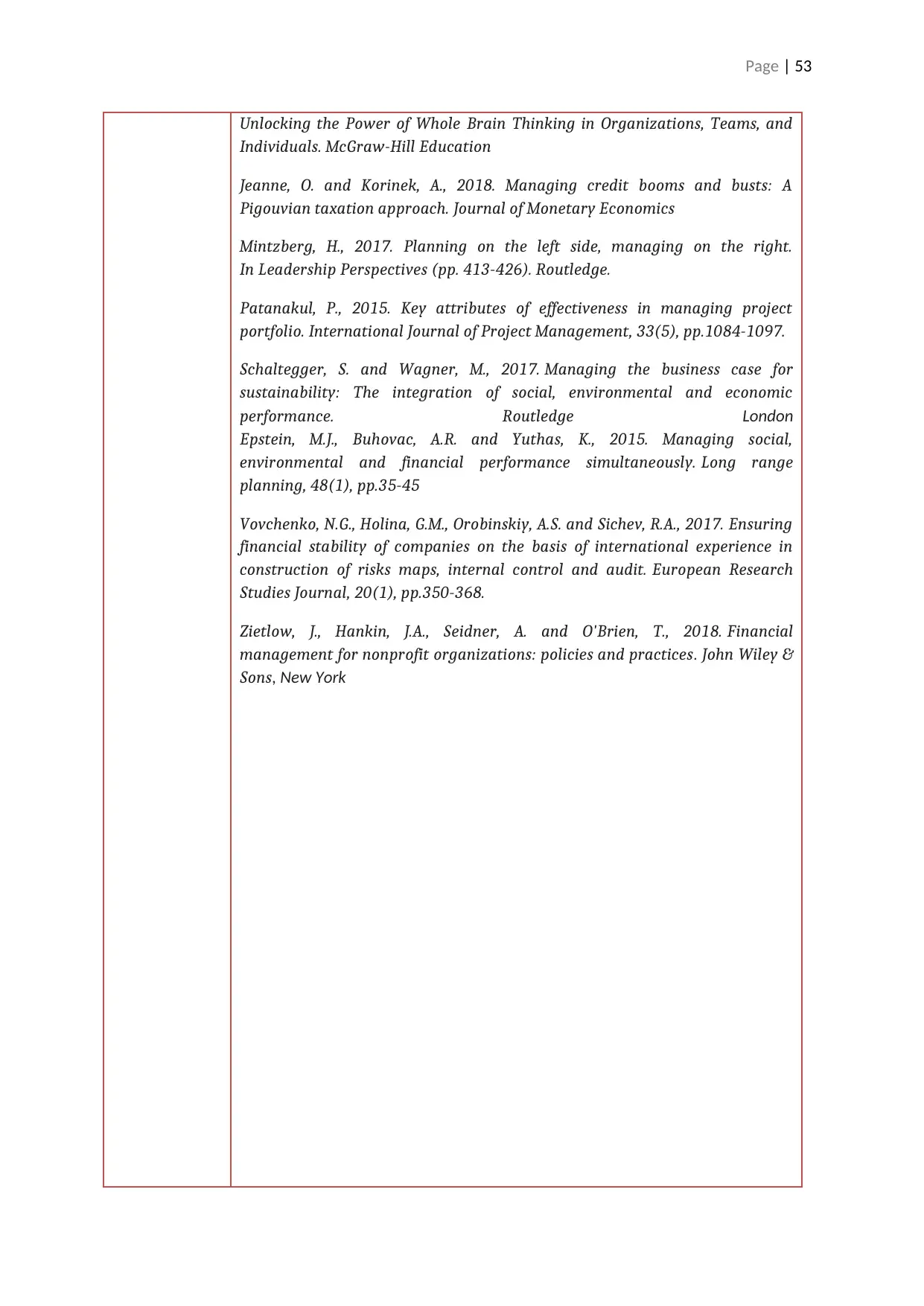
Page | 53
Unlocking the Power of Whole Brain Thinking in Organizations, Teams, and
Individuals. McGraw-Hill Education
Jeanne, O. and Korinek, A., 2018. Managing credit booms and busts: A
Pigouvian taxation approach. Journal of Monetary Economics
Mintzberg, H., 2017. Planning on the left side, managing on the right.
In Leadership Perspectives (pp. 413-426). Routledge.
Patanakul, P., 2015. Key attributes of effectiveness in managing project
portfolio. International Journal of Project Management, 33(5), pp.1084-1097.
Schaltegger, S. and Wagner, M., 2017. Managing the business case for
sustainability: The integration of social, environmental and economic
performance. Routledge London
Epstein, M.J., Buhovac, A.R. and Yuthas, K., 2015. Managing social,
environmental and financial performance simultaneously. Long range
planning, 48(1), pp.35-45
Vovchenko, N.G., Holina, G.M., Orobinskiy, A.S. and Sichev, R.A., 2017. Ensuring
financial stability of companies on the basis of international experience in
construction of risks maps, internal control and audit. European Research
Studies Journal, 20(1), pp.350-368.
Zietlow, J., Hankin, J.A., Seidner, A. and O'Brien, T., 2018. Financial
management for nonprofit organizations: policies and practices. John Wiley &
Sons, New York
Unlocking the Power of Whole Brain Thinking in Organizations, Teams, and
Individuals. McGraw-Hill Education
Jeanne, O. and Korinek, A., 2018. Managing credit booms and busts: A
Pigouvian taxation approach. Journal of Monetary Economics
Mintzberg, H., 2017. Planning on the left side, managing on the right.
In Leadership Perspectives (pp. 413-426). Routledge.
Patanakul, P., 2015. Key attributes of effectiveness in managing project
portfolio. International Journal of Project Management, 33(5), pp.1084-1097.
Schaltegger, S. and Wagner, M., 2017. Managing the business case for
sustainability: The integration of social, environmental and economic
performance. Routledge London
Epstein, M.J., Buhovac, A.R. and Yuthas, K., 2015. Managing social,
environmental and financial performance simultaneously. Long range
planning, 48(1), pp.35-45
Vovchenko, N.G., Holina, G.M., Orobinskiy, A.S. and Sichev, R.A., 2017. Ensuring
financial stability of companies on the basis of international experience in
construction of risks maps, internal control and audit. European Research
Studies Journal, 20(1), pp.350-368.
Zietlow, J., Hankin, J.A., Seidner, A. and O'Brien, T., 2018. Financial
management for nonprofit organizations: policies and practices. John Wiley &
Sons, New York
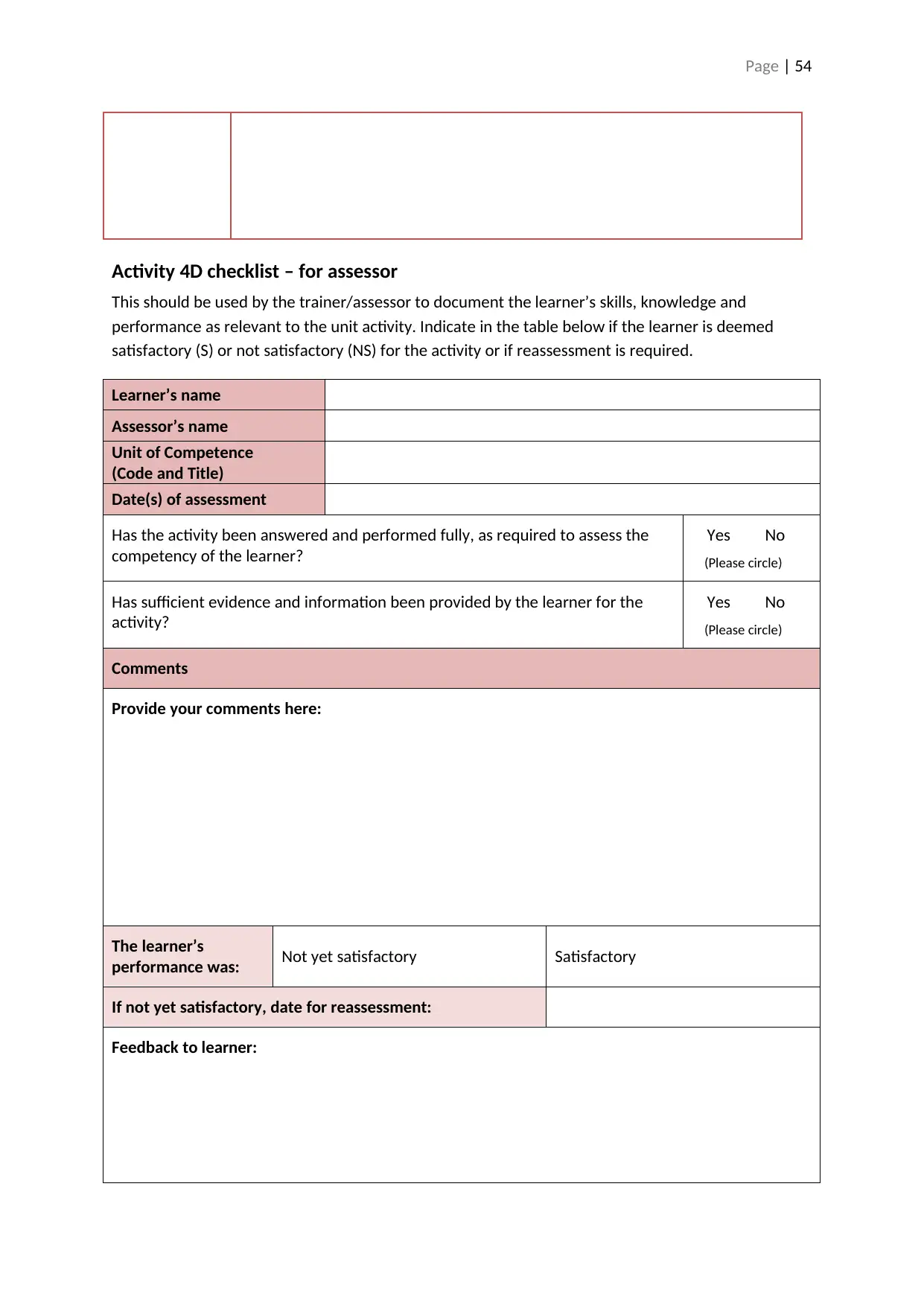
Page | 54
Activity 4D checklist – for assessor
This should be used by the trainer/assessor to document the learner’s skills, knowledge and
performance as relevant to the unit activity. Indicate in the table below if the learner is deemed
satisfactory (S) or not satisfactory (NS) for the activity or if reassessment is required.
Learner’s name
Assessor’s name
Unit of Competence
(Code and Title)
Date(s) of assessment
Has the activity been answered and performed fully, as required to assess the
competency of the learner?
Yes No
(Please circle)
Has sufficient evidence and information been provided by the learner for the
activity?
Yes No
(Please circle)
Comments
Provide your comments here:
The learner’s
performance was: Not yet satisfactory Satisfactory
If not yet satisfactory, date for reassessment:
Feedback to learner:
Activity 4D checklist – for assessor
This should be used by the trainer/assessor to document the learner’s skills, knowledge and
performance as relevant to the unit activity. Indicate in the table below if the learner is deemed
satisfactory (S) or not satisfactory (NS) for the activity or if reassessment is required.
Learner’s name
Assessor’s name
Unit of Competence
(Code and Title)
Date(s) of assessment
Has the activity been answered and performed fully, as required to assess the
competency of the learner?
Yes No
(Please circle)
Has sufficient evidence and information been provided by the learner for the
activity?
Yes No
(Please circle)
Comments
Provide your comments here:
The learner’s
performance was: Not yet satisfactory Satisfactory
If not yet satisfactory, date for reassessment:
Feedback to learner:
Paraphrase This Document
Need a fresh take? Get an instant paraphrase of this document with our AI Paraphraser
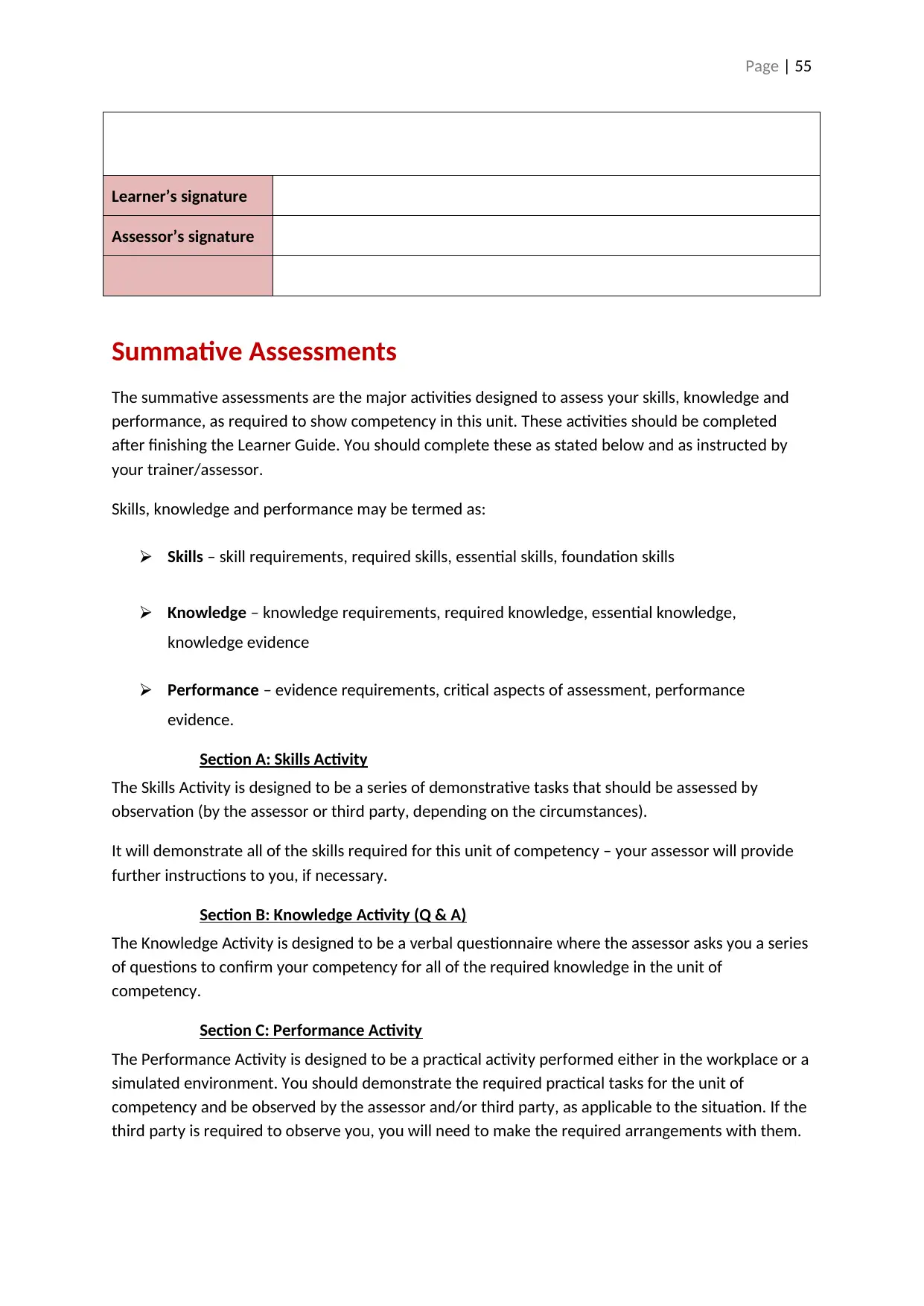
Page | 55
Learner’s signature
Assessor’s signature
Summative Assessments
The summative assessments are the major activities designed to assess your skills, knowledge and
performance, as required to show competency in this unit. These activities should be completed
after finishing the Learner Guide. You should complete these as stated below and as instructed by
your trainer/assessor.
Skills, knowledge and performance may be termed as:
⮚ Skills – skill requirements, required skills, essential skills, foundation skills
⮚ Knowledge – knowledge requirements, required knowledge, essential knowledge,
knowledge evidence
⮚ Performance – evidence requirements, critical aspects of assessment, performance
evidence.
Section A: Skills Activity
The Skills Activity is designed to be a series of demonstrative tasks that should be assessed by
observation (by the assessor or third party, depending on the circumstances).
It will demonstrate all of the skills required for this unit of competency – your assessor will provide
further instructions to you, if necessary.
Section B: Knowledge Activity (Q & A)
The Knowledge Activity is designed to be a verbal questionnaire where the assessor asks you a series
of questions to confirm your competency for all of the required knowledge in the unit of
competency.
Section C: Performance Activity
The Performance Activity is designed to be a practical activity performed either in the workplace or a
simulated environment. You should demonstrate the required practical tasks for the unit of
competency and be observed by the assessor and/or third party, as applicable to the situation. If the
third party is required to observe you, you will need to make the required arrangements with them.
Learner’s signature
Assessor’s signature
Summative Assessments
The summative assessments are the major activities designed to assess your skills, knowledge and
performance, as required to show competency in this unit. These activities should be completed
after finishing the Learner Guide. You should complete these as stated below and as instructed by
your trainer/assessor.
Skills, knowledge and performance may be termed as:
⮚ Skills – skill requirements, required skills, essential skills, foundation skills
⮚ Knowledge – knowledge requirements, required knowledge, essential knowledge,
knowledge evidence
⮚ Performance – evidence requirements, critical aspects of assessment, performance
evidence.
Section A: Skills Activity
The Skills Activity is designed to be a series of demonstrative tasks that should be assessed by
observation (by the assessor or third party, depending on the circumstances).
It will demonstrate all of the skills required for this unit of competency – your assessor will provide
further instructions to you, if necessary.
Section B: Knowledge Activity (Q & A)
The Knowledge Activity is designed to be a verbal questionnaire where the assessor asks you a series
of questions to confirm your competency for all of the required knowledge in the unit of
competency.
Section C: Performance Activity
The Performance Activity is designed to be a practical activity performed either in the workplace or a
simulated environment. You should demonstrate the required practical tasks for the unit of
competency and be observed by the assessor and/or third party, as applicable to the situation. If the
third party is required to observe you, you will need to make the required arrangements with them.

Page | 56
If necessary for the activities, you should attach completed written answers, portfolios or any
evidence of competency to this workbook.
If necessary for the activities, you should attach completed written answers, portfolios or any
evidence of competency to this workbook.

Page | 57
Section A: Skills Activity
Objective: To provide you with an opportunity to show you have the required skills for this unit.
A signed observation by either an approved third party or the assessor will need to be included in
this activity as proof of completion.
This activity will enable you to demonstrate the following skills:
⮚ Reading
⮚ Writing
⮚ Oral Communication
⮚ Numeracy
⮚ Navigate the world of work
⮚ Interact with others
⮚ Get the work done
Answer the activity in as much detail as possible, considering your organisational requirements.
1. Evaluate whether your organisation is adhering to legislative requirements. What proof can
you find to suggest they are or are not meeting legislative needs?
2. Create a document which provides an analysis of factual and forecasted information. Your
document should be prepared using the format, content and layout most appropriate to the
audience and purpose of the document.
3. Demonstrate your oral communication skills by explaining financial decisions and outcomes
clearly and using listening and questioning techniques to exchange information and obtain
agreement. For example, you may host a meeting, talk via a video conference or have a one-
to-one discussion with someone.
4. Describe a time when you have used your numerical skills. Provide details of the calculations,
to show how you have either:
⮚ Reviewed and analysed numerical data embedded in organisational documentation and
legislation; or
⮚ Compared and contrasted complex numerical data to analyse and evaluate financial
position and processes; or
⮚ Used appropriate formulae to analyse financial data to assess and manage risk and
identify discrepancies.
5. Outline a task you have completed (which is part of your work role) where you have
recognised, understood and adhered to legislative and organisational requirements.
Section A: Skills Activity
Objective: To provide you with an opportunity to show you have the required skills for this unit.
A signed observation by either an approved third party or the assessor will need to be included in
this activity as proof of completion.
This activity will enable you to demonstrate the following skills:
⮚ Reading
⮚ Writing
⮚ Oral Communication
⮚ Numeracy
⮚ Navigate the world of work
⮚ Interact with others
⮚ Get the work done
Answer the activity in as much detail as possible, considering your organisational requirements.
1. Evaluate whether your organisation is adhering to legislative requirements. What proof can
you find to suggest they are or are not meeting legislative needs?
2. Create a document which provides an analysis of factual and forecasted information. Your
document should be prepared using the format, content and layout most appropriate to the
audience and purpose of the document.
3. Demonstrate your oral communication skills by explaining financial decisions and outcomes
clearly and using listening and questioning techniques to exchange information and obtain
agreement. For example, you may host a meeting, talk via a video conference or have a one-
to-one discussion with someone.
4. Describe a time when you have used your numerical skills. Provide details of the calculations,
to show how you have either:
⮚ Reviewed and analysed numerical data embedded in organisational documentation and
legislation; or
⮚ Compared and contrasted complex numerical data to analyse and evaluate financial
position and processes; or
⮚ Used appropriate formulae to analyse financial data to assess and manage risk and
identify discrepancies.
5. Outline a task you have completed (which is part of your work role) where you have
recognised, understood and adhered to legislative and organisational requirements.
Secure Best Marks with AI Grader
Need help grading? Try our AI Grader for instant feedback on your assignments.

Page | 58
6. Describe a protocol which is in place in your organisation (and you have used), to
communicate with supervisors and managers to share information or seek agreement.
7. Give a demonstration to a supervisor or assessor on how to use a range of digital technology
to access, filter, compile, integrate and logically present complex information from multiple
sources. What new digital technologies and applications are available (or soon to be available)
to manage and manipulate data?
6. Describe a protocol which is in place in your organisation (and you have used), to
communicate with supervisors and managers to share information or seek agreement.
7. Give a demonstration to a supervisor or assessor on how to use a range of digital technology
to access, filter, compile, integrate and logically present complex information from multiple
sources. What new digital technologies and applications are available (or soon to be available)
to manage and manipulate data?
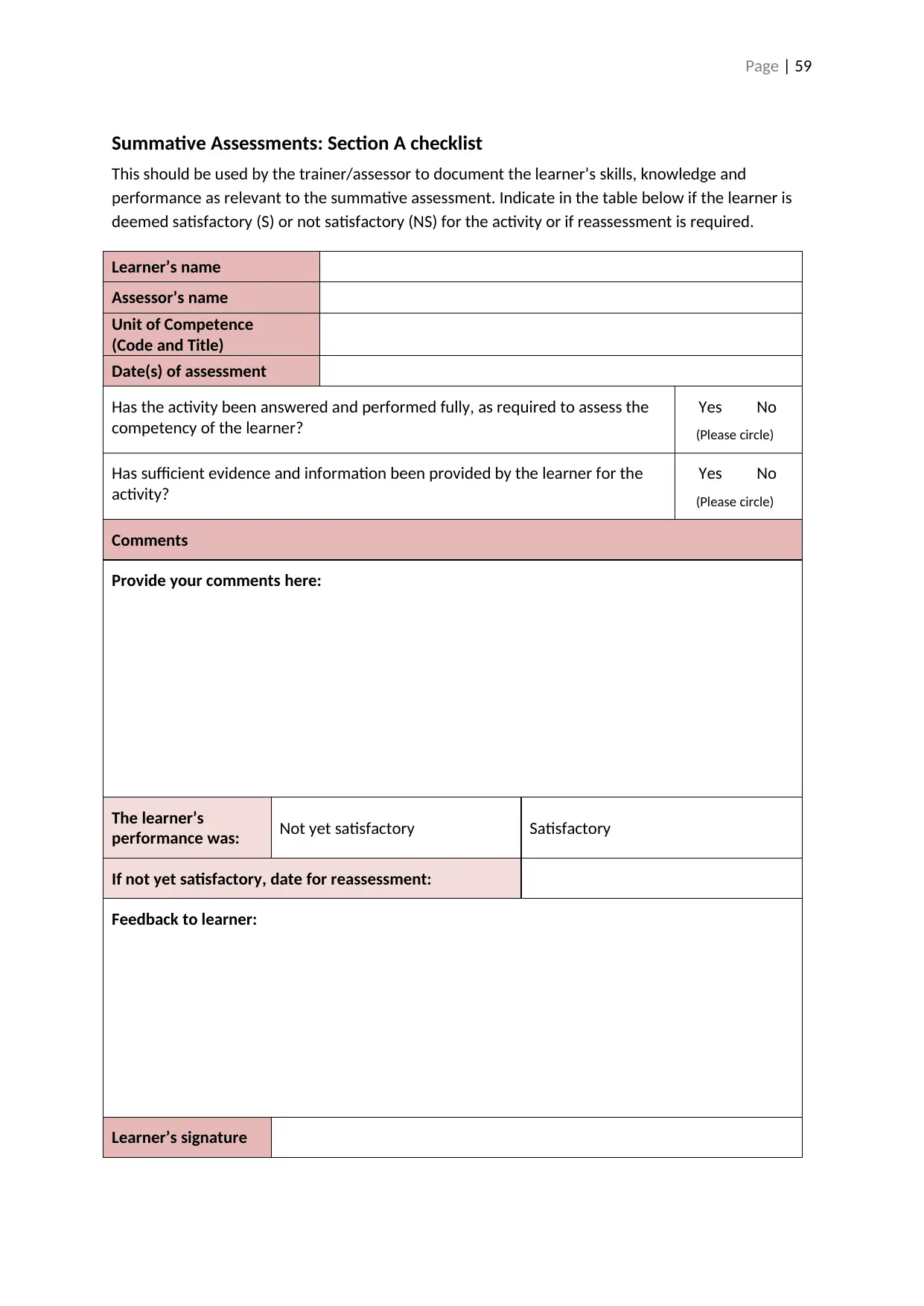
Page | 59
Summative Assessments: Section A checklist
This should be used by the trainer/assessor to document the learner’s skills, knowledge and
performance as relevant to the summative assessment. Indicate in the table below if the learner is
deemed satisfactory (S) or not satisfactory (NS) for the activity or if reassessment is required.
Learner’s name
Assessor’s name
Unit of Competence
(Code and Title)
Date(s) of assessment
Has the activity been answered and performed fully, as required to assess the
competency of the learner?
Yes No
(Please circle)
Has sufficient evidence and information been provided by the learner for the
activity?
Yes No
(Please circle)
Comments
Provide your comments here:
The learner’s
performance was: Not yet satisfactory Satisfactory
If not yet satisfactory, date for reassessment:
Feedback to learner:
Learner’s signature
Summative Assessments: Section A checklist
This should be used by the trainer/assessor to document the learner’s skills, knowledge and
performance as relevant to the summative assessment. Indicate in the table below if the learner is
deemed satisfactory (S) or not satisfactory (NS) for the activity or if reassessment is required.
Learner’s name
Assessor’s name
Unit of Competence
(Code and Title)
Date(s) of assessment
Has the activity been answered and performed fully, as required to assess the
competency of the learner?
Yes No
(Please circle)
Has sufficient evidence and information been provided by the learner for the
activity?
Yes No
(Please circle)
Comments
Provide your comments here:
The learner’s
performance was: Not yet satisfactory Satisfactory
If not yet satisfactory, date for reassessment:
Feedback to learner:
Learner’s signature
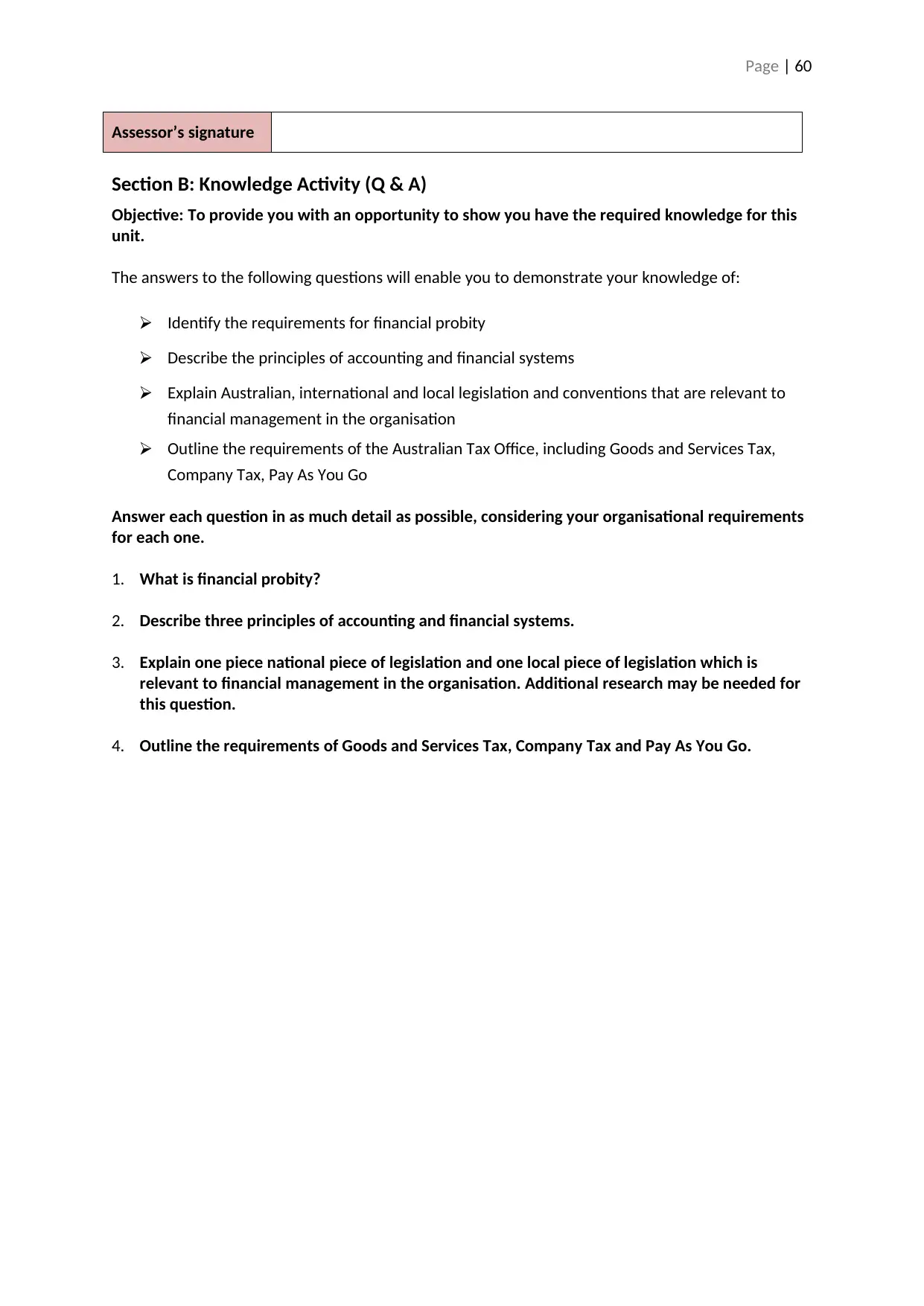
Page | 60
Assessor’s signature
Section B: Knowledge Activity (Q & A)
Objective: To provide you with an opportunity to show you have the required knowledge for this
unit.
The answers to the following questions will enable you to demonstrate your knowledge of:
⮚ Identify the requirements for financial probity
⮚ Describe the principles of accounting and financial systems
⮚ Explain Australian, international and local legislation and conventions that are relevant to
financial management in the organisation
⮚ Outline the requirements of the Australian Tax Office, including Goods and Services Tax,
Company Tax, Pay As You Go
Answer each question in as much detail as possible, considering your organisational requirements
for each one.
1. What is financial probity?
2. Describe three principles of accounting and financial systems.
3. Explain one piece national piece of legislation and one local piece of legislation which is
relevant to financial management in the organisation. Additional research may be needed for
this question.
4. Outline the requirements of Goods and Services Tax, Company Tax and Pay As You Go.
Assessor’s signature
Section B: Knowledge Activity (Q & A)
Objective: To provide you with an opportunity to show you have the required knowledge for this
unit.
The answers to the following questions will enable you to demonstrate your knowledge of:
⮚ Identify the requirements for financial probity
⮚ Describe the principles of accounting and financial systems
⮚ Explain Australian, international and local legislation and conventions that are relevant to
financial management in the organisation
⮚ Outline the requirements of the Australian Tax Office, including Goods and Services Tax,
Company Tax, Pay As You Go
Answer each question in as much detail as possible, considering your organisational requirements
for each one.
1. What is financial probity?
2. Describe three principles of accounting and financial systems.
3. Explain one piece national piece of legislation and one local piece of legislation which is
relevant to financial management in the organisation. Additional research may be needed for
this question.
4. Outline the requirements of Goods and Services Tax, Company Tax and Pay As You Go.
Paraphrase This Document
Need a fresh take? Get an instant paraphrase of this document with our AI Paraphraser

Page | 61
Summative Assessments: Section B checklist
This should be used by the trainer/assessor to document the learner’s skills, knowledge and
performance as relevant to the summative assessment. Indicate in the table below if the learner is
deemed satisfactory (S) or not satisfactory (NS) for the activity or if reassessment is required.
Learner’s name
Assessor’s name
Unit of Competence
(Code and Title)
Date(s) of assessment
Has the activity been answered and performed fully, as required to assess the
competency of the learner?
Yes No
(Please circle)
Has sufficient evidence and information been provided by the learner for the
activity?
Yes No
(Please circle)
Comments
Provide your comments here:
The learner’s
performance was: Not yet satisfactory Satisfactory
If not yet satisfactory, date for reassessment:
Feedback to learner:
Learner’s signature
Summative Assessments: Section B checklist
This should be used by the trainer/assessor to document the learner’s skills, knowledge and
performance as relevant to the summative assessment. Indicate in the table below if the learner is
deemed satisfactory (S) or not satisfactory (NS) for the activity or if reassessment is required.
Learner’s name
Assessor’s name
Unit of Competence
(Code and Title)
Date(s) of assessment
Has the activity been answered and performed fully, as required to assess the
competency of the learner?
Yes No
(Please circle)
Has sufficient evidence and information been provided by the learner for the
activity?
Yes No
(Please circle)
Comments
Provide your comments here:
The learner’s
performance was: Not yet satisfactory Satisfactory
If not yet satisfactory, date for reassessment:
Feedback to learner:
Learner’s signature
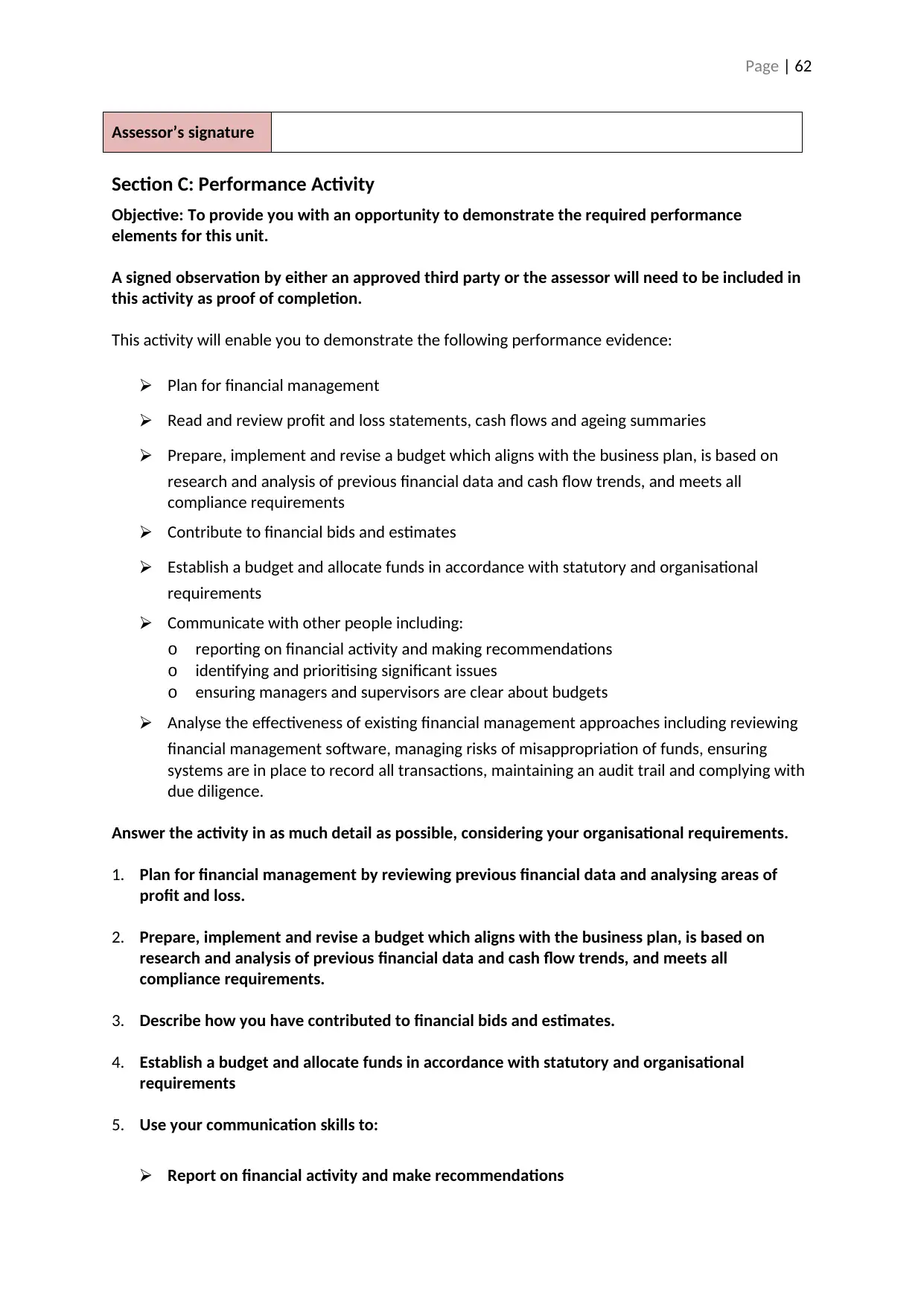
Page | 62
Assessor’s signature
Section C: Performance Activity
Objective: To provide you with an opportunity to demonstrate the required performance
elements for this unit.
A signed observation by either an approved third party or the assessor will need to be included in
this activity as proof of completion.
This activity will enable you to demonstrate the following performance evidence:
⮚ Plan for financial management
⮚ Read and review profit and loss statements, cash flows and ageing summaries
⮚ Prepare, implement and revise a budget which aligns with the business plan, is based on
research and analysis of previous financial data and cash flow trends, and meets all
compliance requirements
⮚ Contribute to financial bids and estimates
⮚ Establish a budget and allocate funds in accordance with statutory and organisational
requirements
⮚ Communicate with other people including:
o reporting on financial activity and making recommendations
o identifying and prioritising significant issues
o ensuring managers and supervisors are clear about budgets
⮚ Analyse the effectiveness of existing financial management approaches including reviewing
financial management software, managing risks of misappropriation of funds, ensuring
systems are in place to record all transactions, maintaining an audit trail and complying with
due diligence.
Answer the activity in as much detail as possible, considering your organisational requirements.
1. Plan for financial management by reviewing previous financial data and analysing areas of
profit and loss.
2. Prepare, implement and revise a budget which aligns with the business plan, is based on
research and analysis of previous financial data and cash flow trends, and meets all
compliance requirements.
3. Describe how you have contributed to financial bids and estimates.
4. Establish a budget and allocate funds in accordance with statutory and organisational
requirements
5. Use your communication skills to:
⮚ Report on financial activity and make recommendations
Assessor’s signature
Section C: Performance Activity
Objective: To provide you with an opportunity to demonstrate the required performance
elements for this unit.
A signed observation by either an approved third party or the assessor will need to be included in
this activity as proof of completion.
This activity will enable you to demonstrate the following performance evidence:
⮚ Plan for financial management
⮚ Read and review profit and loss statements, cash flows and ageing summaries
⮚ Prepare, implement and revise a budget which aligns with the business plan, is based on
research and analysis of previous financial data and cash flow trends, and meets all
compliance requirements
⮚ Contribute to financial bids and estimates
⮚ Establish a budget and allocate funds in accordance with statutory and organisational
requirements
⮚ Communicate with other people including:
o reporting on financial activity and making recommendations
o identifying and prioritising significant issues
o ensuring managers and supervisors are clear about budgets
⮚ Analyse the effectiveness of existing financial management approaches including reviewing
financial management software, managing risks of misappropriation of funds, ensuring
systems are in place to record all transactions, maintaining an audit trail and complying with
due diligence.
Answer the activity in as much detail as possible, considering your organisational requirements.
1. Plan for financial management by reviewing previous financial data and analysing areas of
profit and loss.
2. Prepare, implement and revise a budget which aligns with the business plan, is based on
research and analysis of previous financial data and cash flow trends, and meets all
compliance requirements.
3. Describe how you have contributed to financial bids and estimates.
4. Establish a budget and allocate funds in accordance with statutory and organisational
requirements
5. Use your communication skills to:
⮚ Report on financial activity and make recommendations

Page | 63
⮚ identify and prioritise significant issues
⮚ ensure managers and supervisors are clear about budgets
6. Analyse the effectiveness of existing financial management approaches including reviewing
financial management software, managing risks of misappropriation of funds, ensuring
systems are in place to record all transactions, maintaining an audit trail and complying with
due diligence.
⮚ identify and prioritise significant issues
⮚ ensure managers and supervisors are clear about budgets
6. Analyse the effectiveness of existing financial management approaches including reviewing
financial management software, managing risks of misappropriation of funds, ensuring
systems are in place to record all transactions, maintaining an audit trail and complying with
due diligence.
Secure Best Marks with AI Grader
Need help grading? Try our AI Grader for instant feedback on your assignments.
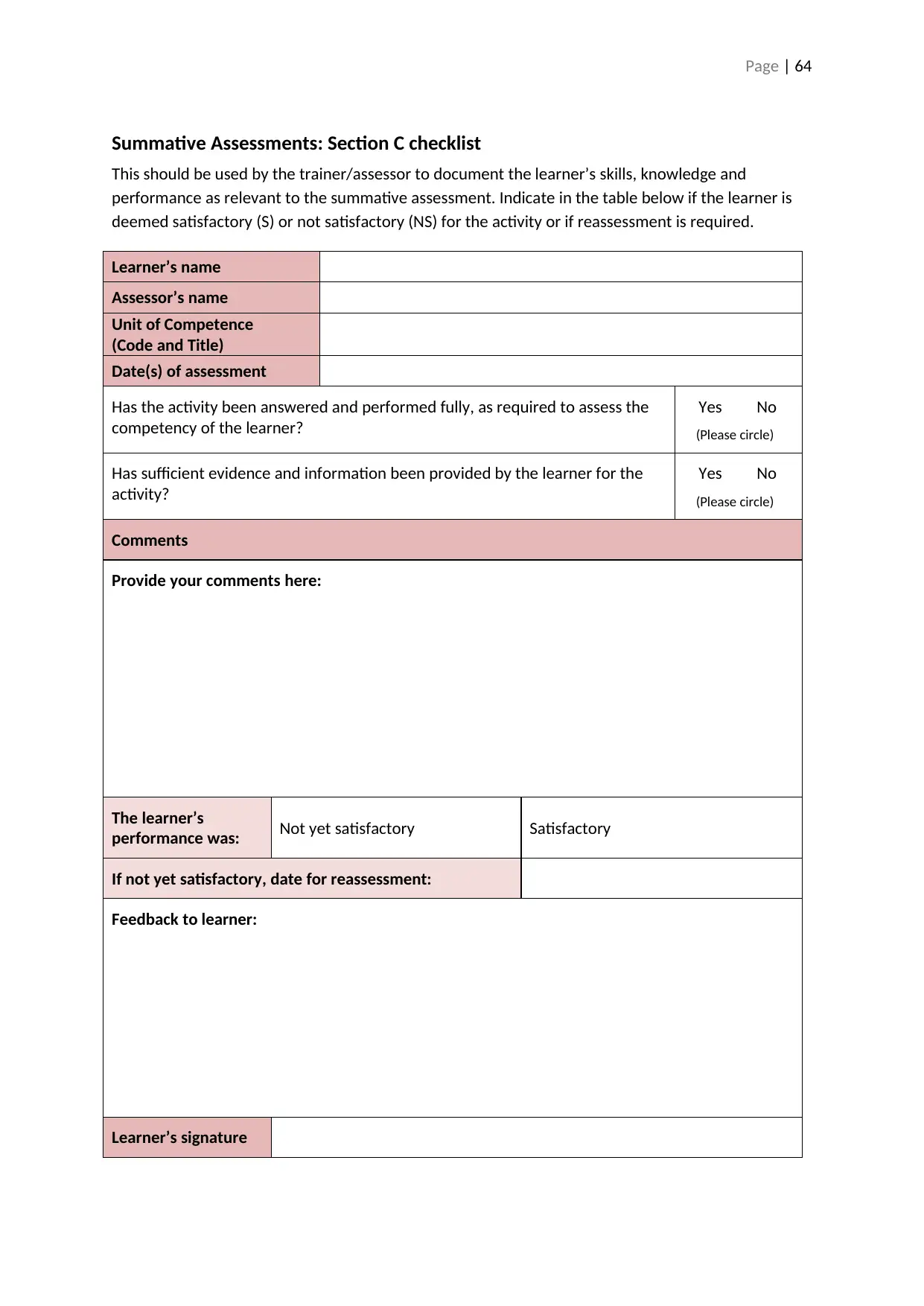
Page | 64
Summative Assessments: Section C checklist
This should be used by the trainer/assessor to document the learner’s skills, knowledge and
performance as relevant to the summative assessment. Indicate in the table below if the learner is
deemed satisfactory (S) or not satisfactory (NS) for the activity or if reassessment is required.
Learner’s name
Assessor’s name
Unit of Competence
(Code and Title)
Date(s) of assessment
Has the activity been answered and performed fully, as required to assess the
competency of the learner?
Yes No
(Please circle)
Has sufficient evidence and information been provided by the learner for the
activity?
Yes No
(Please circle)
Comments
Provide your comments here:
The learner’s
performance was: Not yet satisfactory Satisfactory
If not yet satisfactory, date for reassessment:
Feedback to learner:
Learner’s signature
Summative Assessments: Section C checklist
This should be used by the trainer/assessor to document the learner’s skills, knowledge and
performance as relevant to the summative assessment. Indicate in the table below if the learner is
deemed satisfactory (S) or not satisfactory (NS) for the activity or if reassessment is required.
Learner’s name
Assessor’s name
Unit of Competence
(Code and Title)
Date(s) of assessment
Has the activity been answered and performed fully, as required to assess the
competency of the learner?
Yes No
(Please circle)
Has sufficient evidence and information been provided by the learner for the
activity?
Yes No
(Please circle)
Comments
Provide your comments here:
The learner’s
performance was: Not yet satisfactory Satisfactory
If not yet satisfactory, date for reassessment:
Feedback to learner:
Learner’s signature
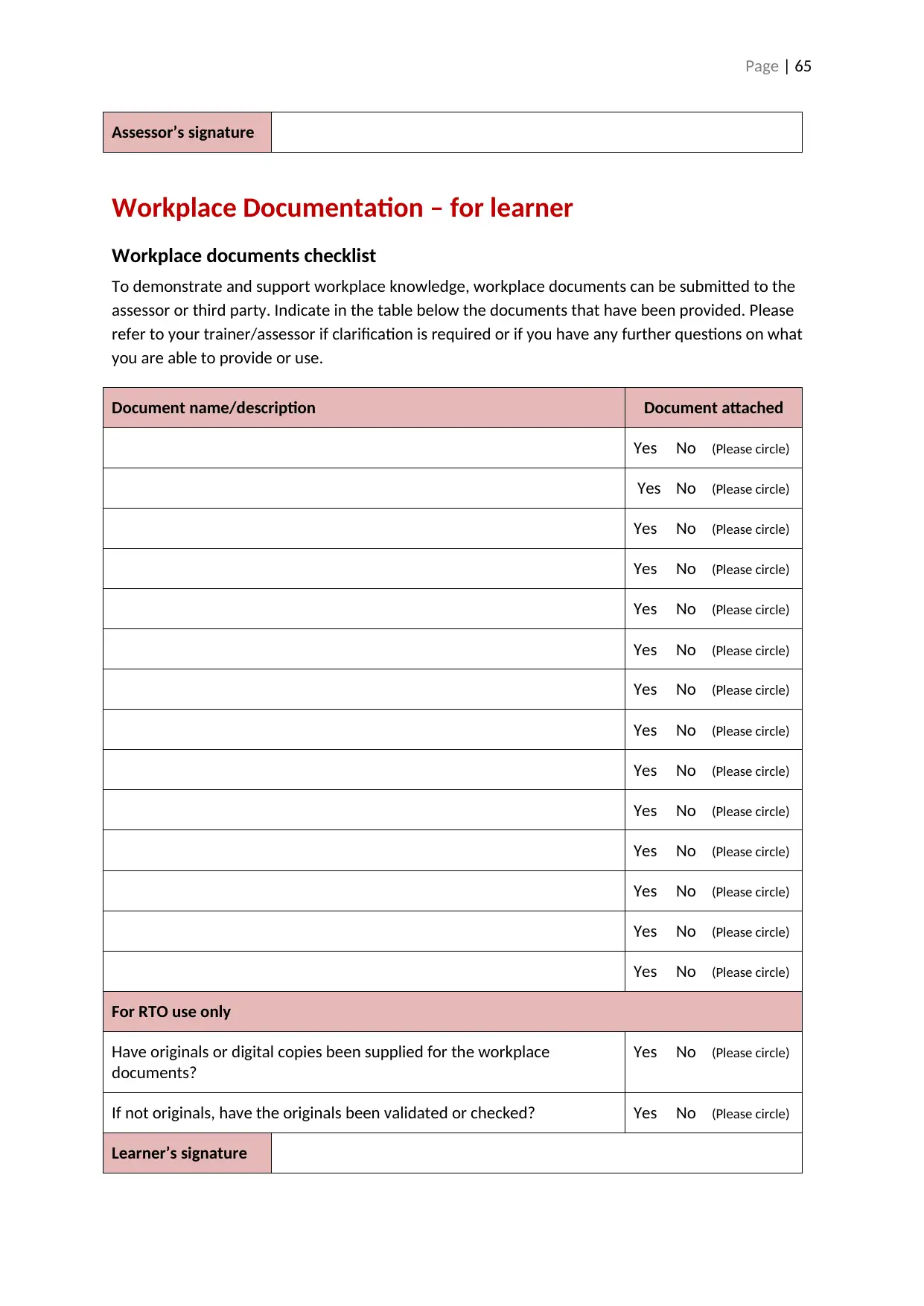
Page | 65
Assessor’s signature
Workplace Documentation – for learner
Workplace documents checklist
To demonstrate and support workplace knowledge, workplace documents can be submitted to the
assessor or third party. Indicate in the table below the documents that have been provided. Please
refer to your trainer/assessor if clarification is required or if you have any further questions on what
you are able to provide or use.
Document name/description Document attached
Yes No (Please circle)
Yes No (Please circle)
Yes No (Please circle)
Yes No (Please circle)
Yes No (Please circle)
Yes No (Please circle)
Yes No (Please circle)
Yes No (Please circle)
Yes No (Please circle)
Yes No (Please circle)
Yes No (Please circle)
Yes No (Please circle)
Yes No (Please circle)
Yes No (Please circle)
For RTO use only
Have originals or digital copies been supplied for the workplace
documents?
Yes No (Please circle)
If not originals, have the originals been validated or checked? Yes No (Please circle)
Learner’s signature
Assessor’s signature
Workplace Documentation – for learner
Workplace documents checklist
To demonstrate and support workplace knowledge, workplace documents can be submitted to the
assessor or third party. Indicate in the table below the documents that have been provided. Please
refer to your trainer/assessor if clarification is required or if you have any further questions on what
you are able to provide or use.
Document name/description Document attached
Yes No (Please circle)
Yes No (Please circle)
Yes No (Please circle)
Yes No (Please circle)
Yes No (Please circle)
Yes No (Please circle)
Yes No (Please circle)
Yes No (Please circle)
Yes No (Please circle)
Yes No (Please circle)
Yes No (Please circle)
Yes No (Please circle)
Yes No (Please circle)
Yes No (Please circle)
For RTO use only
Have originals or digital copies been supplied for the workplace
documents?
Yes No (Please circle)
If not originals, have the originals been validated or checked? Yes No (Please circle)
Learner’s signature
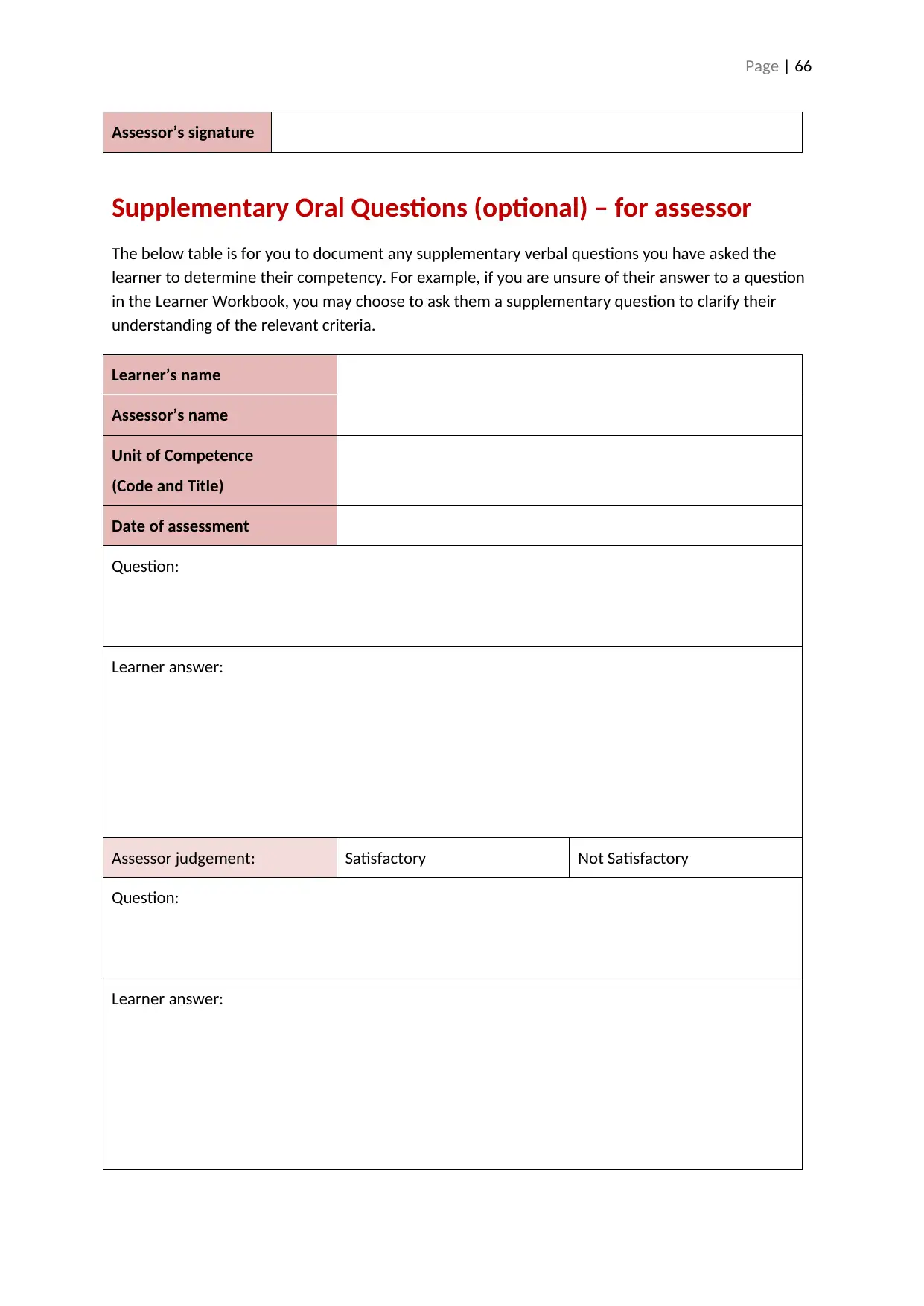
Page | 66
Assessor’s signature
Supplementary Oral Questions (optional) – for assessor
The below table is for you to document any supplementary verbal questions you have asked the
learner to determine their competency. For example, if you are unsure of their answer to a question
in the Learner Workbook, you may choose to ask them a supplementary question to clarify their
understanding of the relevant criteria.
Learner’s name
Assessor’s name
Unit of Competence
(Code and Title)
Date of assessment
Question:
Learner answer:
Assessor judgement: Satisfactory Not Satisfactory
Question:
Learner answer:
Assessor’s signature
Supplementary Oral Questions (optional) – for assessor
The below table is for you to document any supplementary verbal questions you have asked the
learner to determine their competency. For example, if you are unsure of their answer to a question
in the Learner Workbook, you may choose to ask them a supplementary question to clarify their
understanding of the relevant criteria.
Learner’s name
Assessor’s name
Unit of Competence
(Code and Title)
Date of assessment
Question:
Learner answer:
Assessor judgement: Satisfactory Not Satisfactory
Question:
Learner answer:
Paraphrase This Document
Need a fresh take? Get an instant paraphrase of this document with our AI Paraphraser

Page | 67
Assessor judgement: Satisfactory Not Satisfactory
Assessor judgement: Satisfactory Not Satisfactory
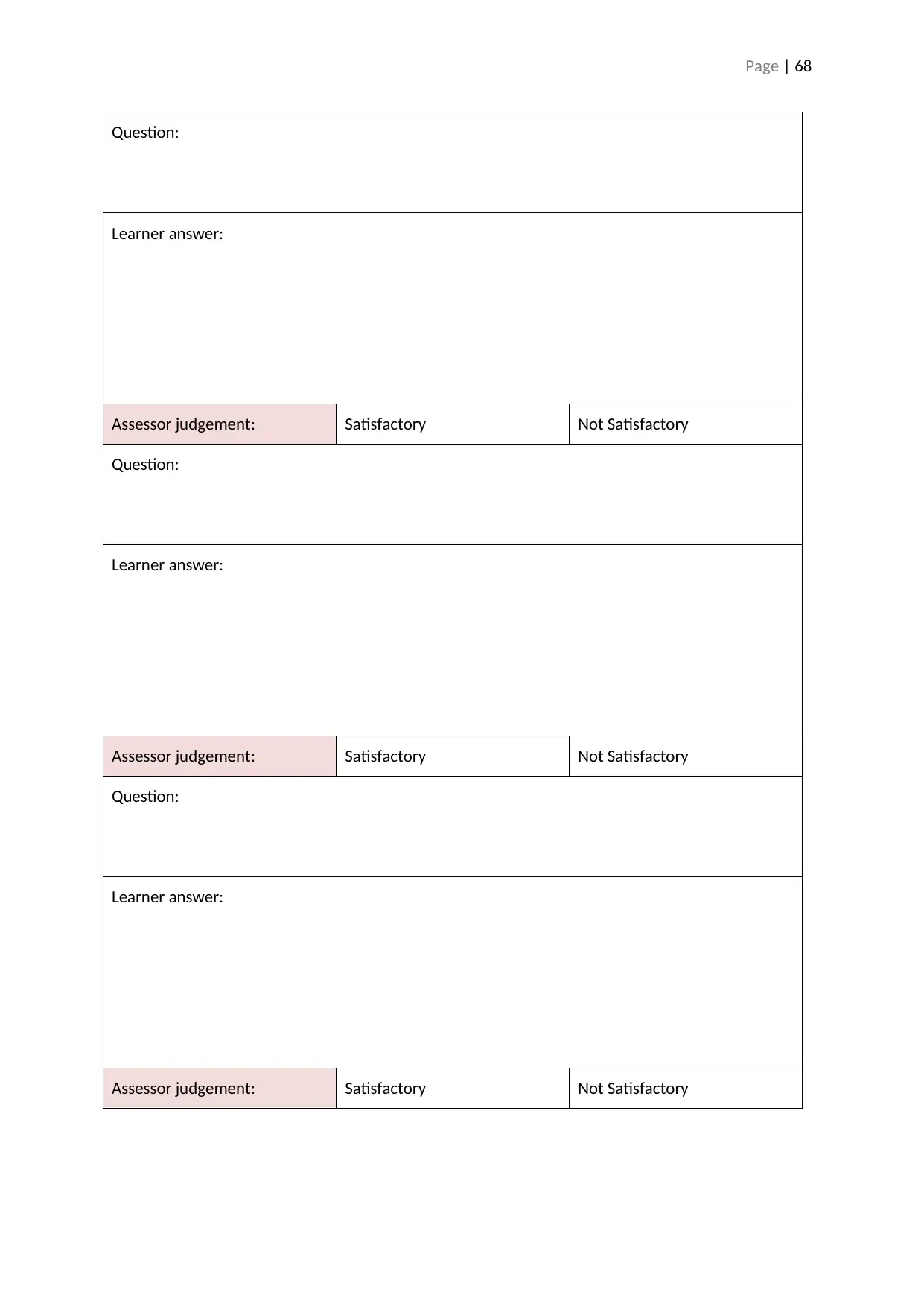
Page | 68
Question:
Learner answer:
Assessor judgement: Satisfactory Not Satisfactory
Question:
Learner answer:
Assessor judgement: Satisfactory Not Satisfactory
Question:
Learner answer:
Assessor judgement: Satisfactory Not Satisfactory
Question:
Learner answer:
Assessor judgement: Satisfactory Not Satisfactory
Question:
Learner answer:
Assessor judgement: Satisfactory Not Satisfactory
Question:
Learner answer:
Assessor judgement: Satisfactory Not Satisfactory
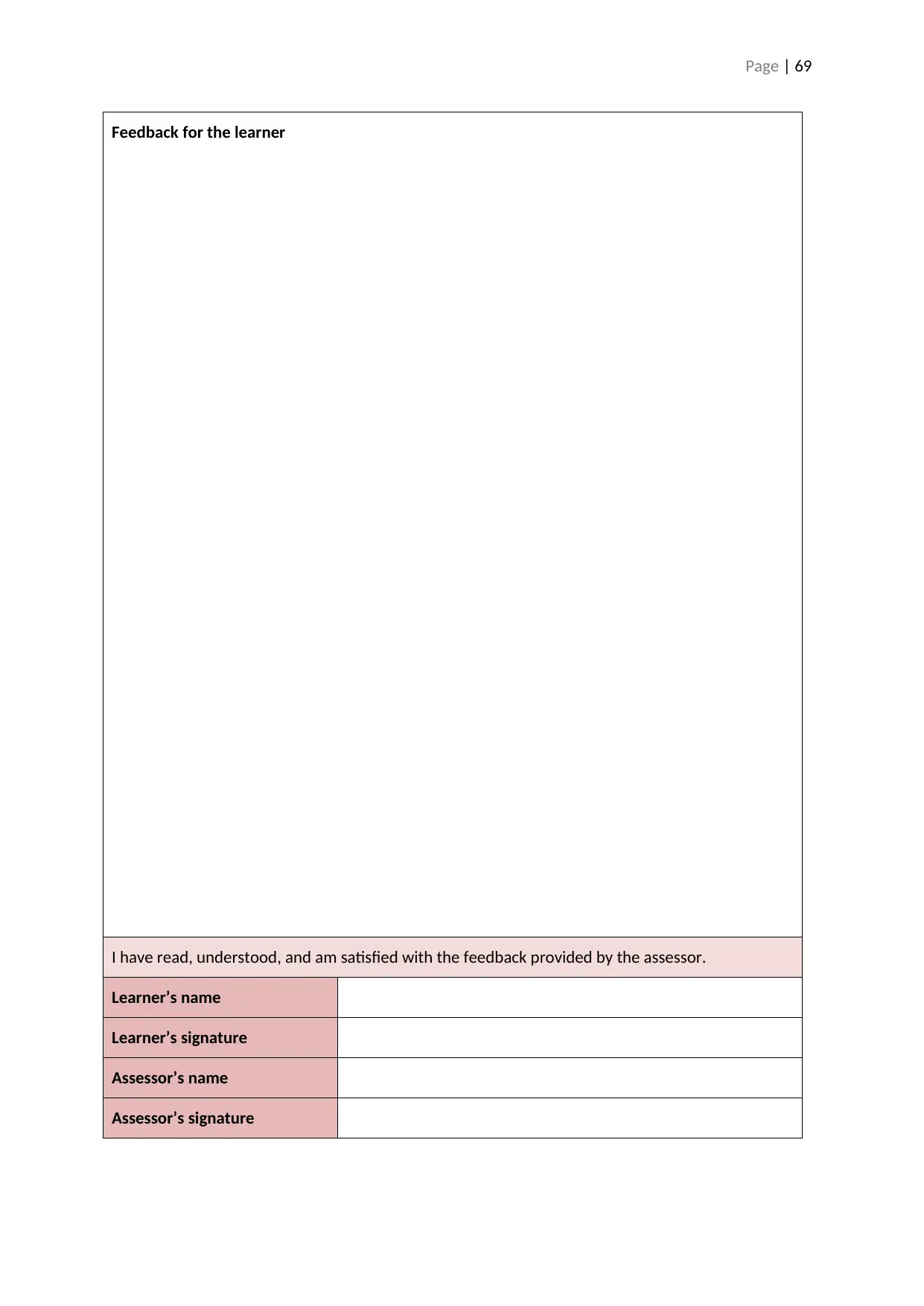
Page | 69
Feedback for the learner
I have read, understood, and am satisfied with the feedback provided by the assessor.
Learner’s name
Learner’s signature
Assessor’s name
Assessor’s signature
Feedback for the learner
I have read, understood, and am satisfied with the feedback provided by the assessor.
Learner’s name
Learner’s signature
Assessor’s name
Assessor’s signature
Secure Best Marks with AI Grader
Need help grading? Try our AI Grader for instant feedback on your assignments.
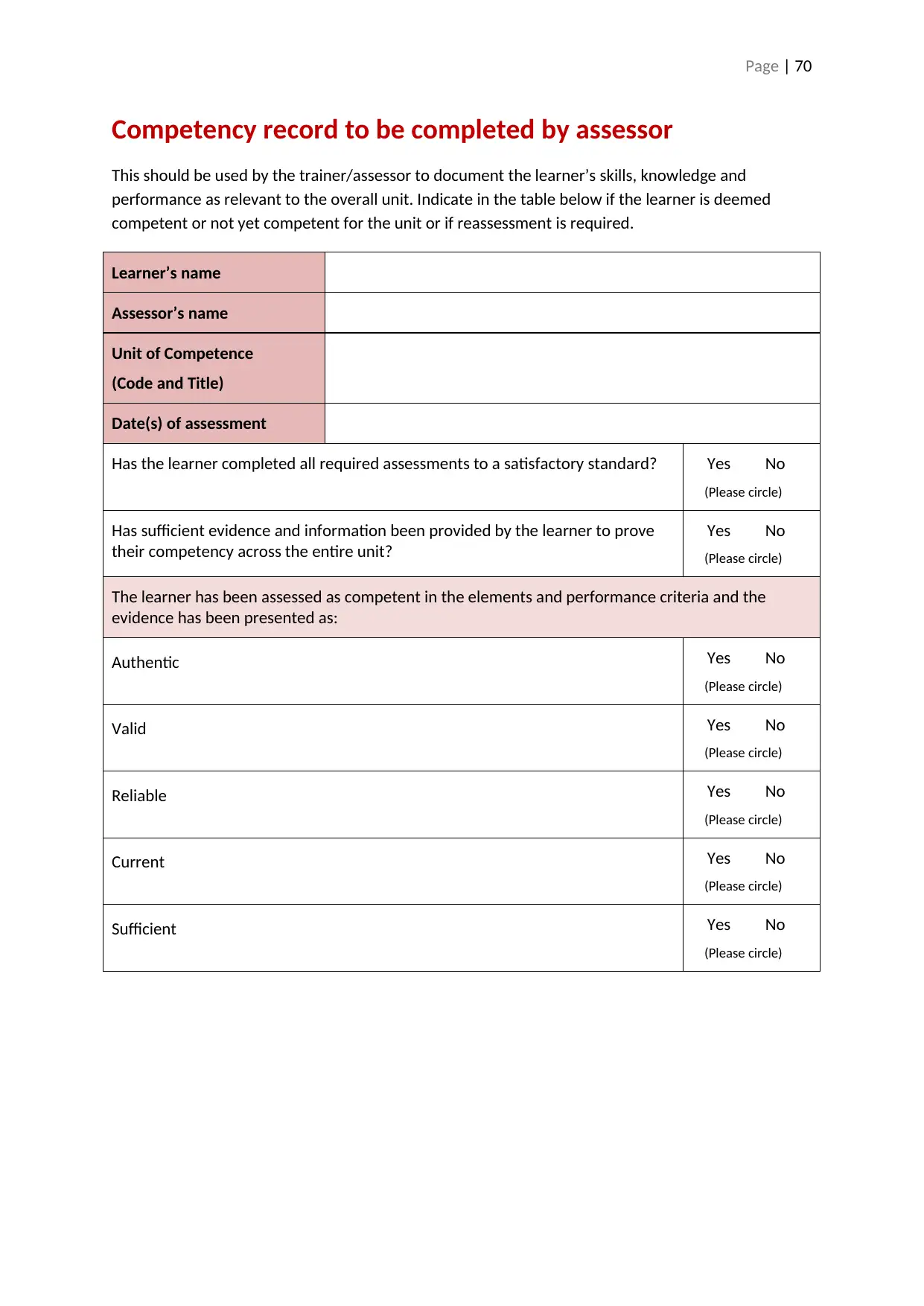
Page | 70
Competency record to be completed by assessor
This should be used by the trainer/assessor to document the learner’s skills, knowledge and
performance as relevant to the overall unit. Indicate in the table below if the learner is deemed
competent or not yet competent for the unit or if reassessment is required.
Learner’s name
Assessor’s name
Unit of Competence
(Code and Title)
Date(s) of assessment
Has the learner completed all required assessments to a satisfactory standard? Yes No
(Please circle)
Has sufficient evidence and information been provided by the learner to prove
their competency across the entire unit?
Yes No
(Please circle)
The learner has been assessed as competent in the elements and performance criteria and the
evidence has been presented as:
Authentic Yes No
(Please circle)
Valid Yes No
(Please circle)
Reliable Yes No
(Please circle)
Current Yes No
(Please circle)
Sufficient Yes No
(Please circle)
Competency record to be completed by assessor
This should be used by the trainer/assessor to document the learner’s skills, knowledge and
performance as relevant to the overall unit. Indicate in the table below if the learner is deemed
competent or not yet competent for the unit or if reassessment is required.
Learner’s name
Assessor’s name
Unit of Competence
(Code and Title)
Date(s) of assessment
Has the learner completed all required assessments to a satisfactory standard? Yes No
(Please circle)
Has sufficient evidence and information been provided by the learner to prove
their competency across the entire unit?
Yes No
(Please circle)
The learner has been assessed as competent in the elements and performance criteria and the
evidence has been presented as:
Authentic Yes No
(Please circle)
Valid Yes No
(Please circle)
Reliable Yes No
(Please circle)
Current Yes No
(Please circle)
Sufficient Yes No
(Please circle)
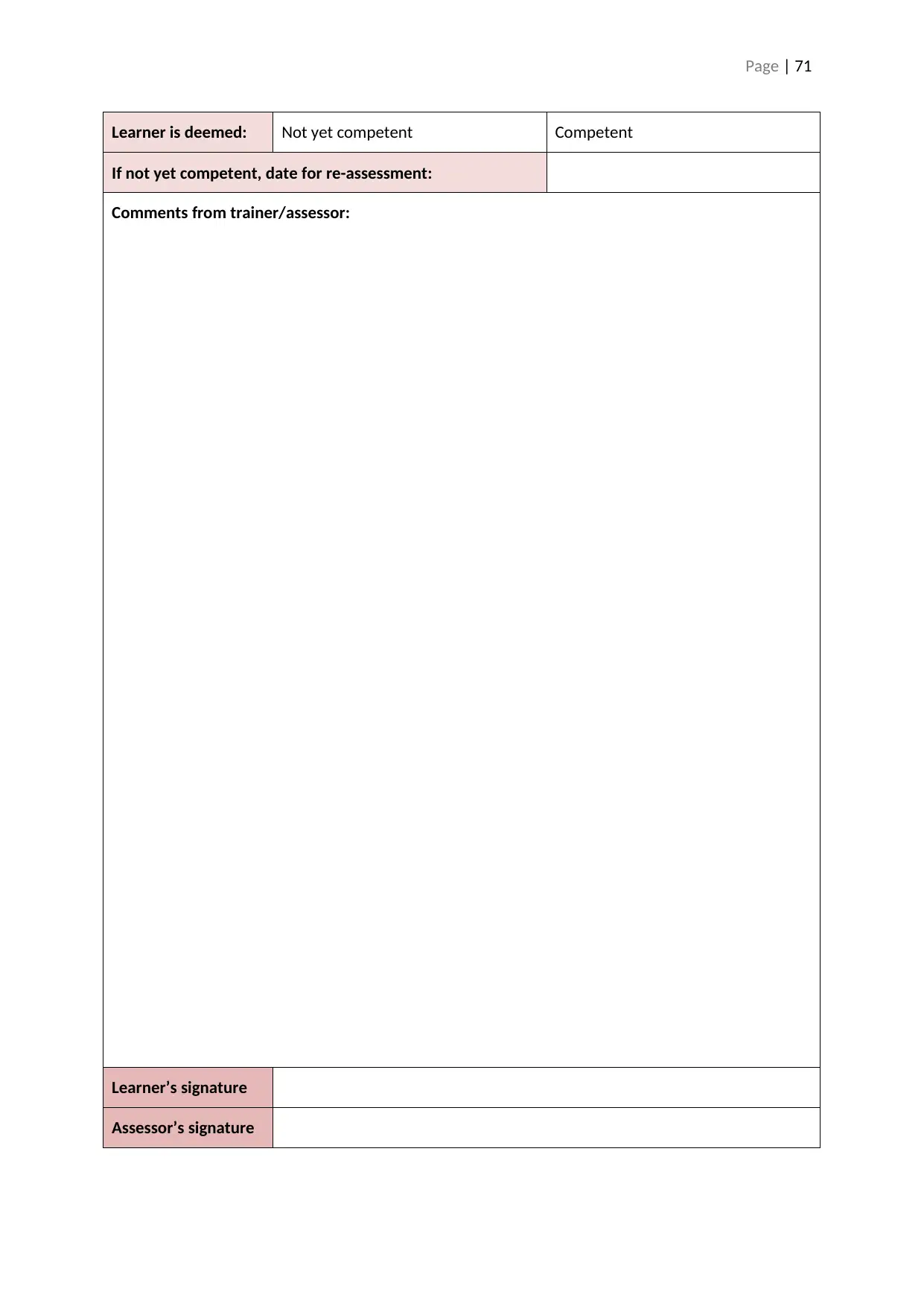
Page | 71
Learner is deemed: Not yet competent Competent
If not yet competent, date for re-assessment:
Comments from trainer/assessor:
Learner’s signature
Assessor’s signature
Learner is deemed: Not yet competent Competent
If not yet competent, date for re-assessment:
Comments from trainer/assessor:
Learner’s signature
Assessor’s signature
1 out of 72
Related Documents
Your All-in-One AI-Powered Toolkit for Academic Success.
+13062052269
info@desklib.com
Available 24*7 on WhatsApp / Email
![[object Object]](/_next/static/media/star-bottom.7253800d.svg)
Unlock your academic potential
© 2024 | Zucol Services PVT LTD | All rights reserved.





